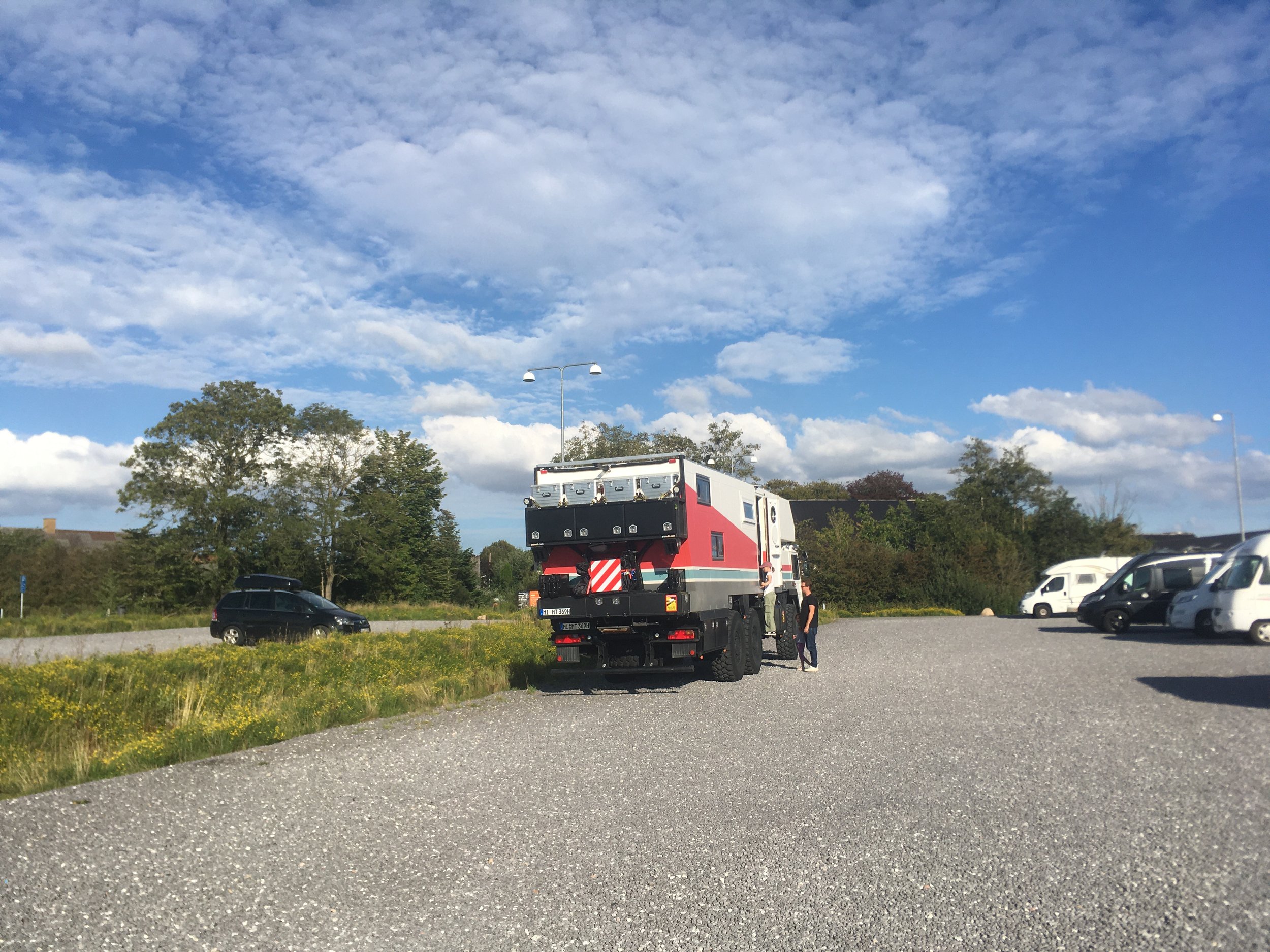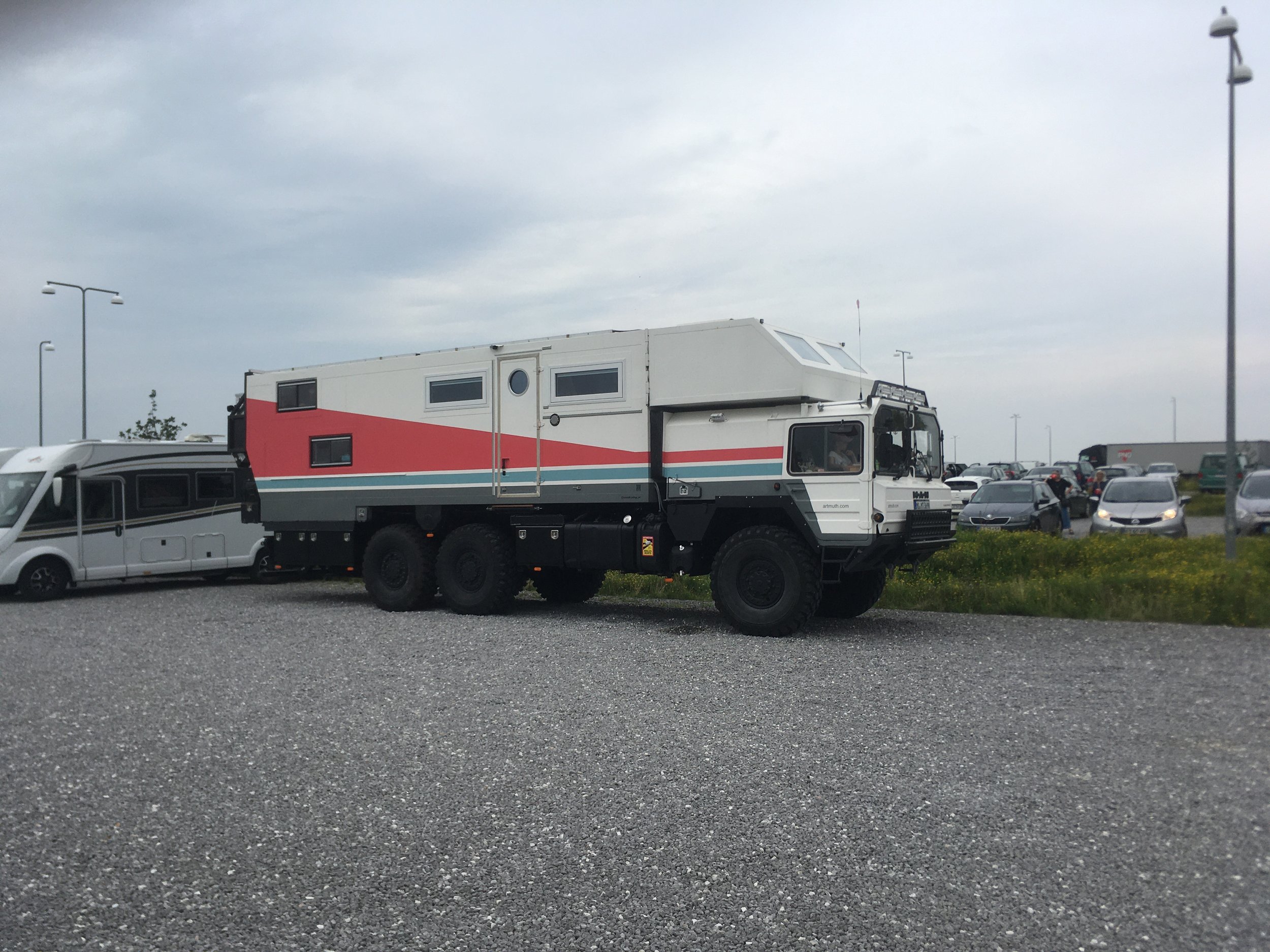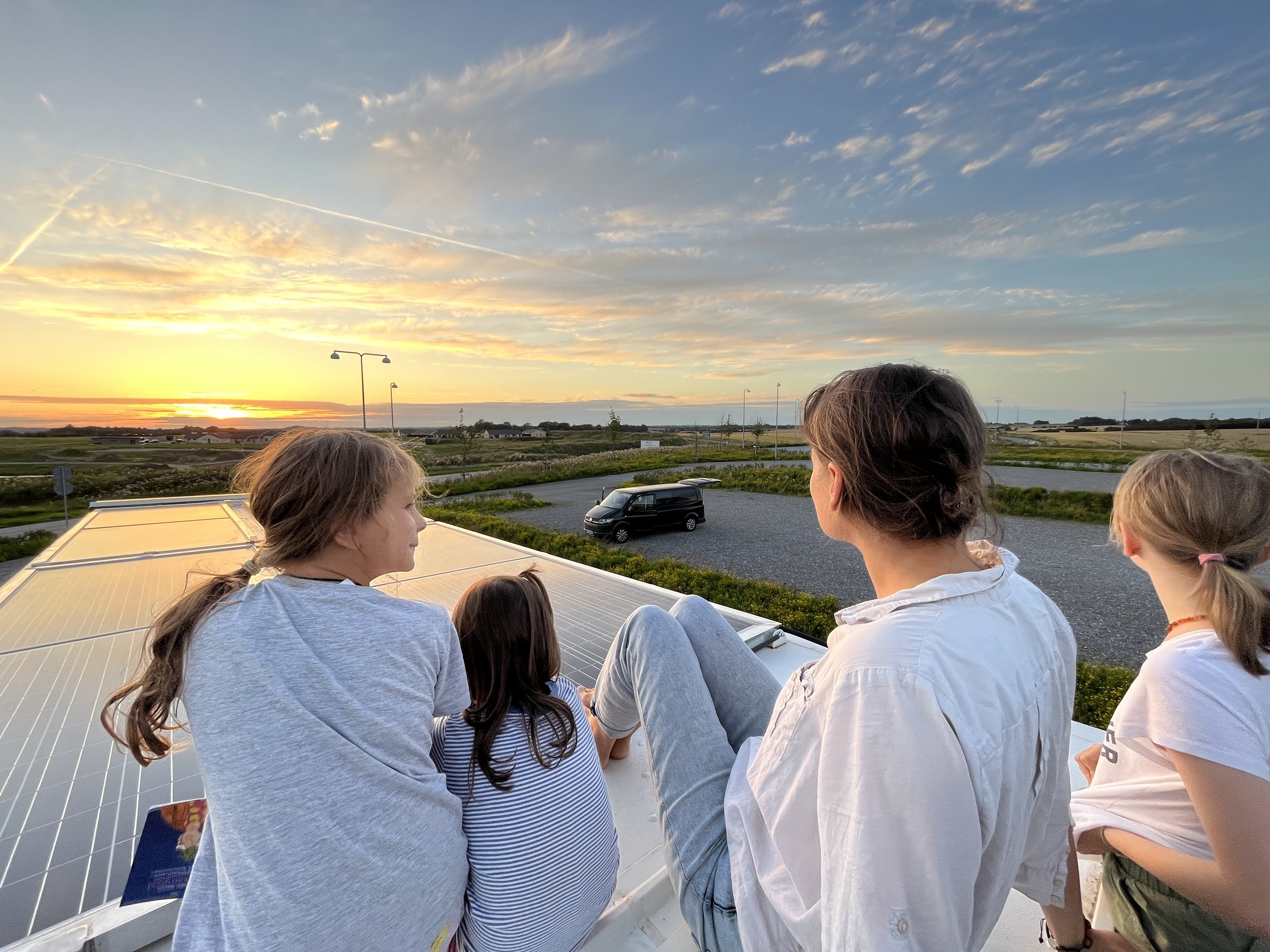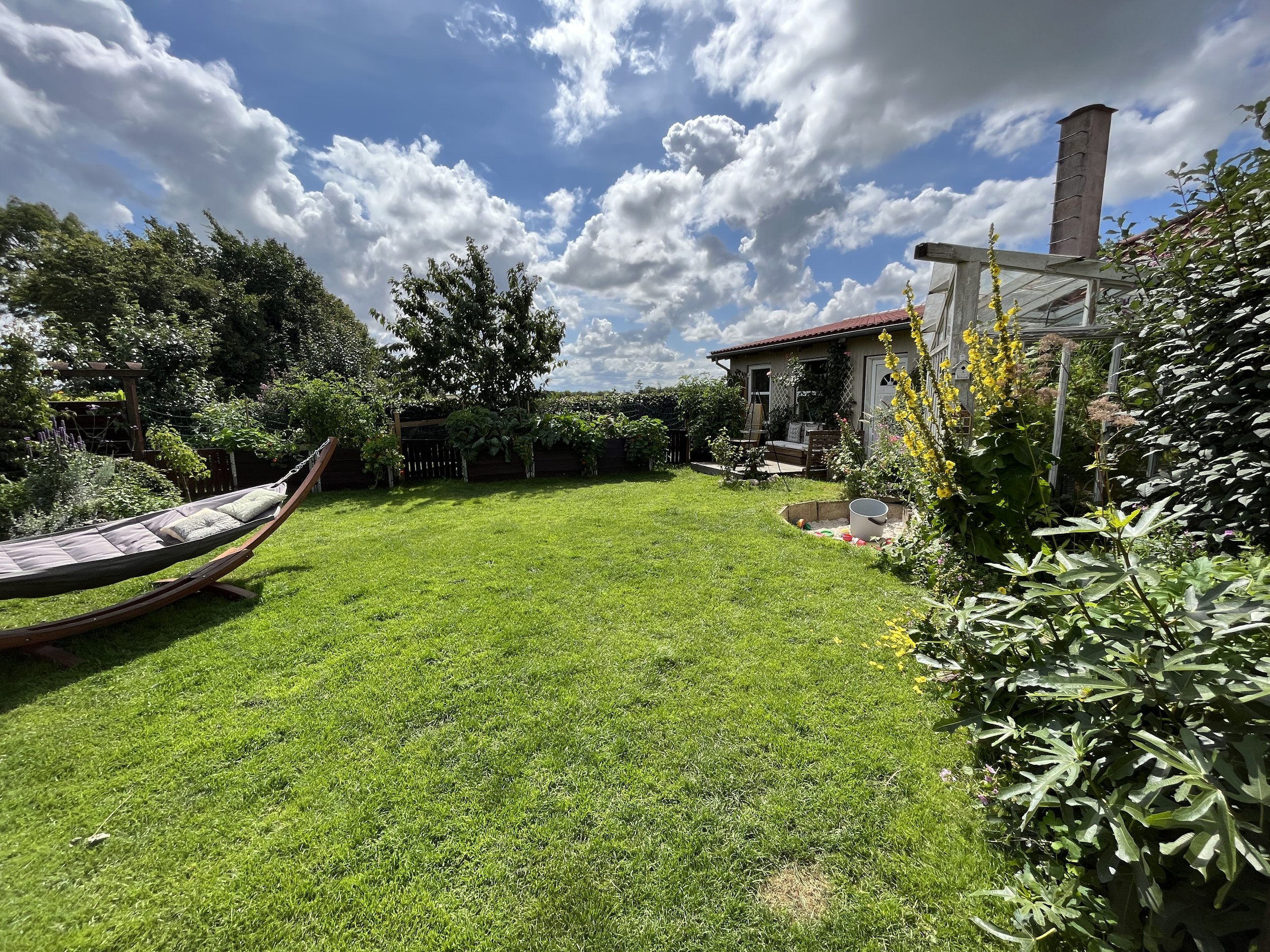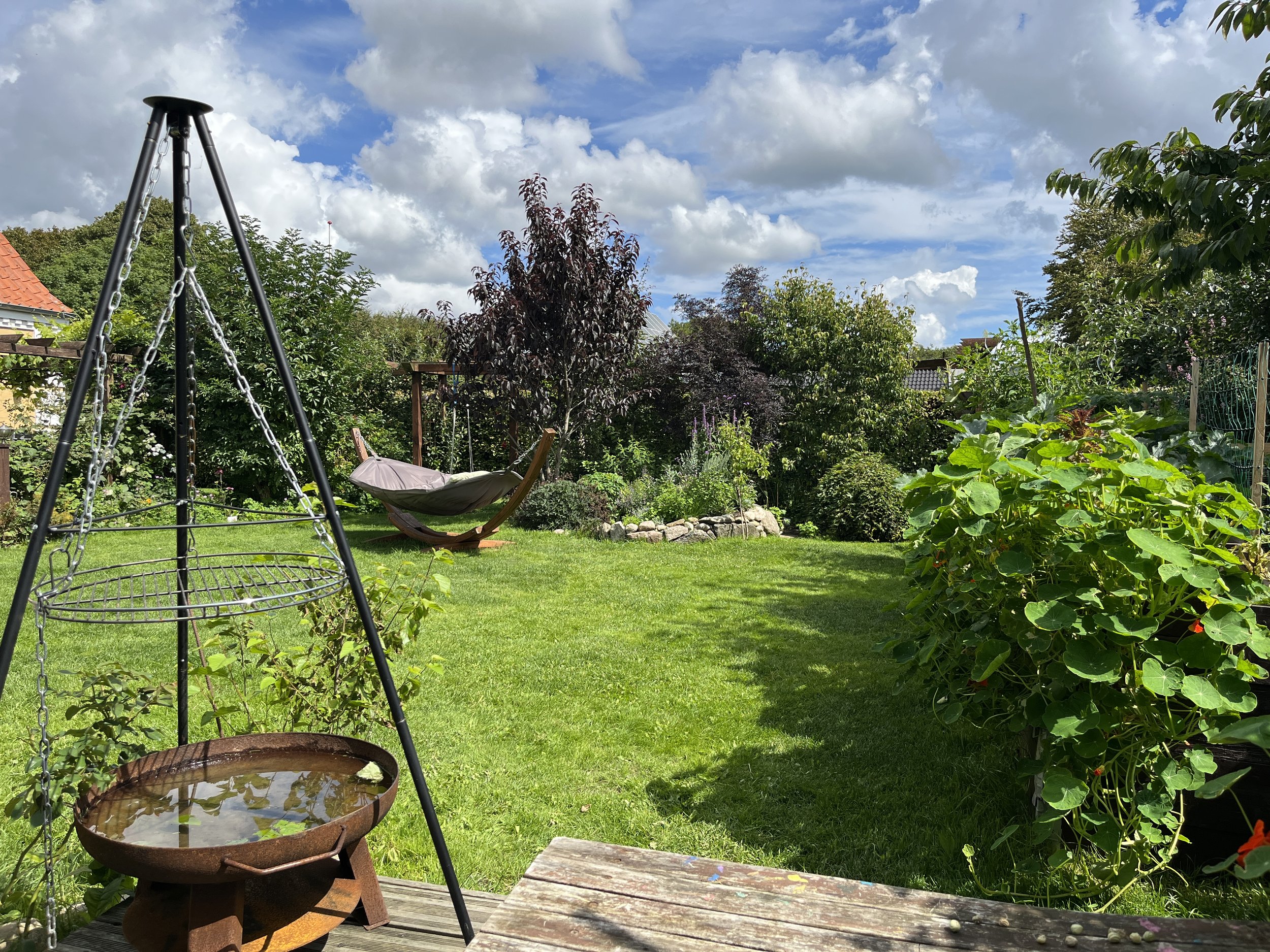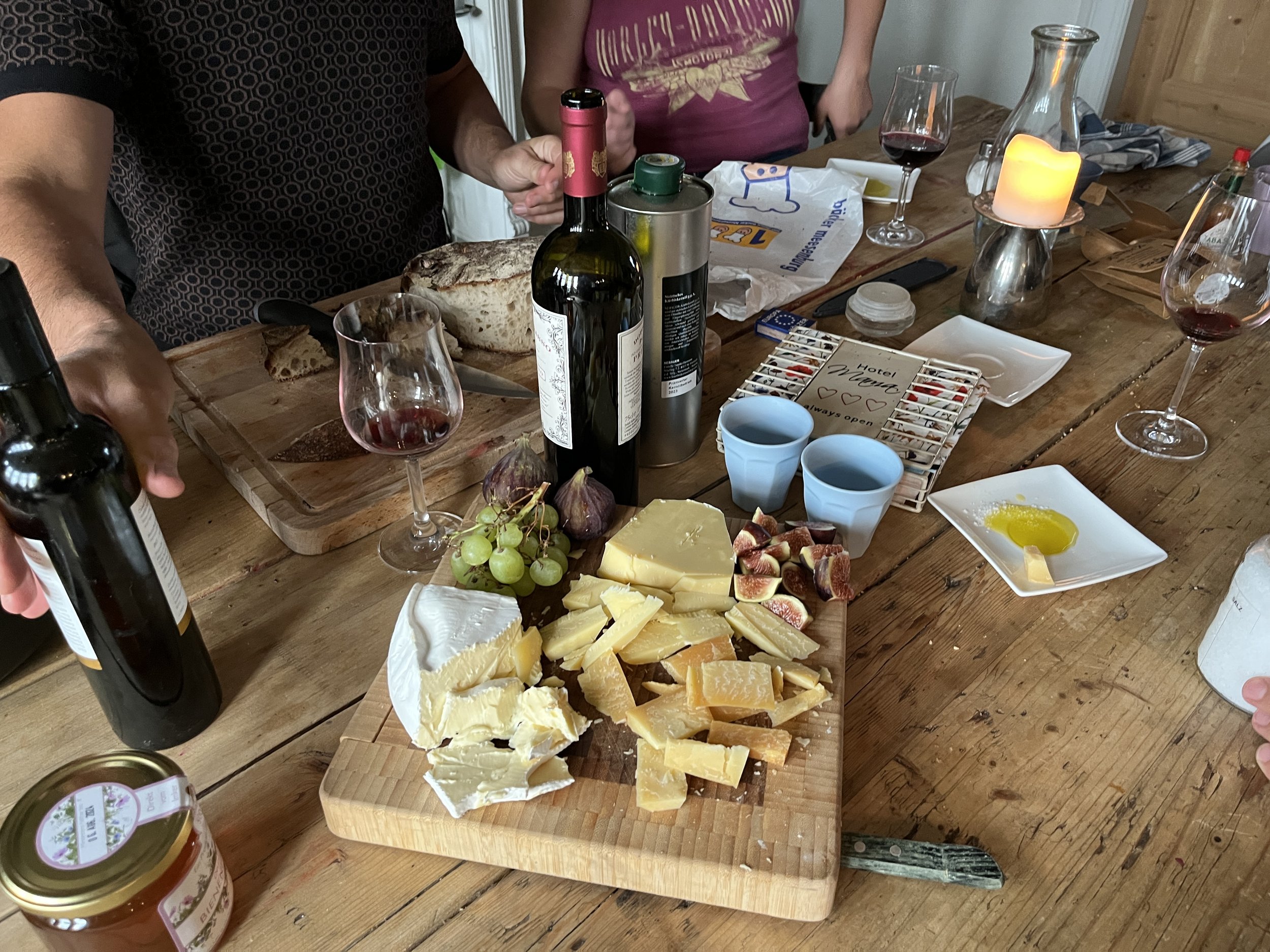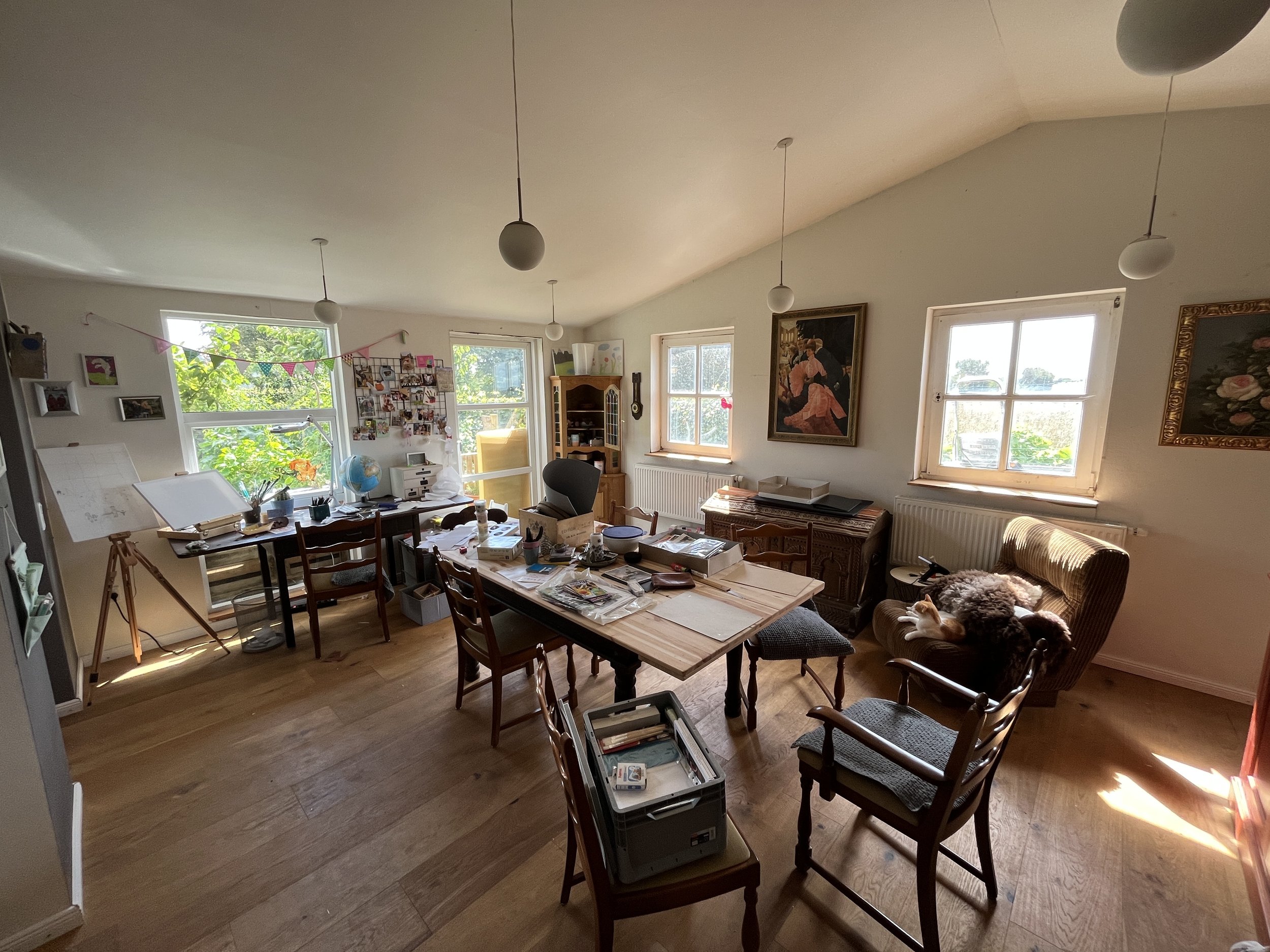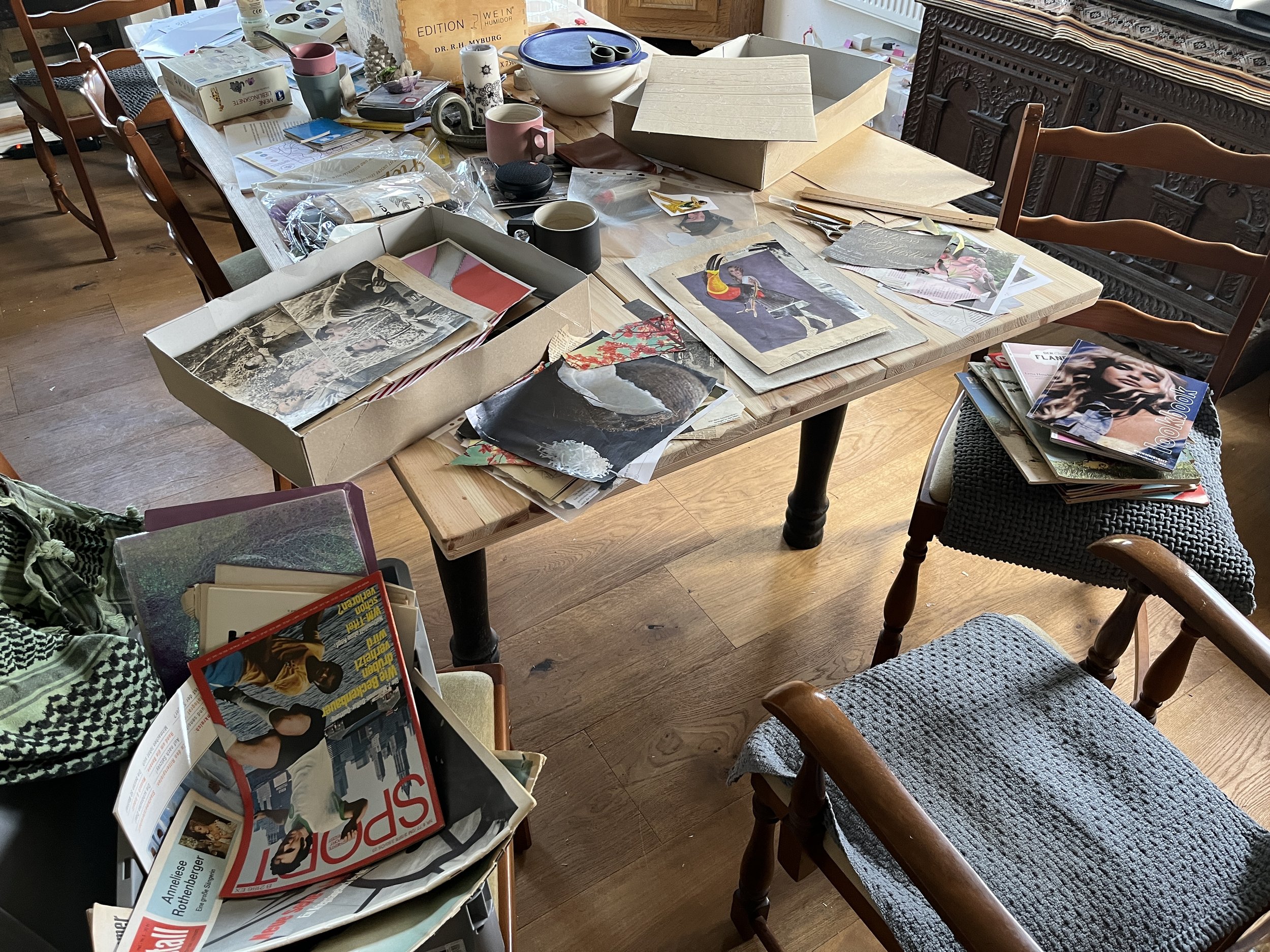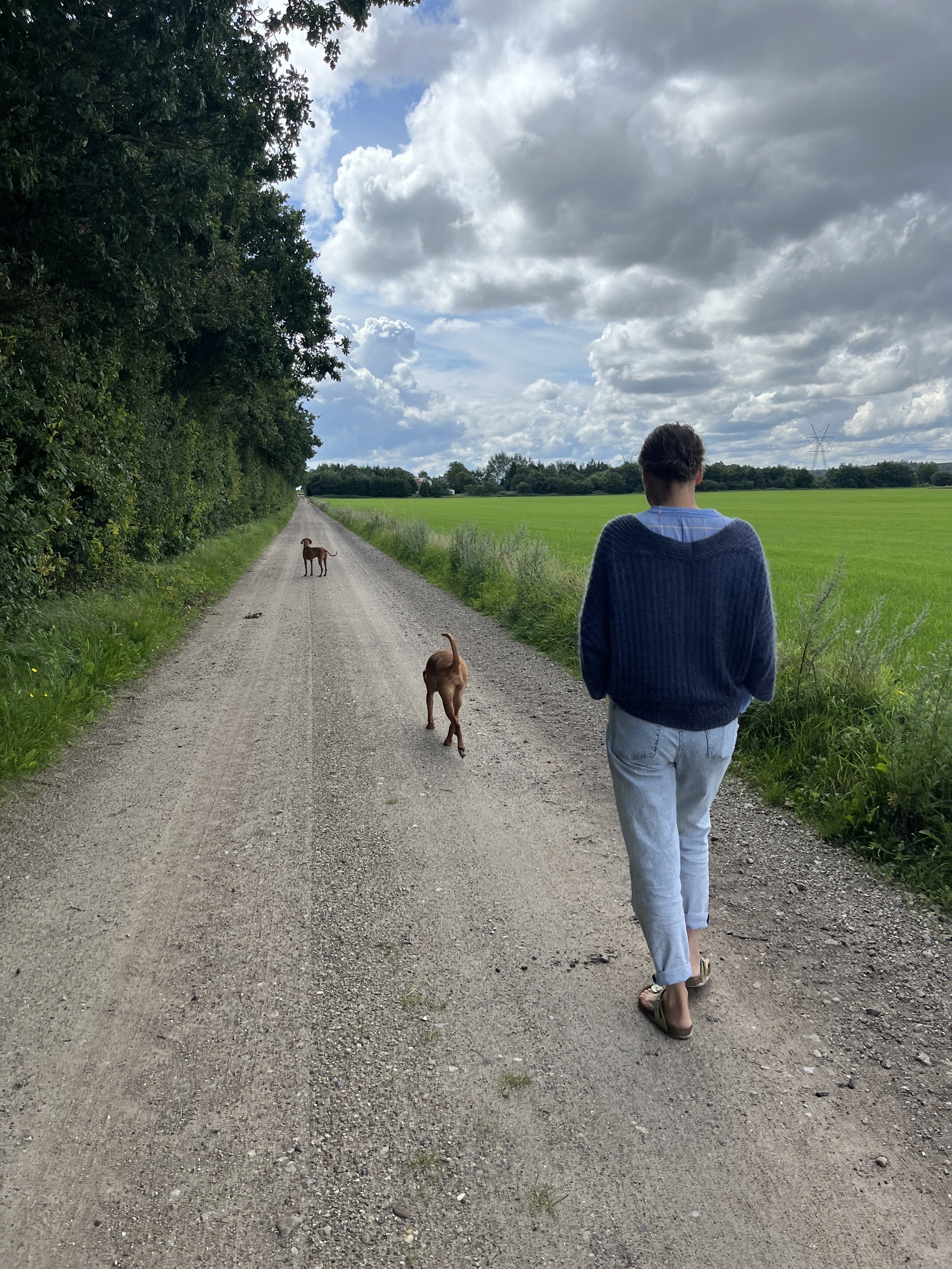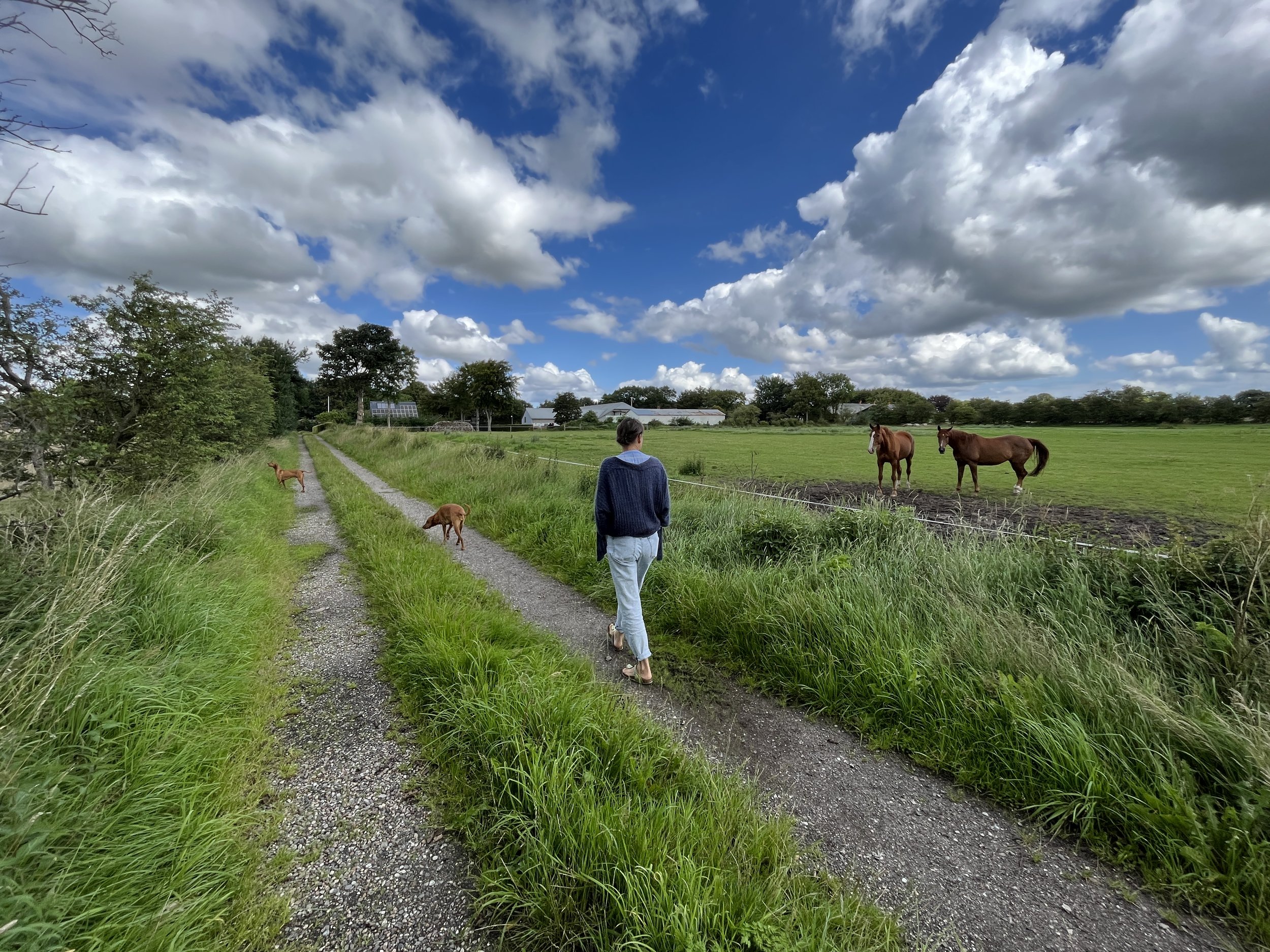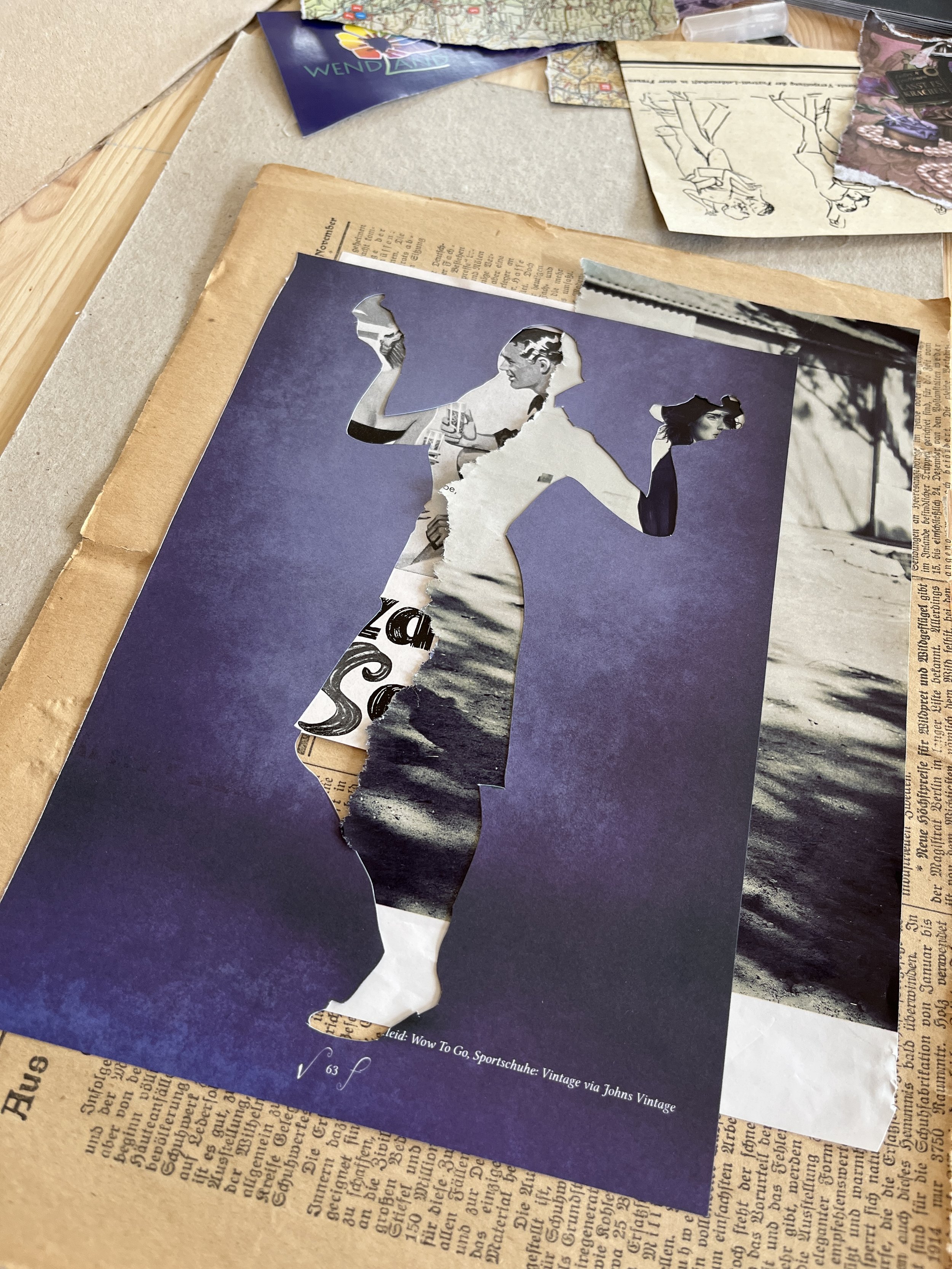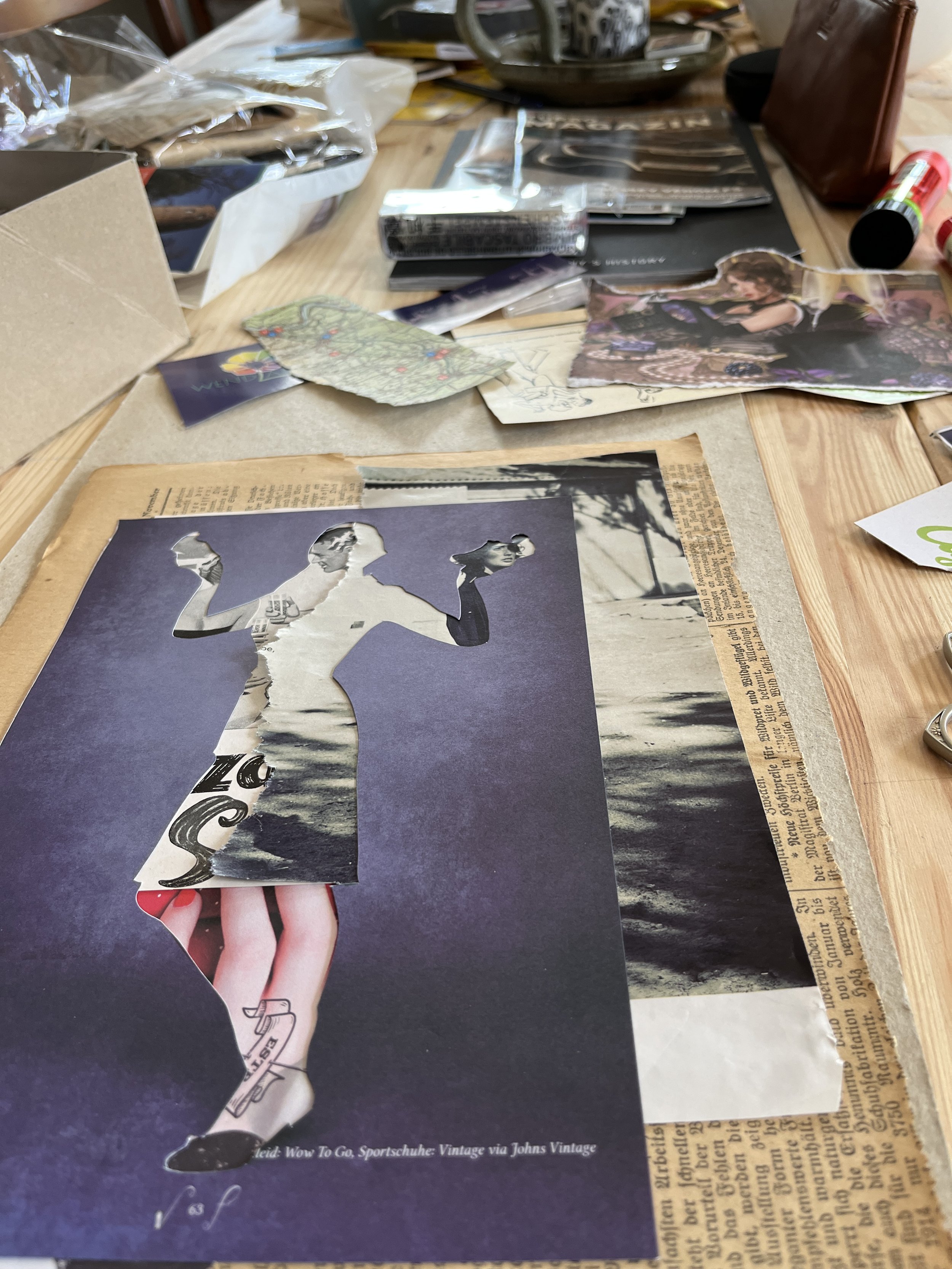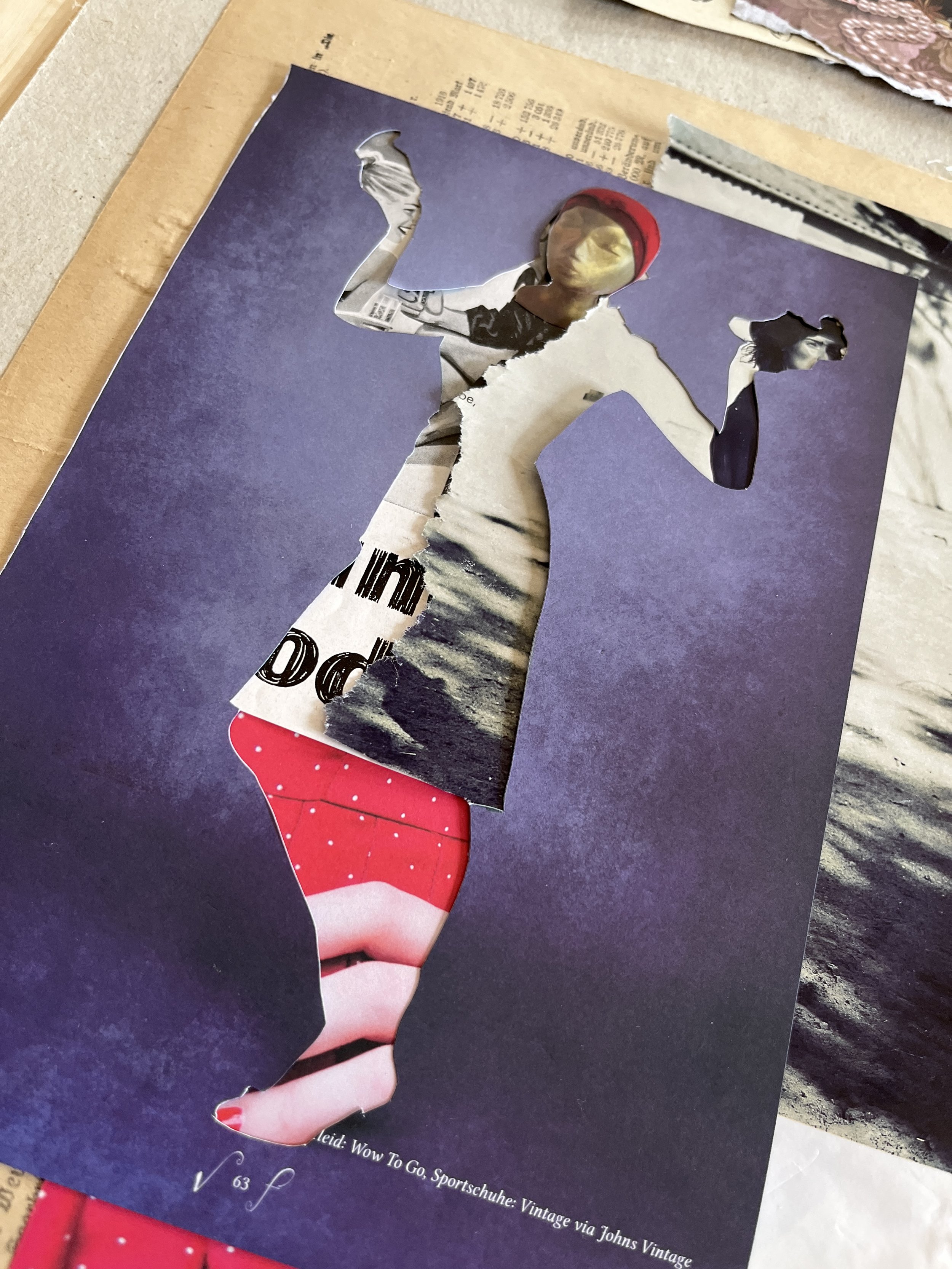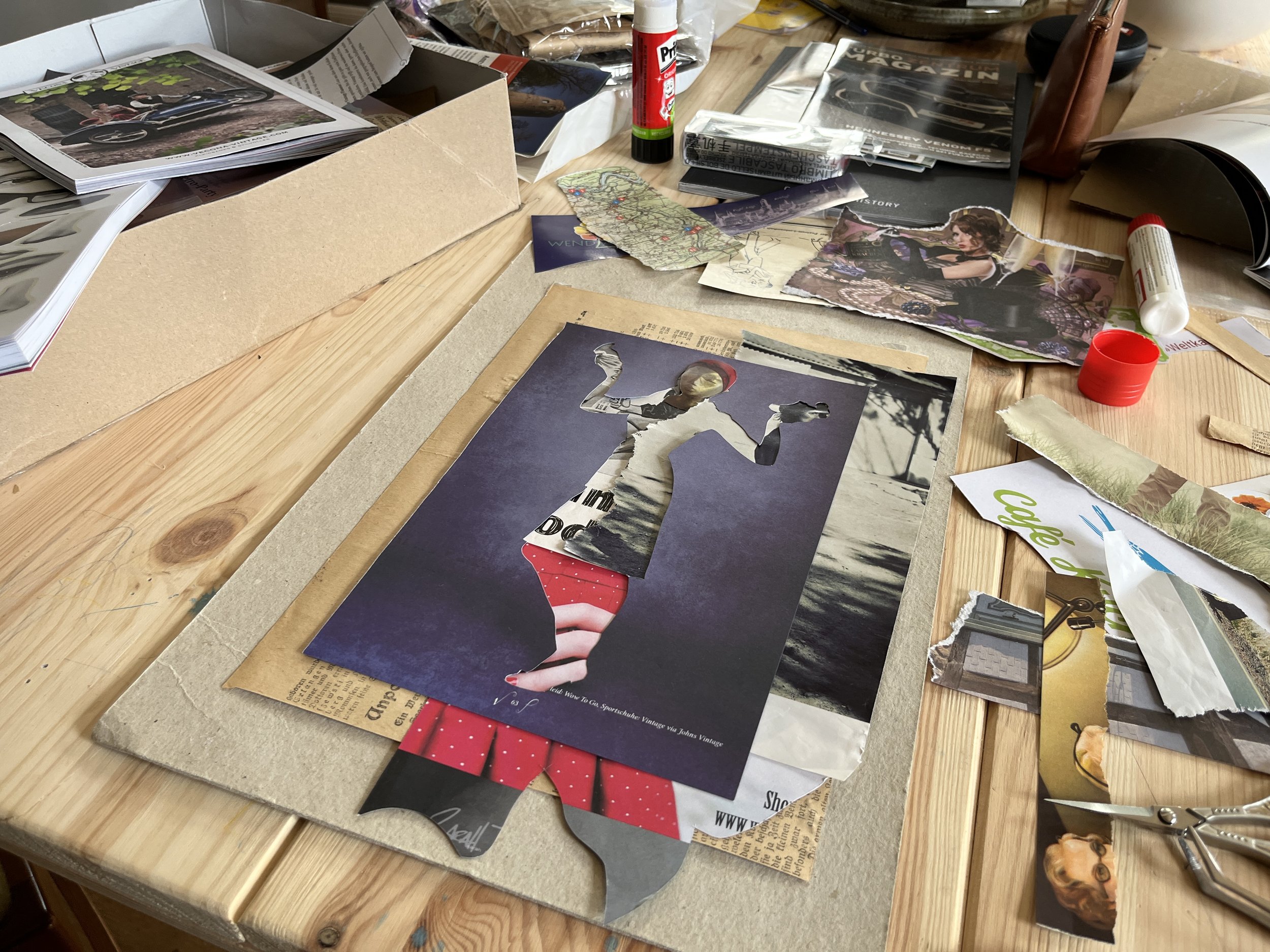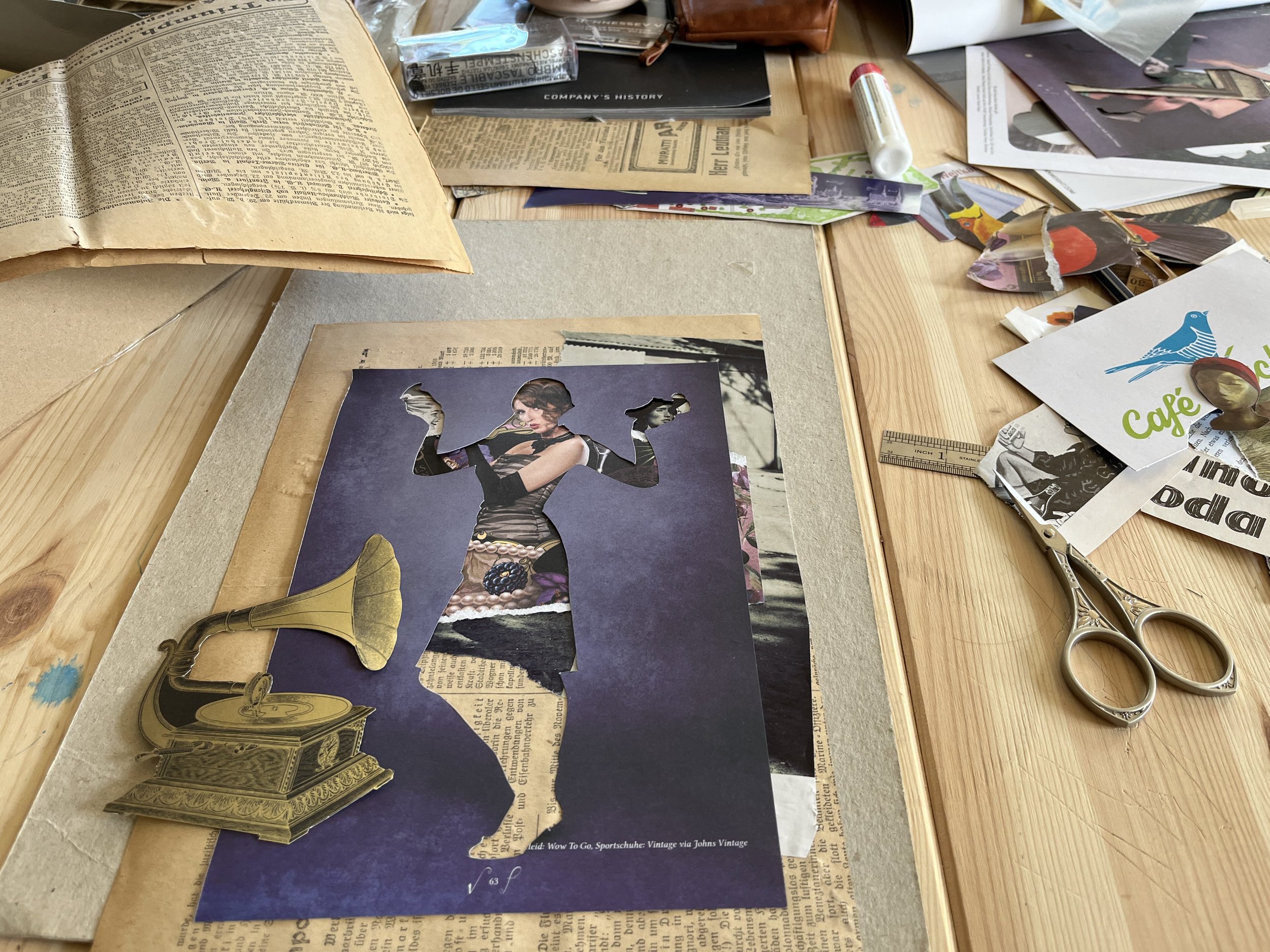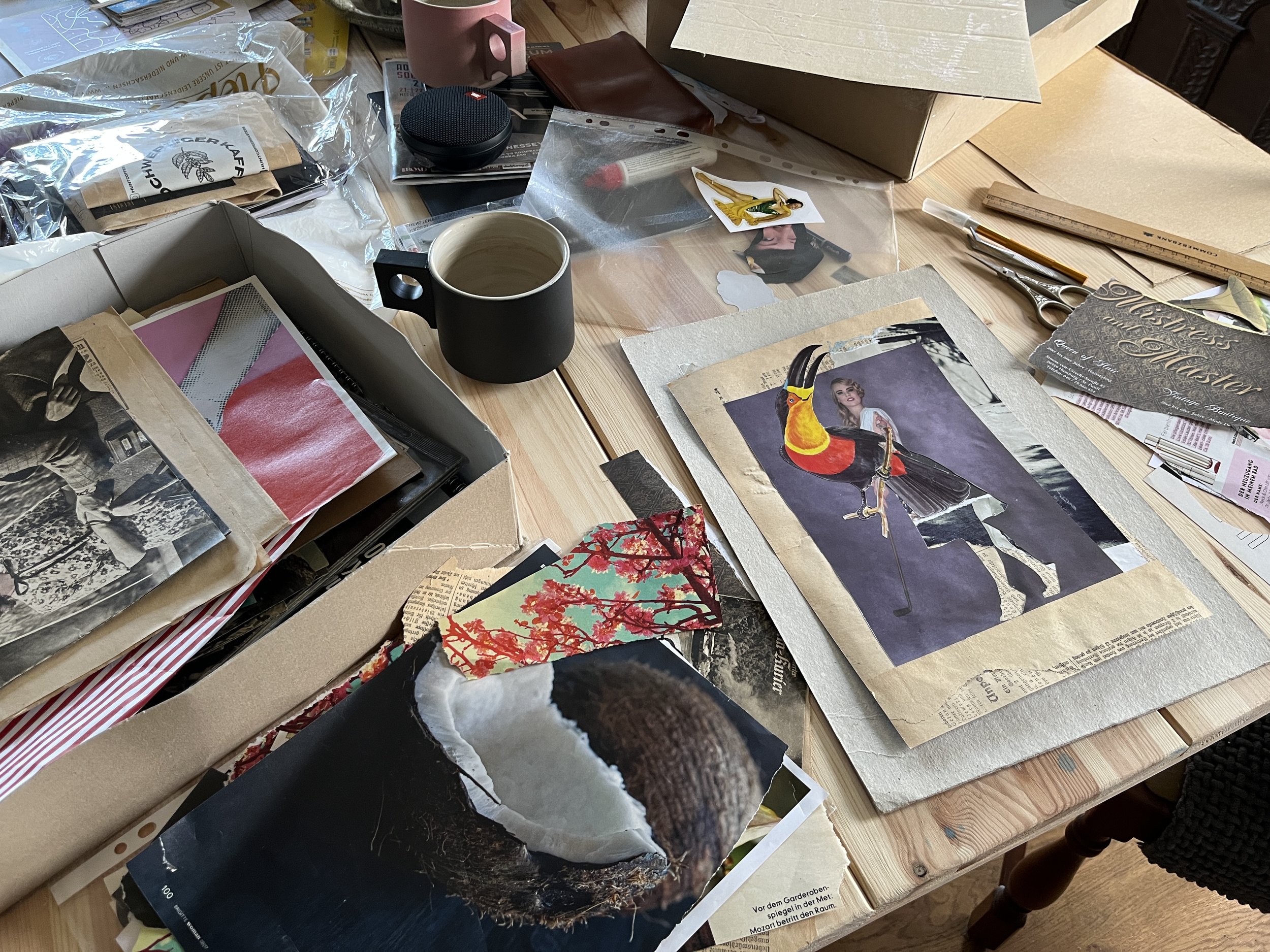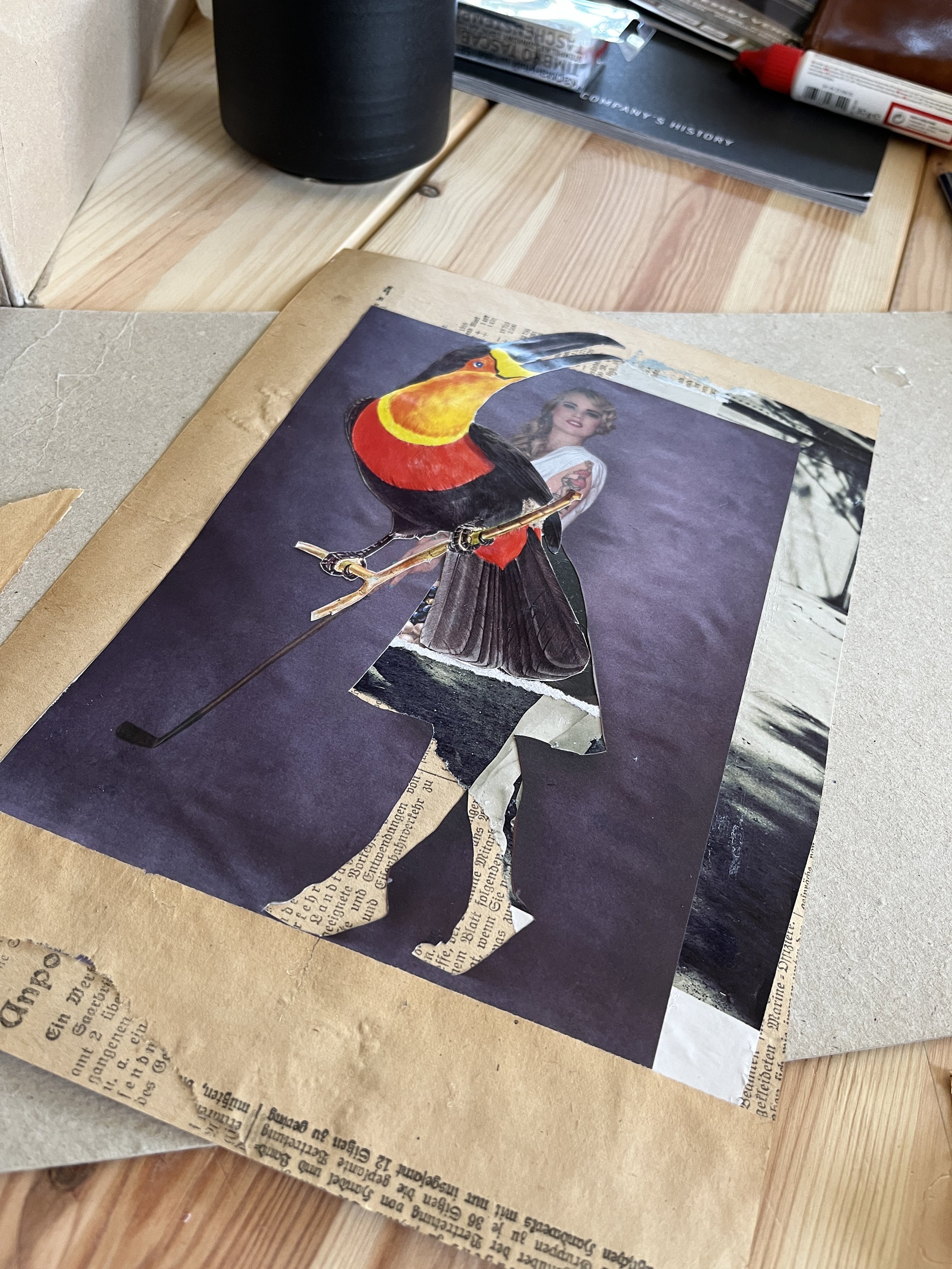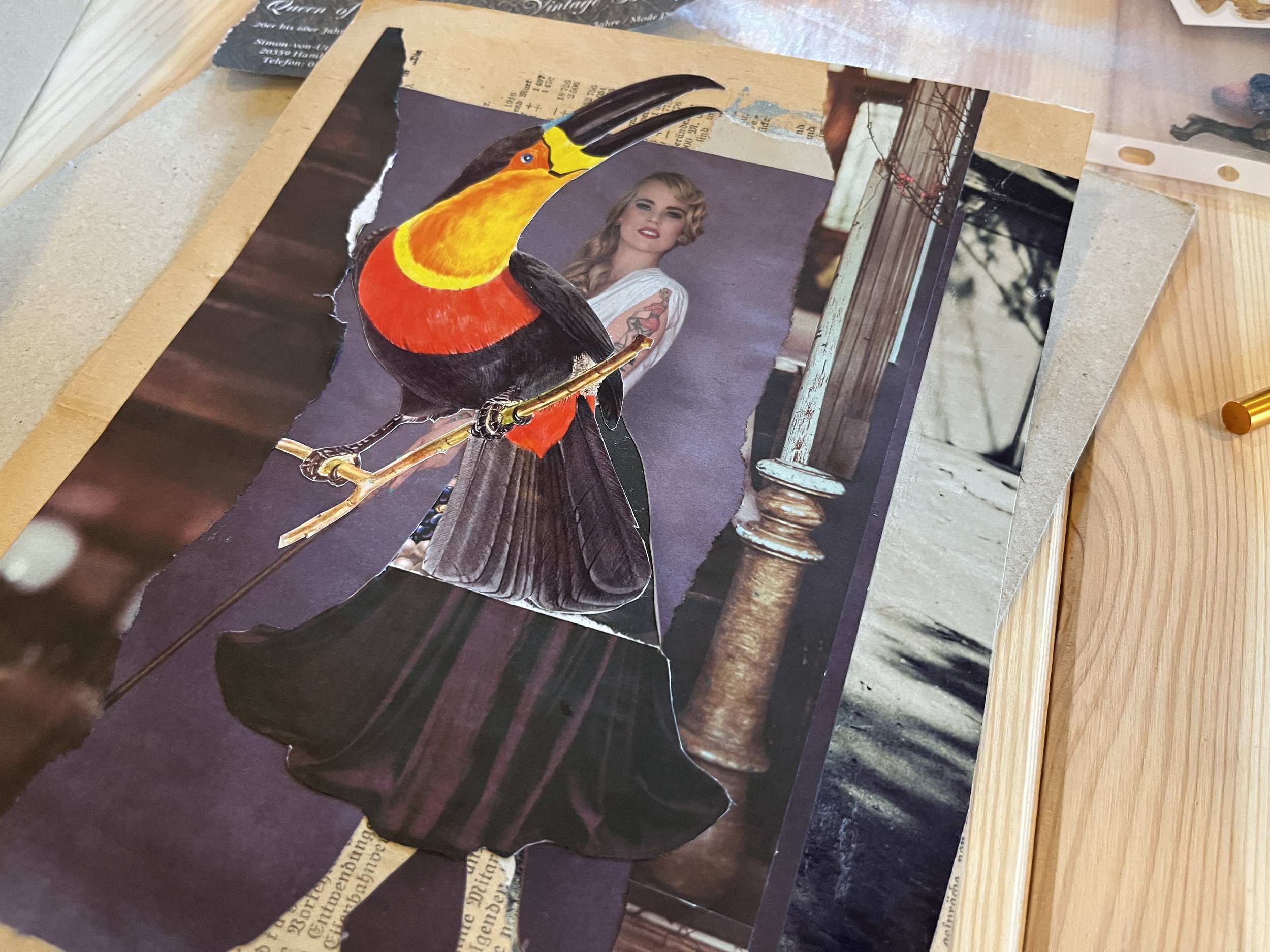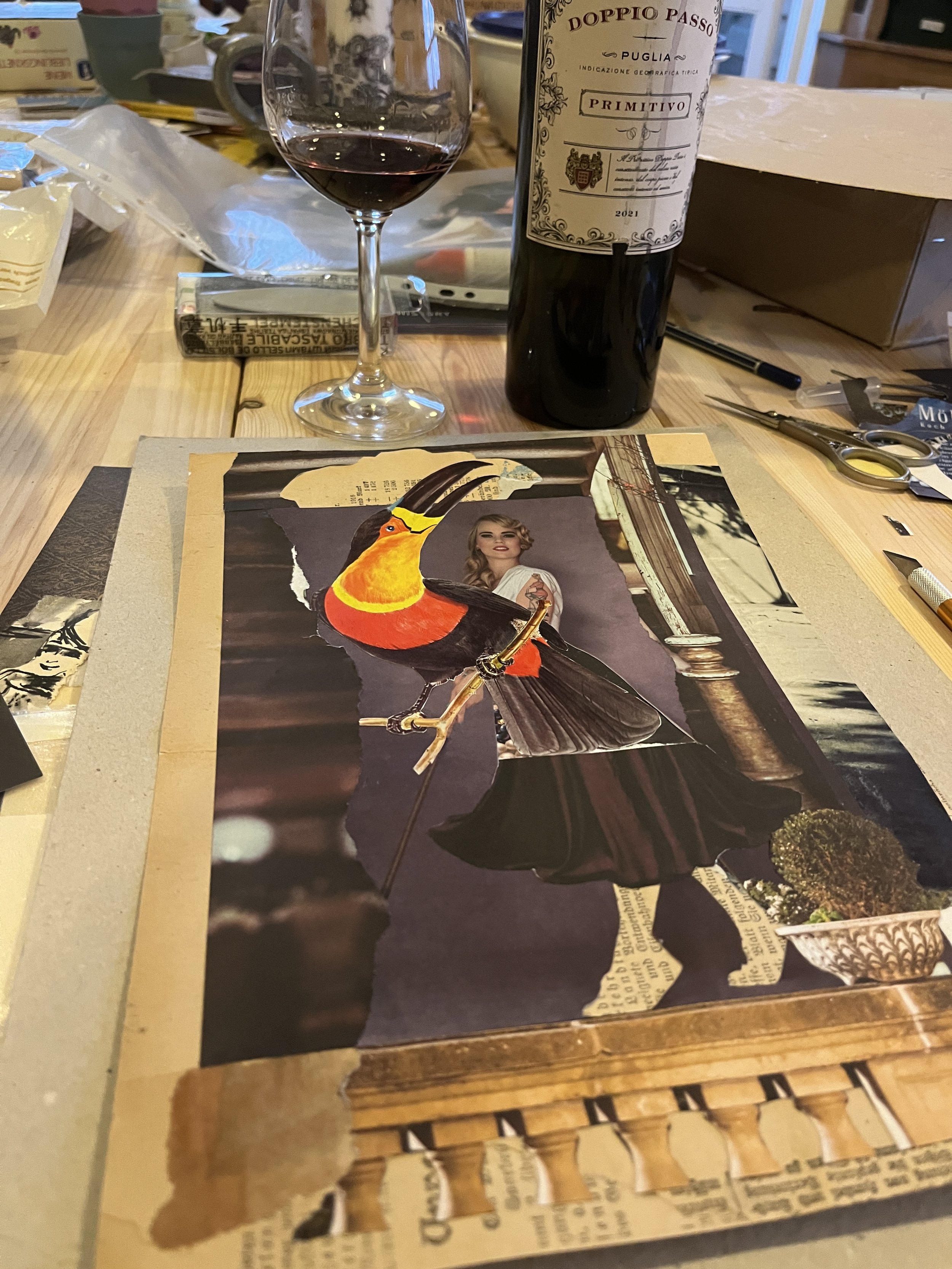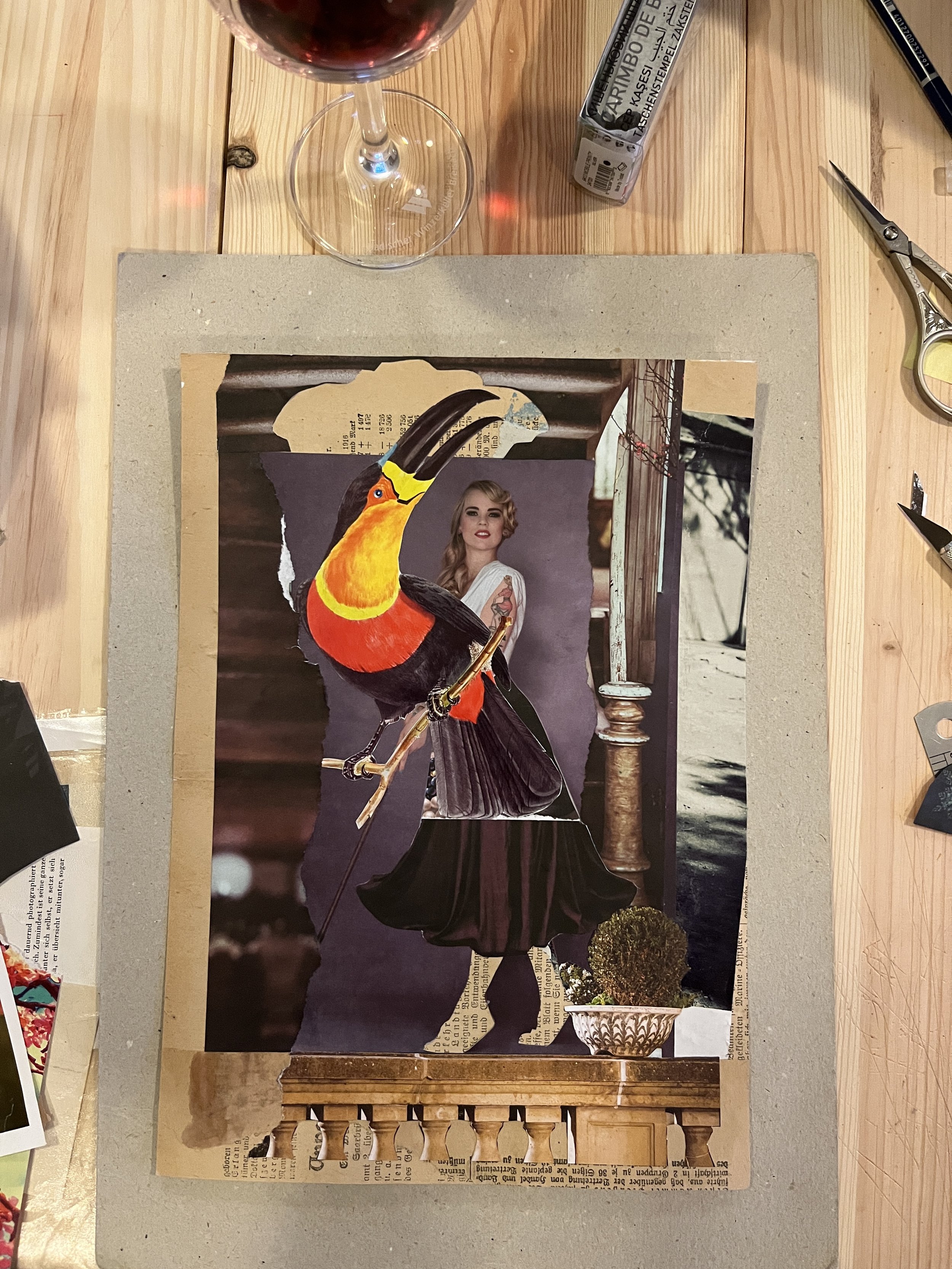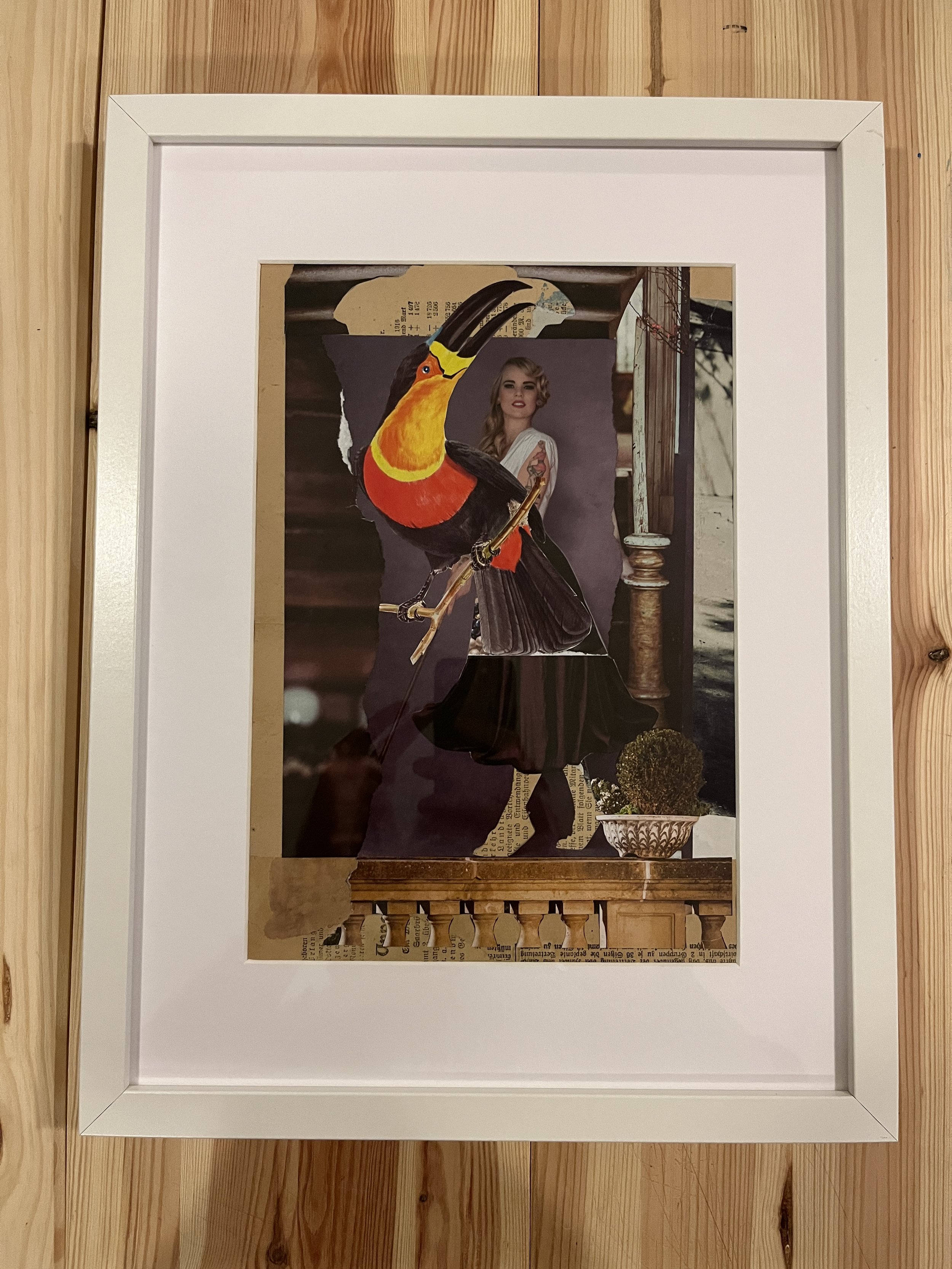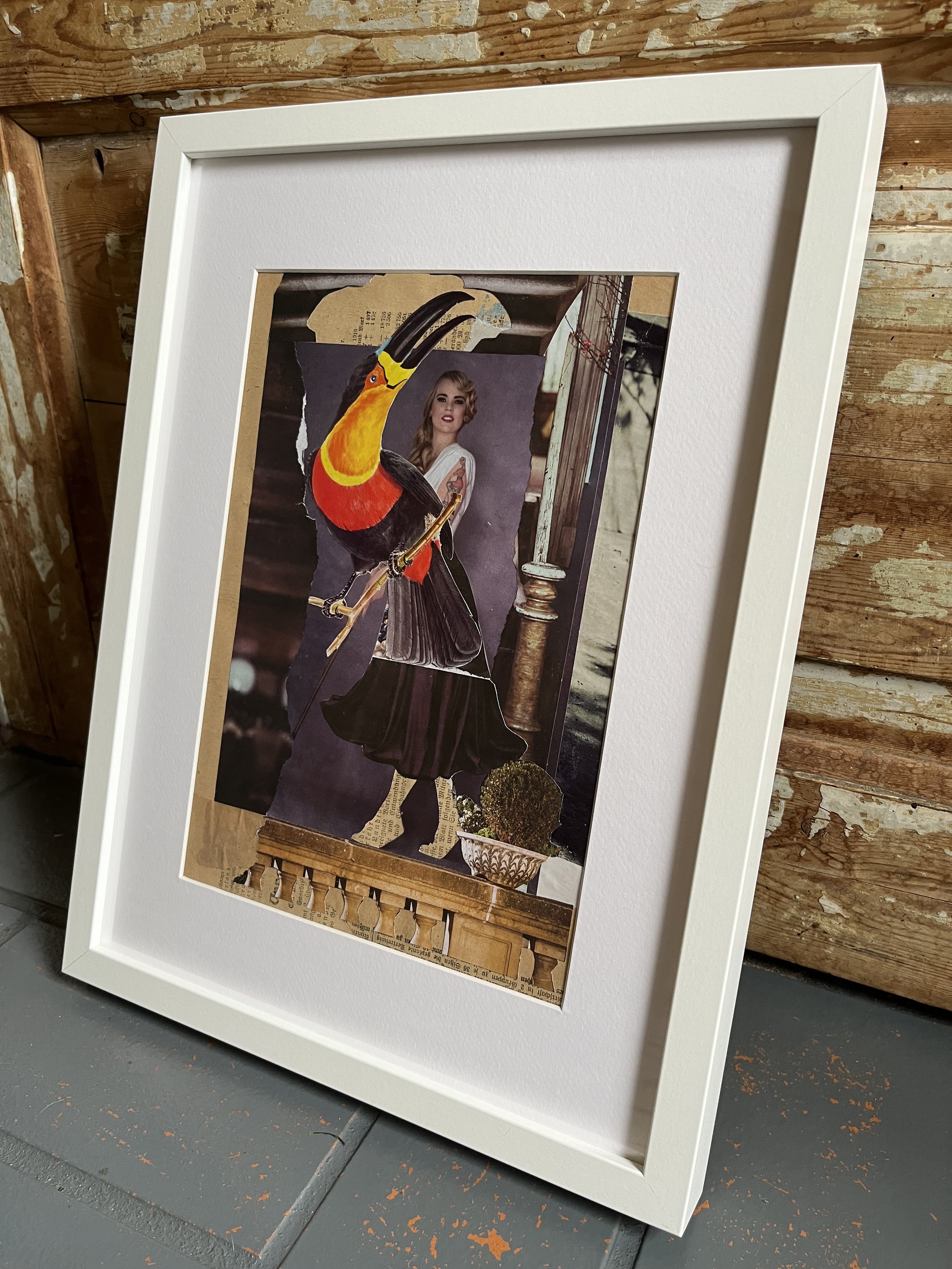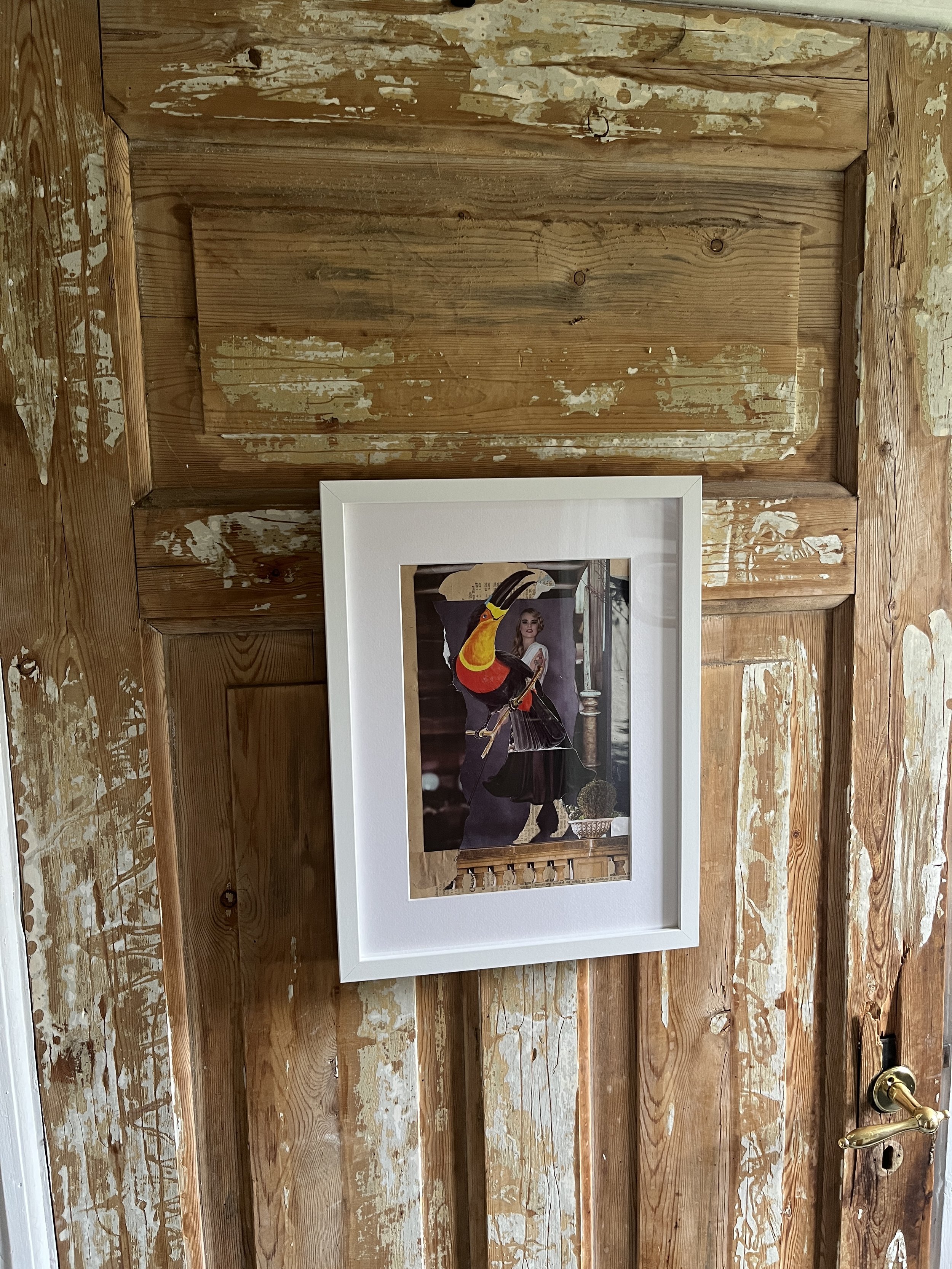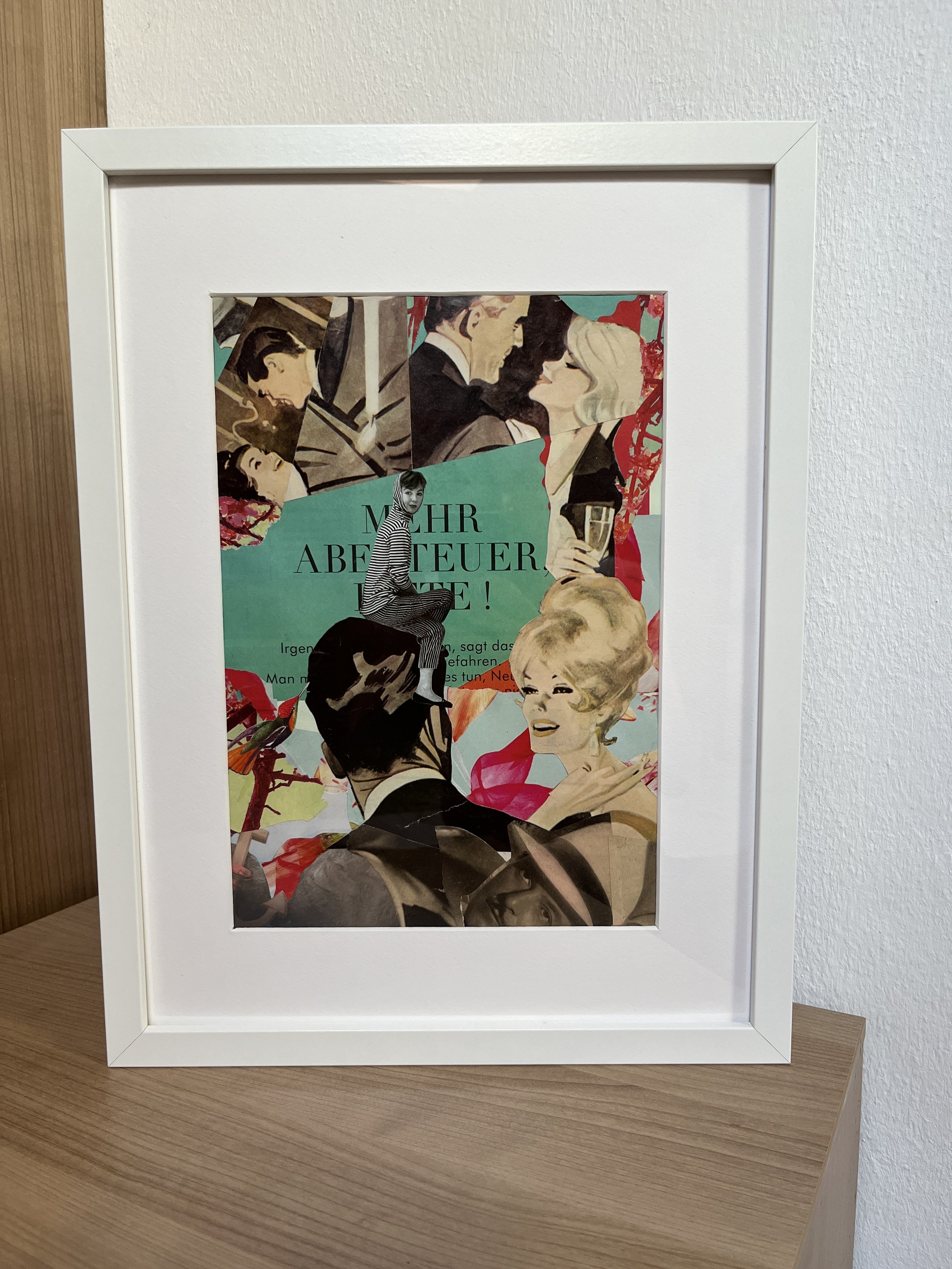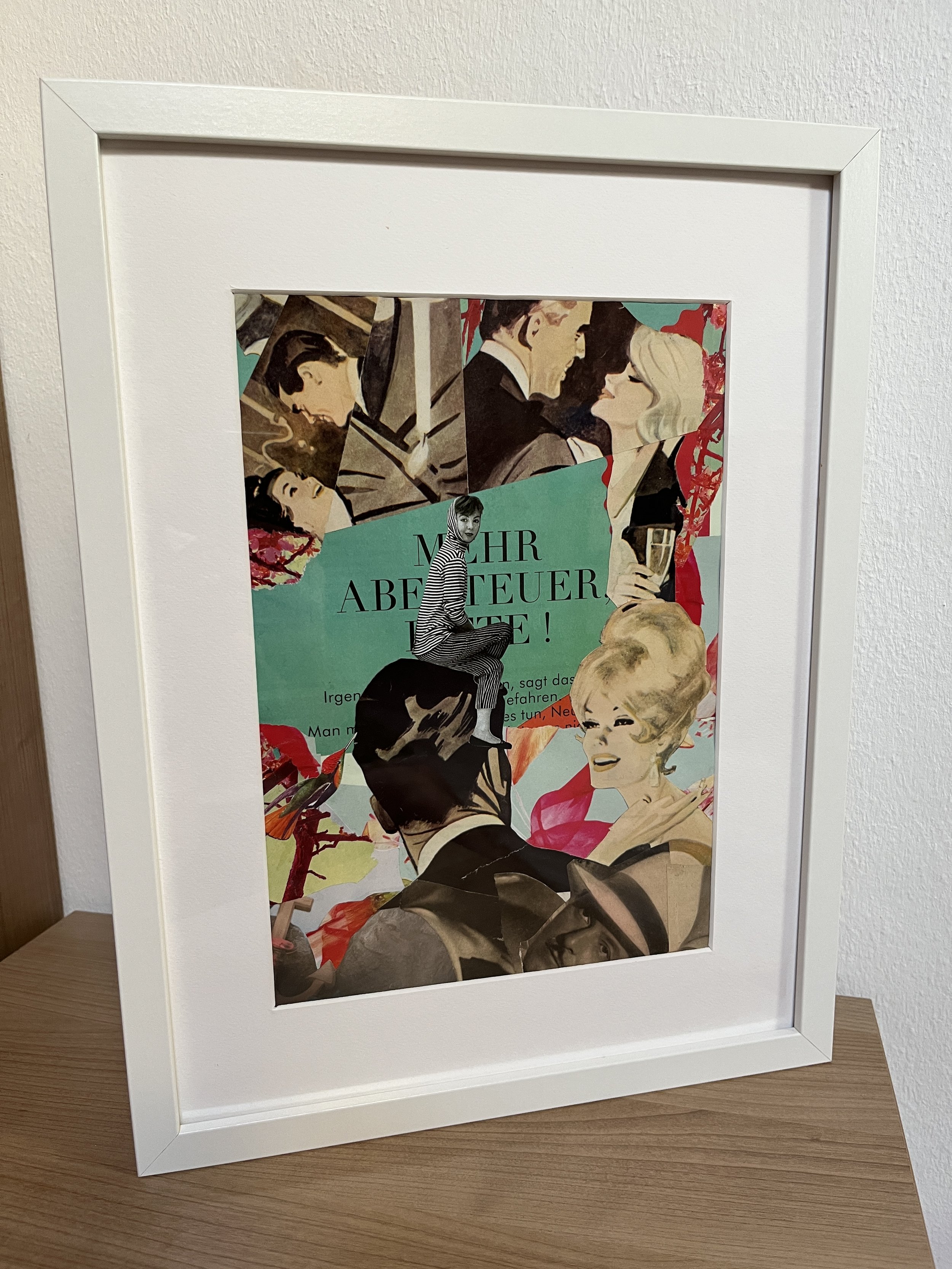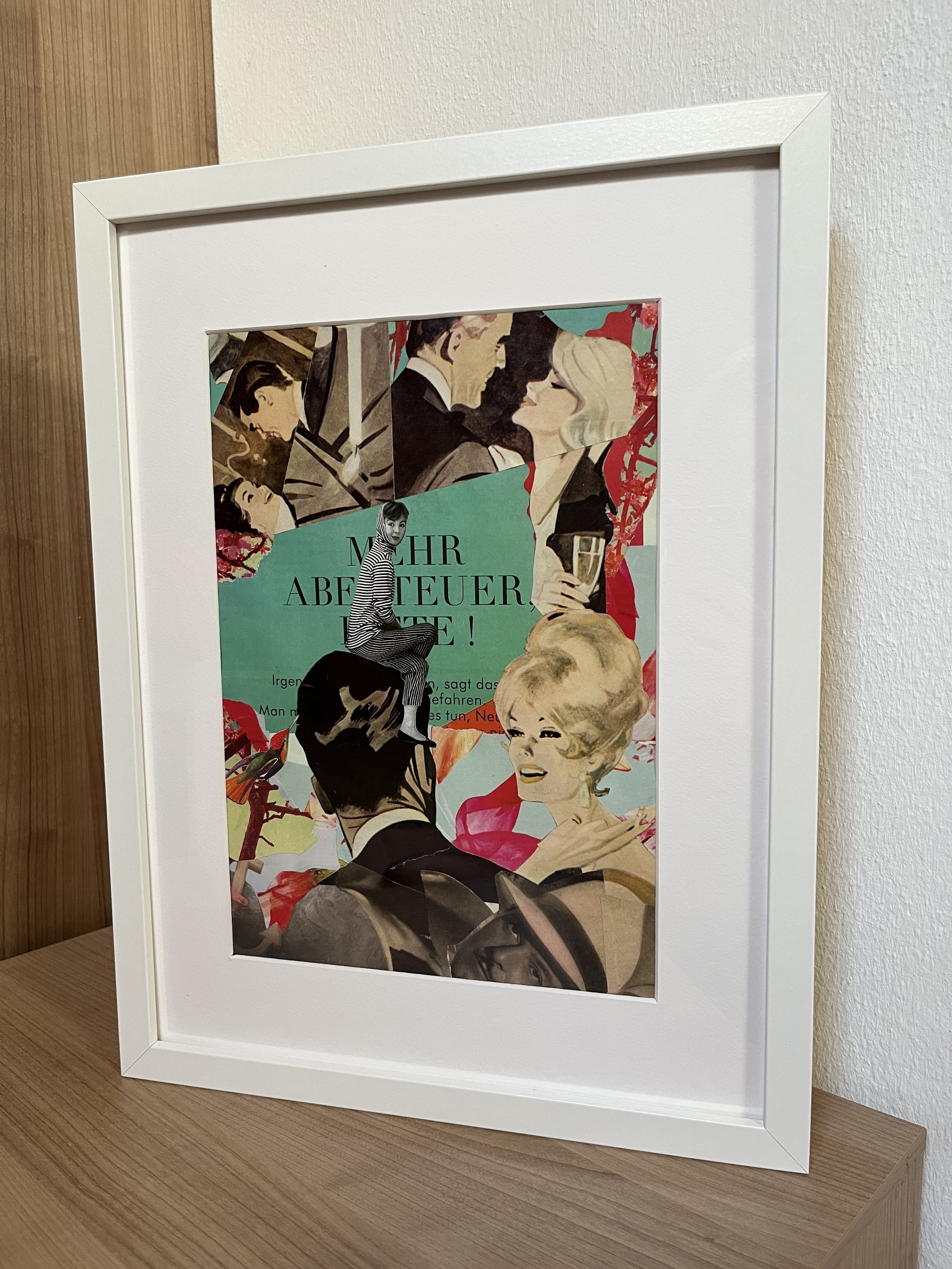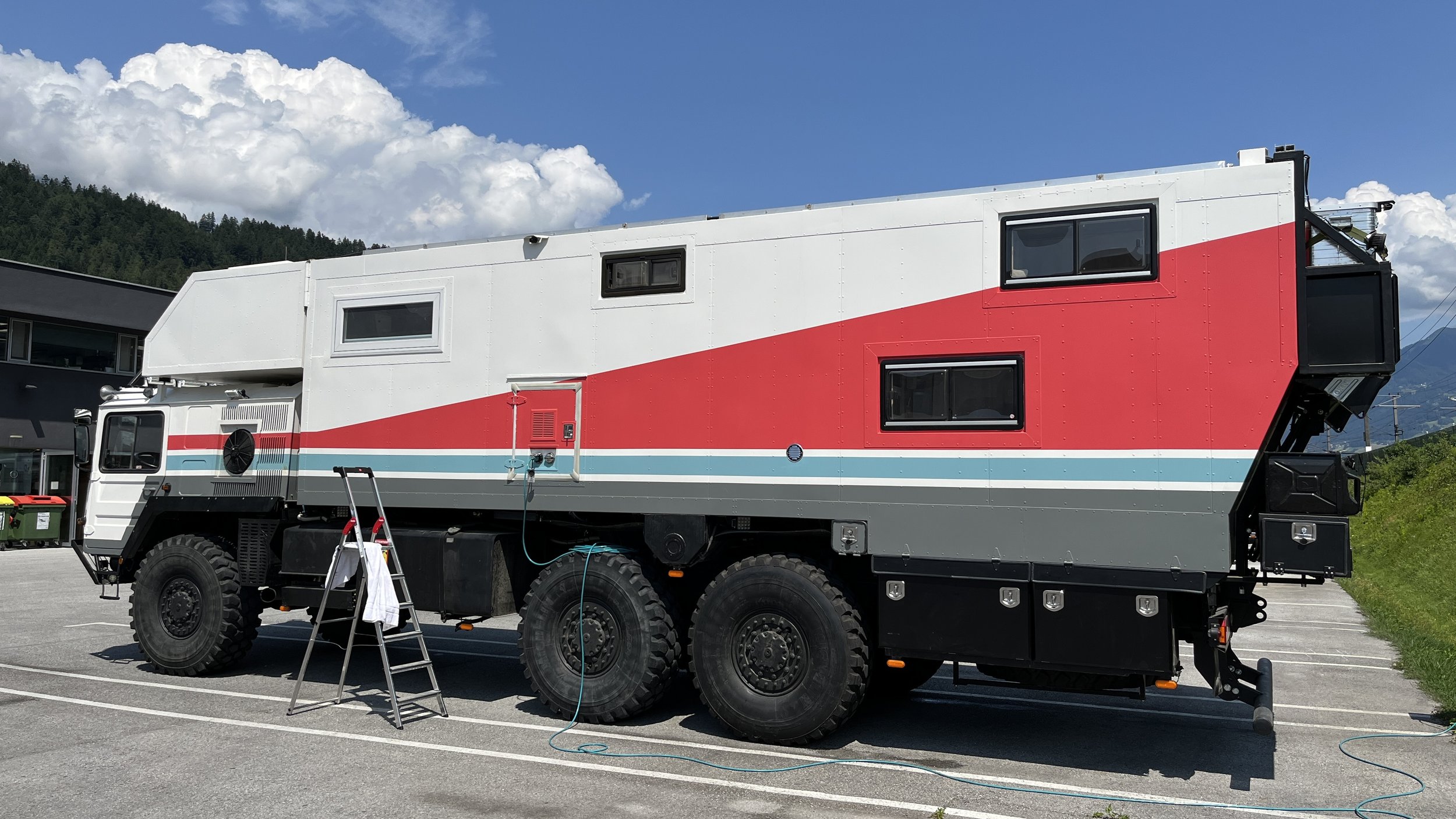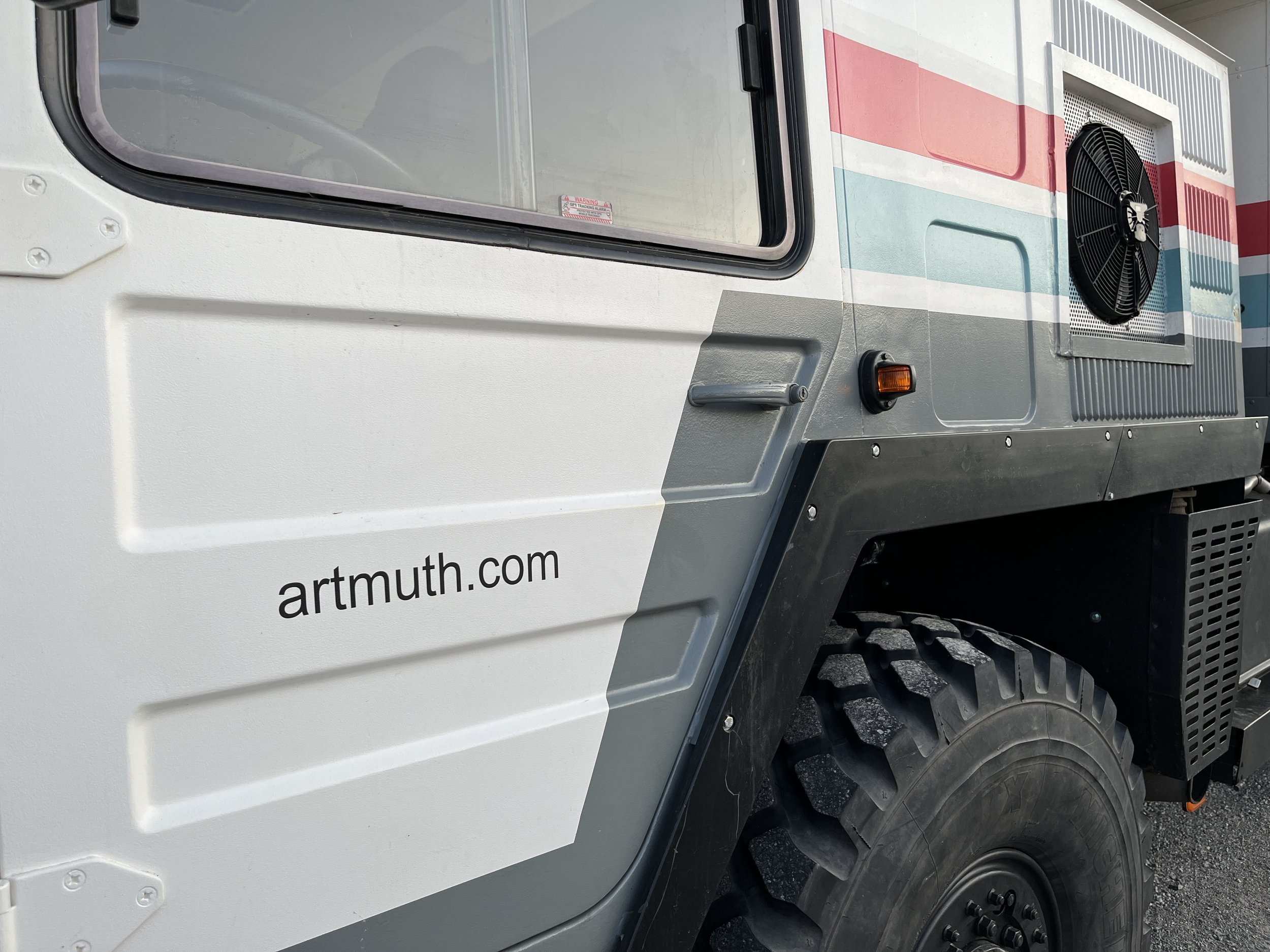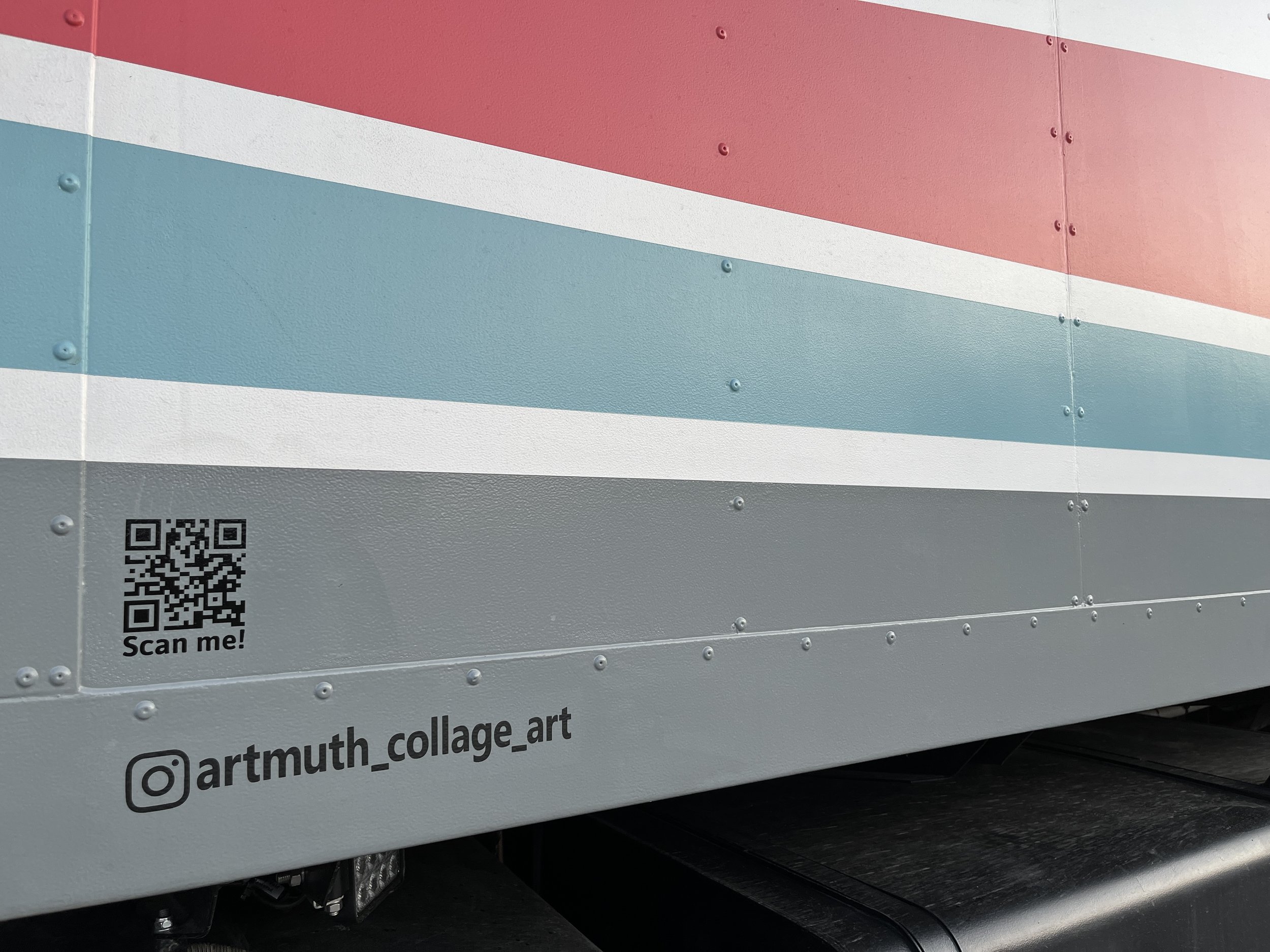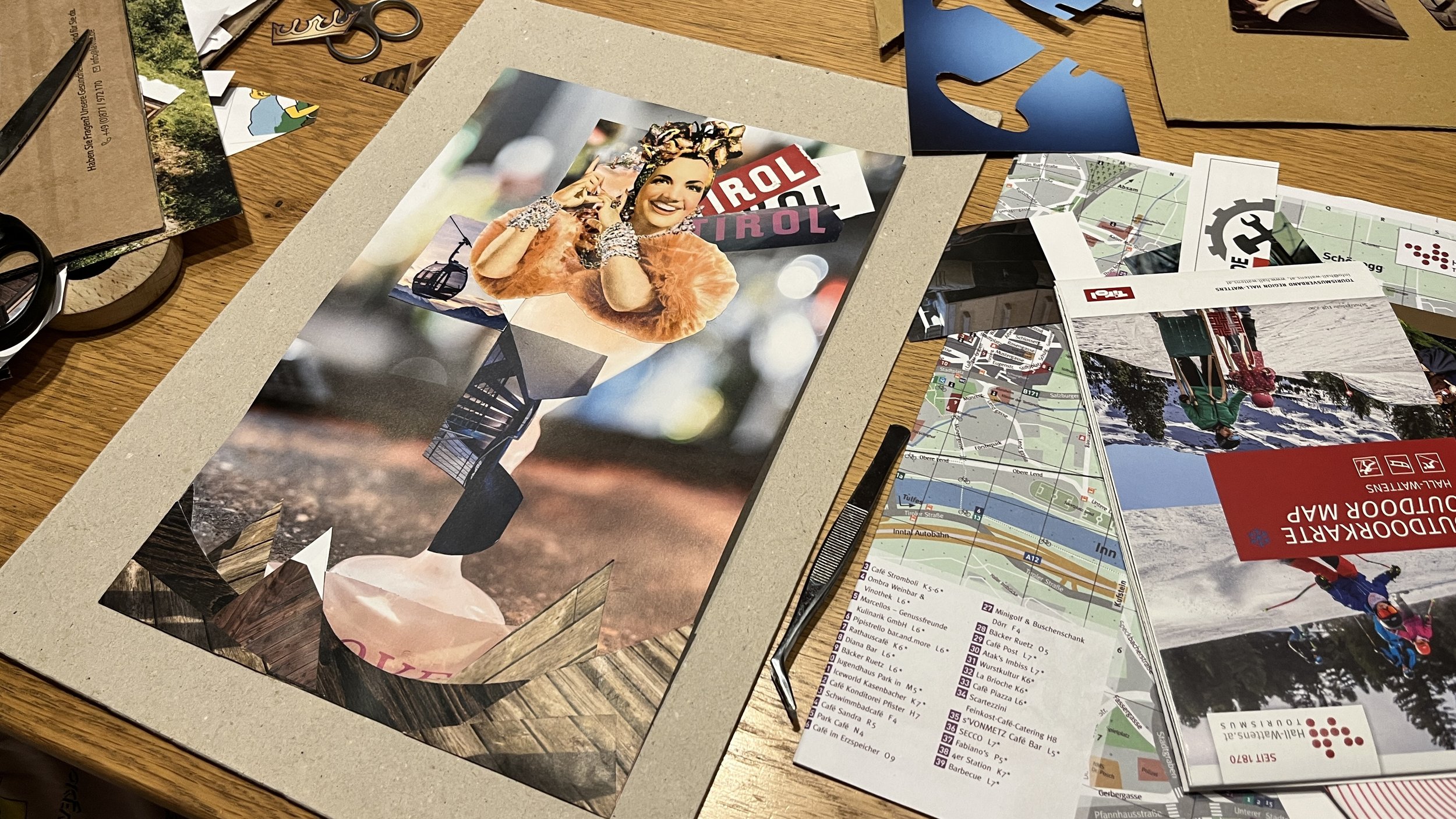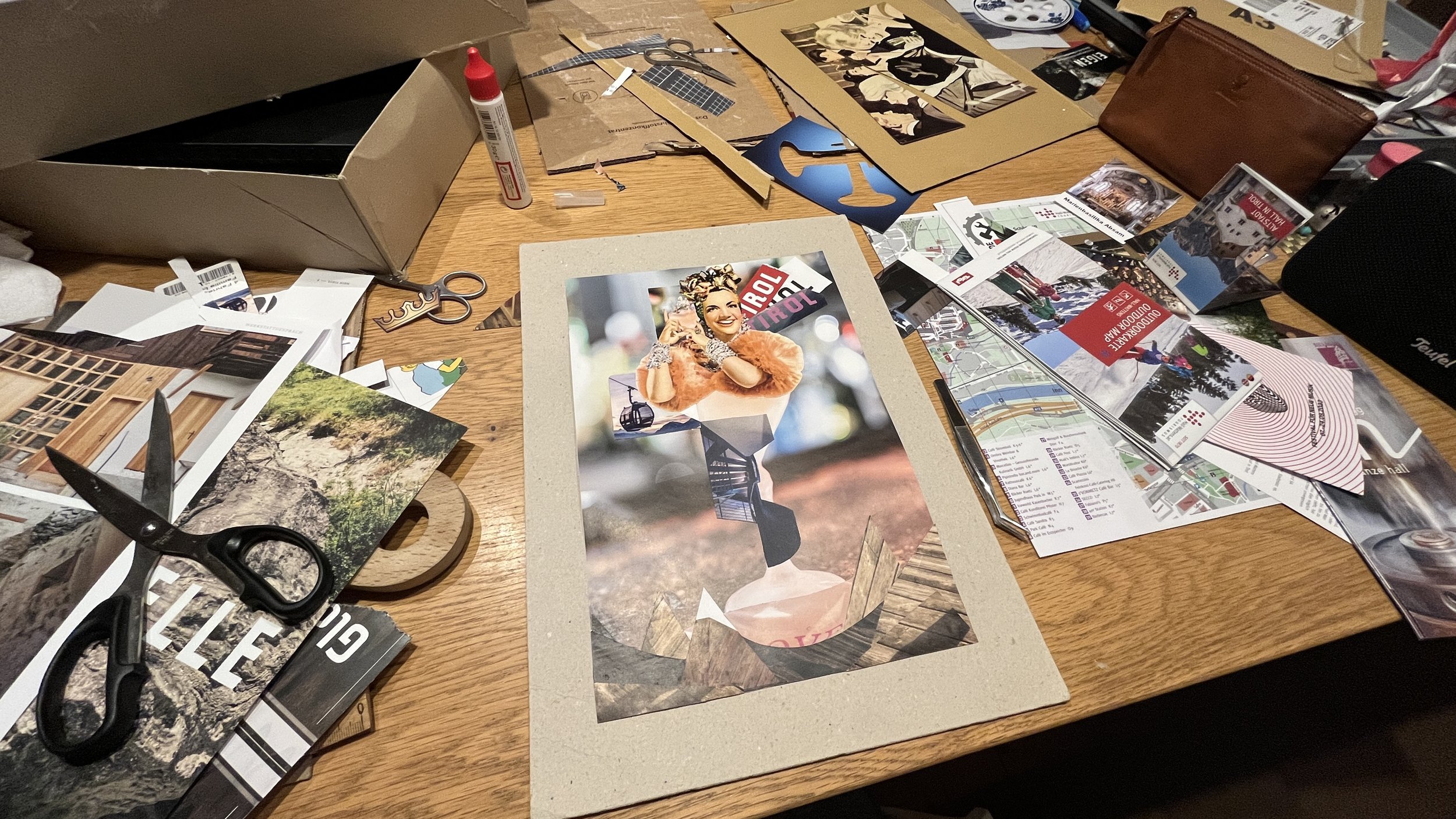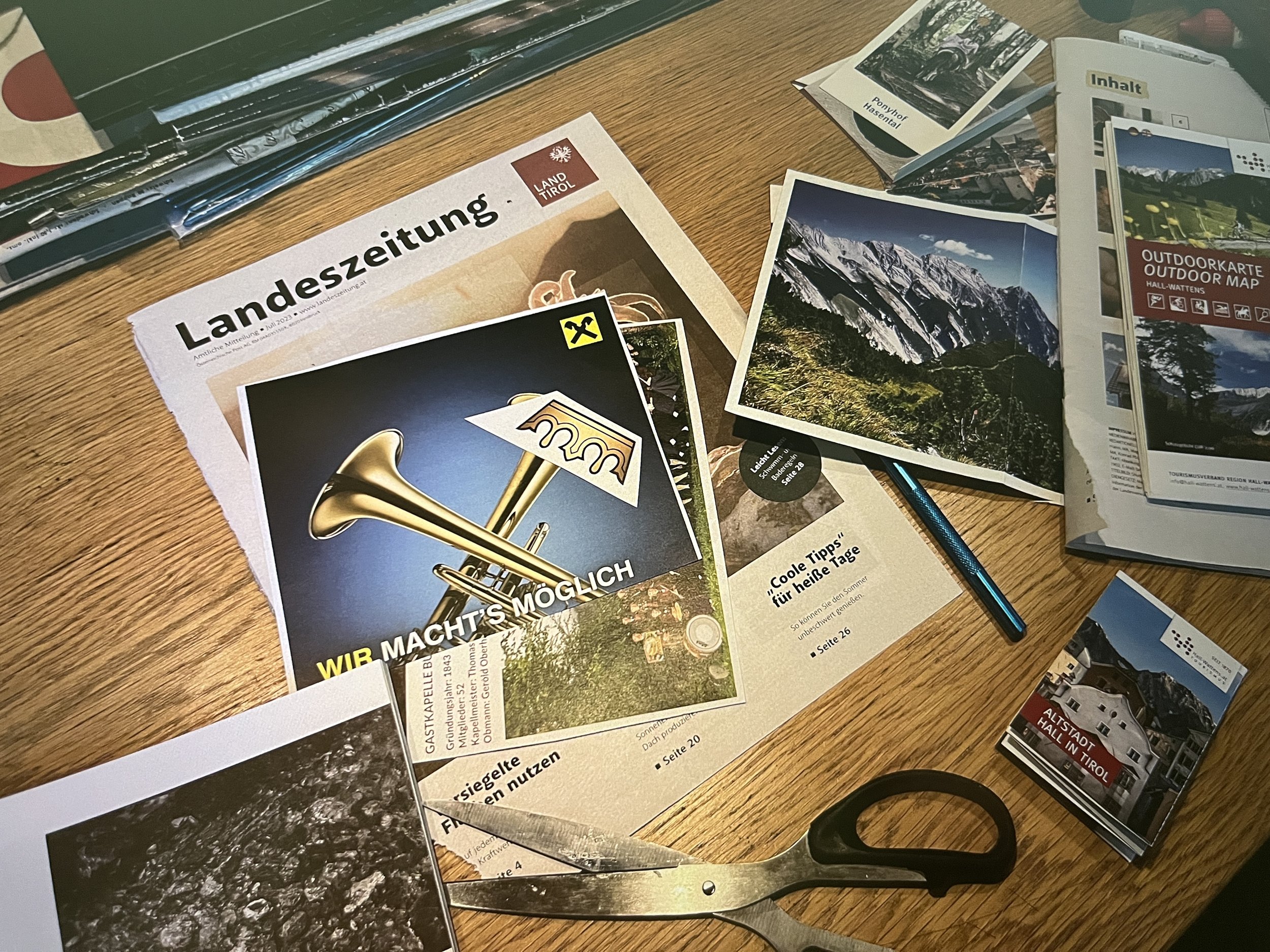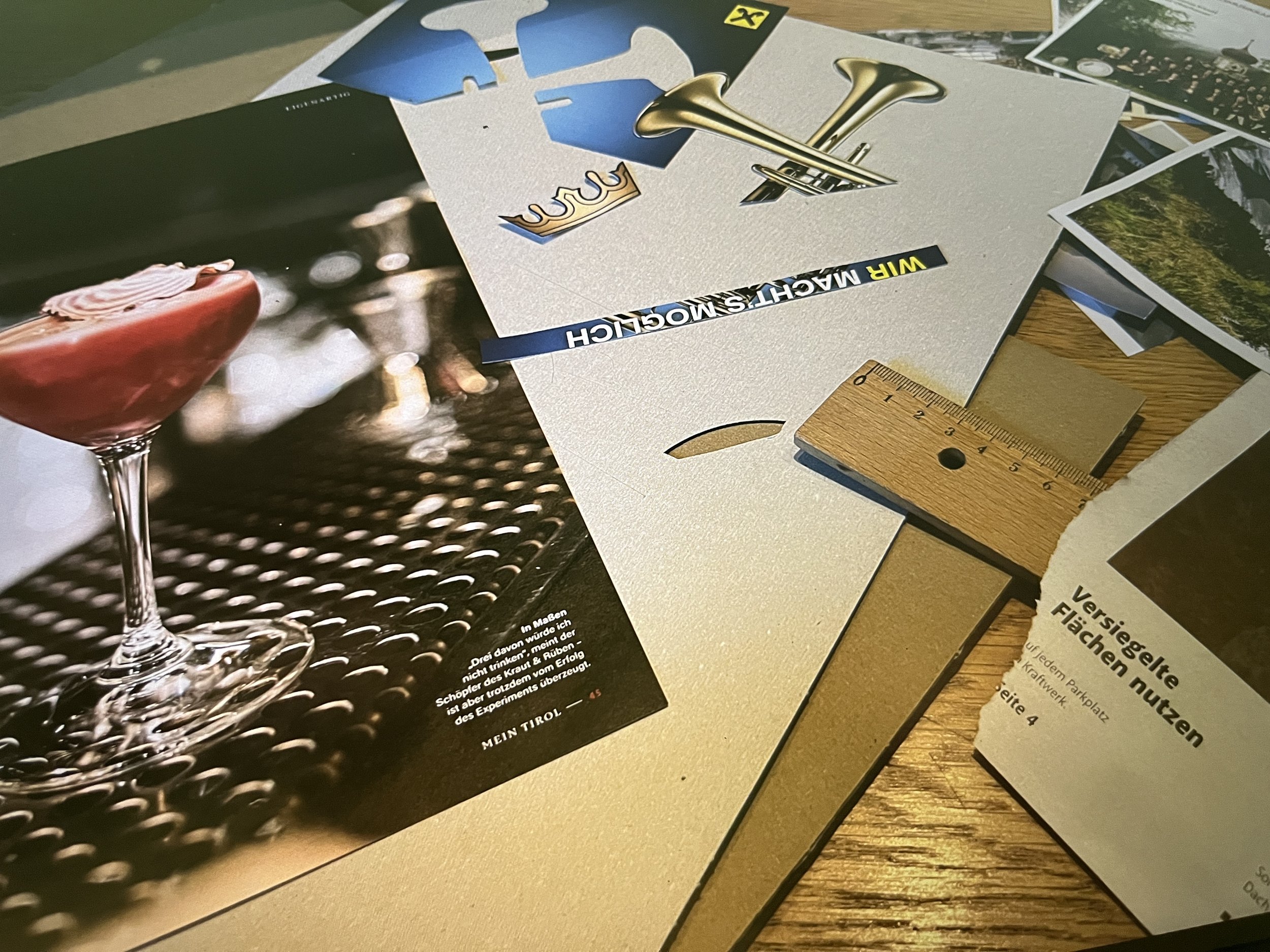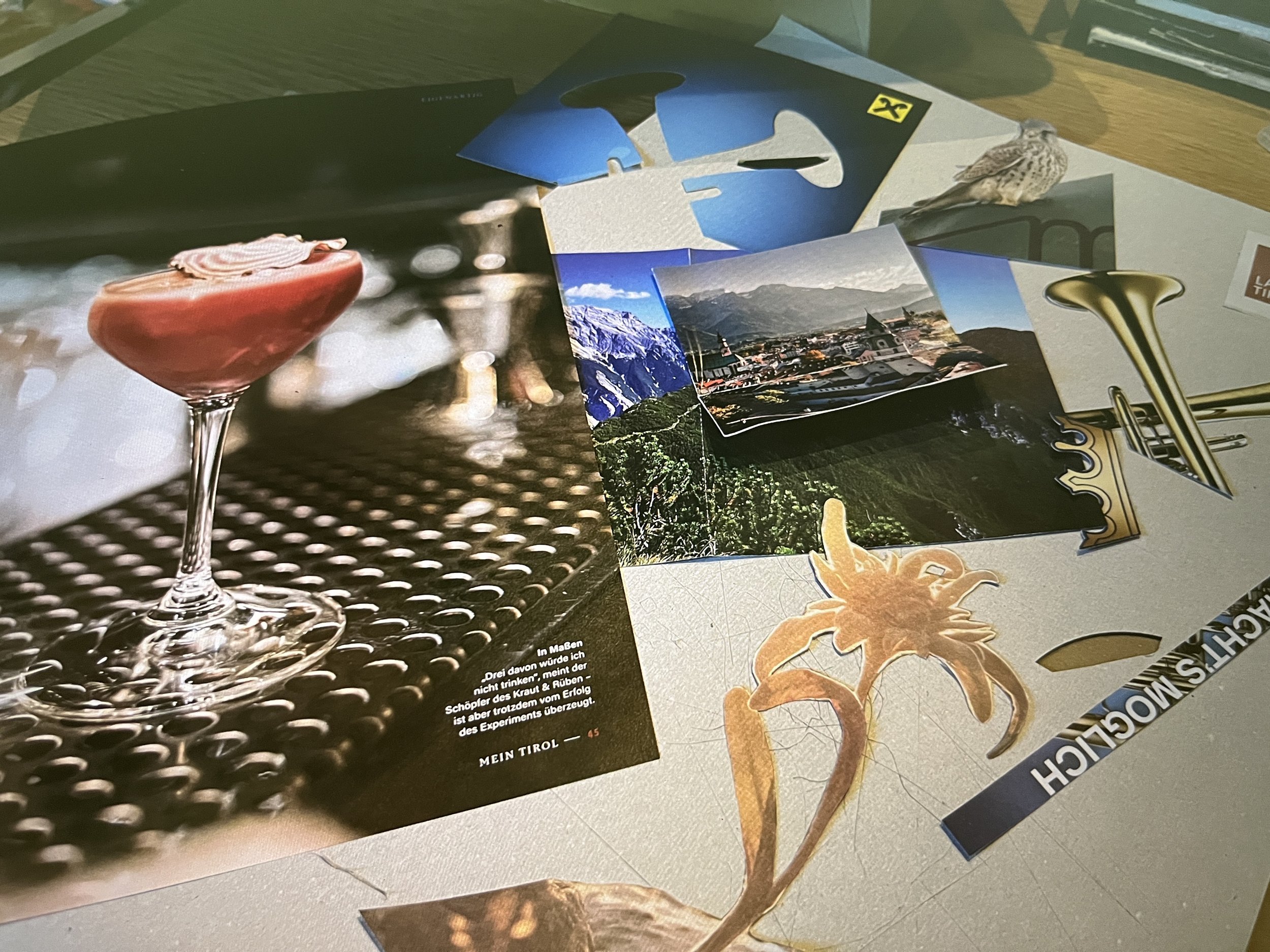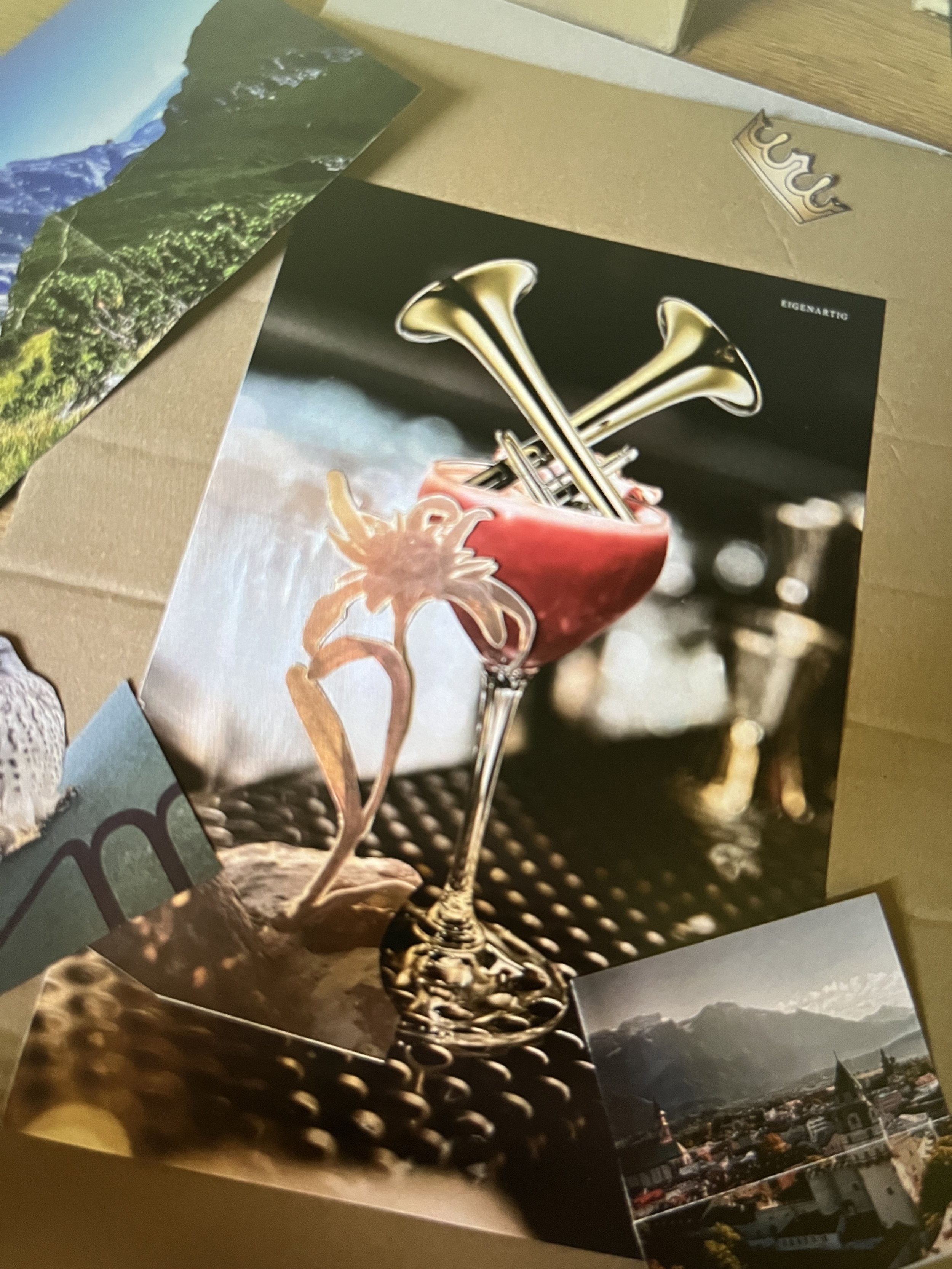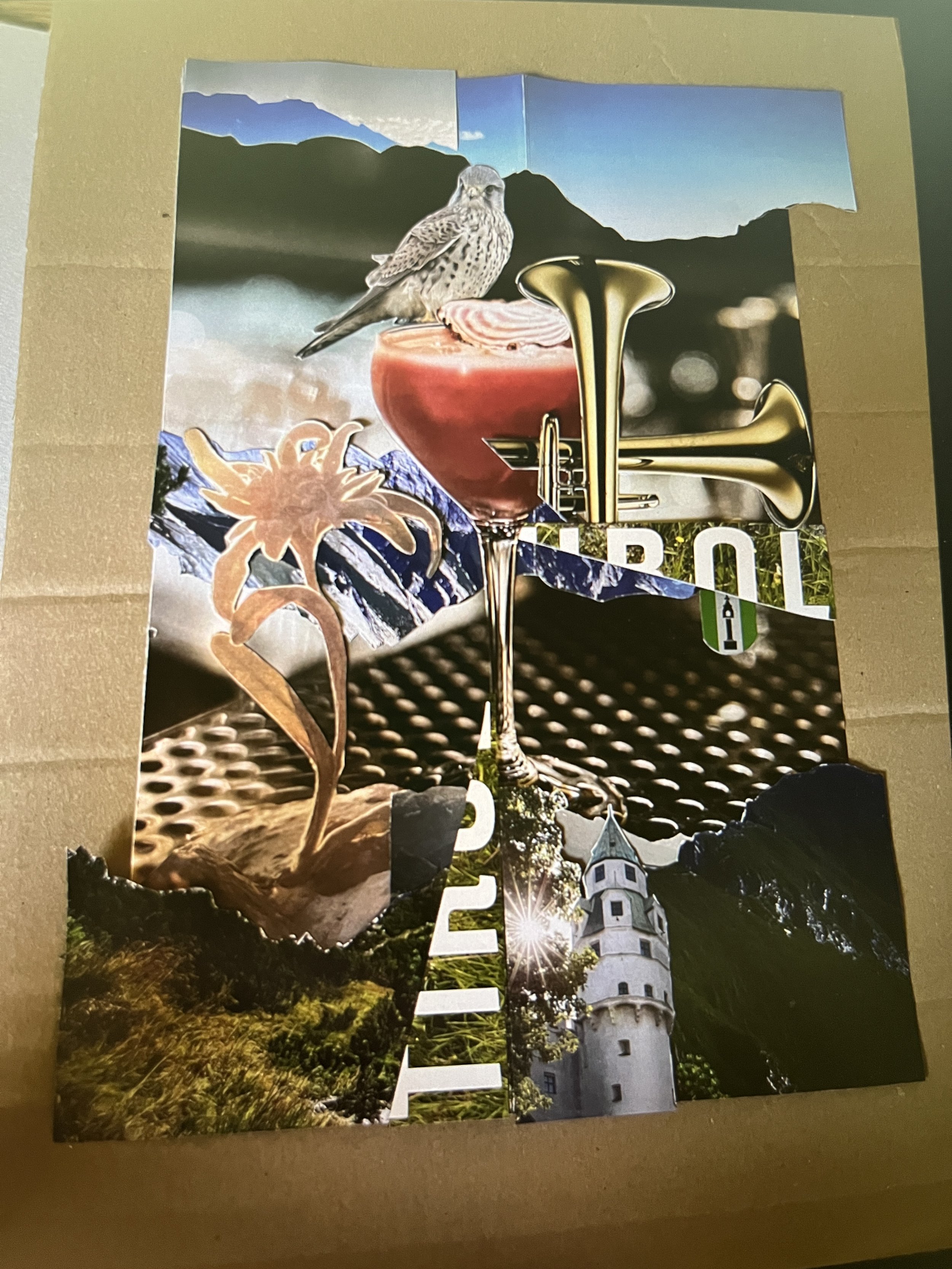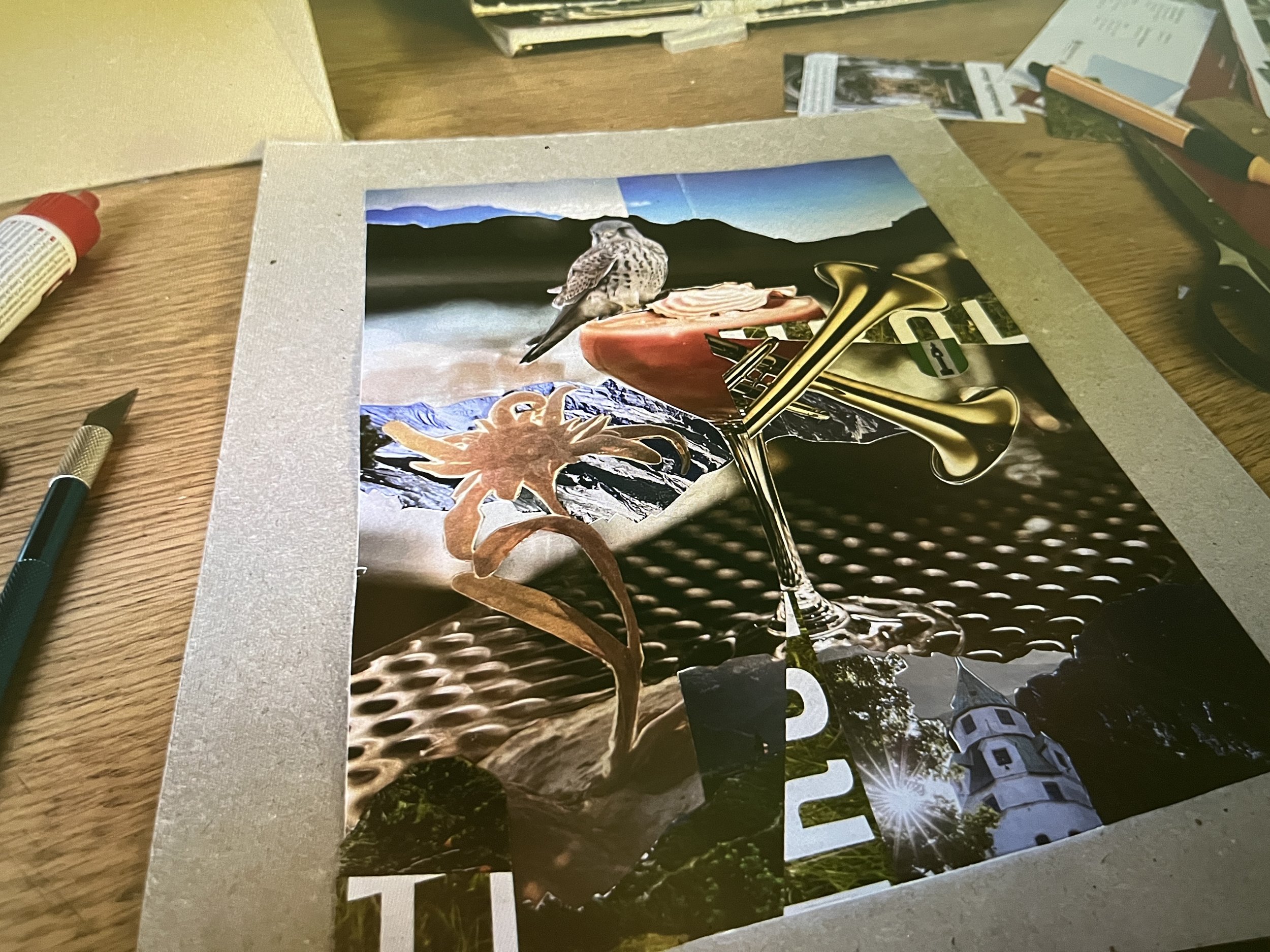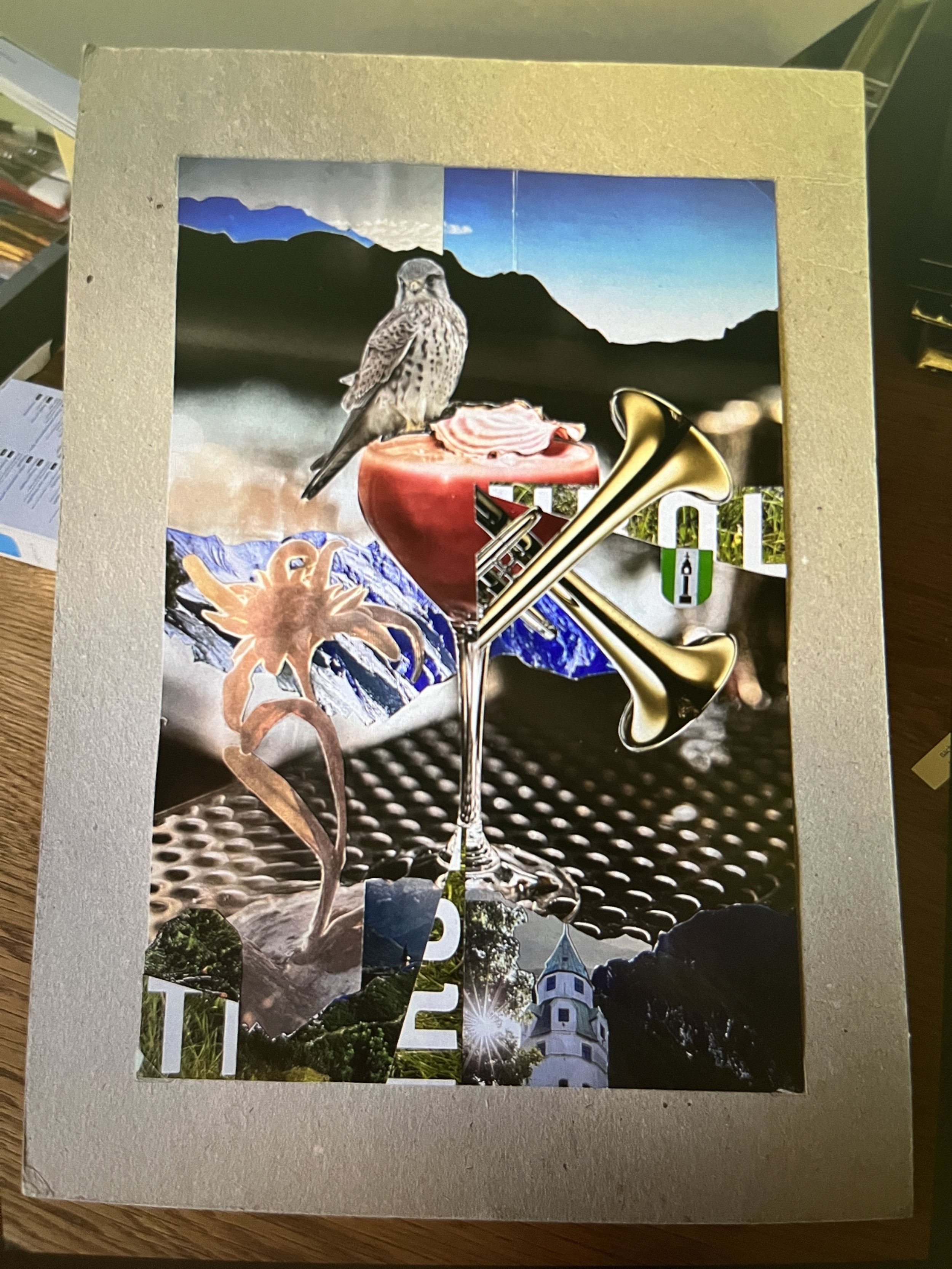#12 Art On The Way, Jelling, DENMARK
..about travelling
Jelling behalte ich in besonderer Erinnerung. Nicht nur wegen der frühgeschichtlichen Grabhügel und Runensteine, dem modernen Wikinger Museum, das kostenfrei zu besuchen ist und einen tiefen Einblick in die Wiege Dänischer Urkultur gibt. Die Stätten gehören übrigens seit 1994 zum UNSECO Kulturerbe. Sondern auch wegen der speziellen Situation mit unserem Truck Hartmut. Aber dazu gleich mehr.
Jelling befindet sich etwa 80 Kilometer nördlich von Aabenraa, unserem letzten Stopp und ist vor allem bekannt für die frühzeitlichen Spuren der Wikinger. Der voraussichtlich erste König Dänemarks, König Gorm, soll dort gewirkt haben. Dies zeugt insbesondere ein Runenstein, datiert auf 950 vor Christus, gewidmet seiner Frau Thyra verfasst von König Gorm – der Taufstein Dänemarks.
Fun Fact an dieser Stelle: Sein Sohn und Nachfolger Harald Blauzahn ist Namensgeber der Bluetooth-Technologie dessen Zeichen die Zusammensetzung der beiden Anfangsrunen des Vor- und Nachnamens Haralds bilden.
König Gorm soll im nördlichen Hügel der beiden Grabhügel, die direkt neben dem Museum liegen, begraben worden sein. Später baute sein Sohn ein steinernes Schiff und einen 1,5 Kilometer langen Palisadenzaun um den Grabhügel seines Vaters. Laut den Aufzeichnungen liegt Harald im Südhügel begraben. Eine bewegende Stätte der Wikingerkultur.
I have special memories of Jelling. Not just because of the prehistoric burial mounds and rune stones, the modern Viking Museum, which can be visited free of charge and gives a deep insight into the cradle of Danish prehistoric culture. The sites have been part of the UNSECO cultural heritage since 1994. But also because of our special situation with our truck Hartmut. But more on that in a minute.
Jelling is located about 80 kilometers north of Aabenraa, our last stop, and is best known for the early traces left there by the Vikings. The probably first king of Denmark, King Gorm, is said to have worked there. This is evidenced in particular by a rune stone, dated to 950 BC, dedicated to his wife Thyra and written by King Gorm - the baptismal font of Denmark.
Fun fact at this point: His son and successor Harald Bluetooth is the namesake of Bluetooth technology, whose symbols form the composition of the two initial runes of Harald's first and last name.
King Gorm is said to have been buried in the northern hill of the two burial mounds that lie directly next to the museum. Later, his son Harald Bluetooth built a stone ship and a 1.5 kilometer long palisade fence around his father's burial mound. According to the records, Harald is buried in the south hill. A moving site of Viking culture.
Zurück zu unserem Hartmut. Das Museum bietet einen großzügigen Parkplatz für Wohnmobile an, nur wenige Schritte vom Haupteingang entfernt. Dort finden wir uns ein, besuchen zum ersten Mal das Museum und das Areal um die Grabhügel. Das Wetter ist schön, wir genießen den Sonnenuntergang auf unserem Dach.
Back to our Hartmut. The museum offers a spacious parking lot for RVs, just a few steps from the main entrance. We find ourselves there and visit the museum and the area around the burial mounds for the first time. The weather is nice, we enjoy the sunset on our roof.
Ein letztes Mal Durchatmen, bevor ich am nächsten Morgen als erster früh aufwache und den Wagen verlasse, um ein paar sportliche Übungen zu machen. Kaum ausgestiegen weiß ich, warum mir die Lage unseres Trucks merkwürdig vorkommt, denn der rechte Reifen auf der dritten Achse ist komplett von der Felge gerutscht. Ein Platten – sofort kommen mir die Bilder des ersten Pitstops von vor wenigen Wochen in Sinsheim in den Kopf. Seitdem reparierten wir den Ersatzreifen nicht. Mir schien damals das Risiko eines weiteren platten Reifens gering. Eine Reparatur sollte direkt nach unserem Dänemark Aufenthalt in Deutschland stattfinden. Hmm…
One last breath before I wake up early the next morning and get out of the car to do some exercise. As soon as I got out, I realized why the position of our truck seemed strange to me, because the right tire on the third axle had completely slipped off the rim. A flat tire - the images of the first pit stop from a few weeks ago in Sinsheim immediately come to mind. Since then we have not repaired the spare tire. At the time, the risk of another flat tire seemed low to me. A repair should take place in Germany immediately after our stay in Denmark. Hmm…
Ich stütze also die Achse mit dem Stempelwagenheber ab und rufe den ADAC Truckservice. Einige Stunden später kommt Zach, ein junger Däne, Anfang zwanzig, mit dem Servicemobil und großen Augen auf den Schotterplatz: „What a truck!“. Wir demontierten den Reifen, eine Vorort-Reparatur ist nicht möglich. Zach nimmt den Reifen samt Felge mit in die Werkstatt, die etwa 20 Kilometer entfernt in Vejle liegt. Wir besprechen uns kurz. Er meldet sich, wenn der Reifen wieder intakt ist. Bis dahin ist mir das eigentliche Reifenproblem, weder aus der ersten noch aus dieser Reifenpanne nicht bekannt. Es stellt sich schnell heraus, nicht der Reifen, sondern das Ventil der schlauchlosen Reifen ist defekt. Es wäre ein leichtes, das innenliegende Ventilteil zu ersetzen, jedoch daran liegt es nicht. Die gesamte Ventileinheit, die Verbindung von außen nach innen lässt Luft entweichen. Zach versucht die Teile zu besorgen. Am nächsten Tag kommt die Info, dass lediglich eine Bezugsquelle in Schweden die Bauteile anbietet – allerdings stammt die Info aus 2013. Keine Lösung. Da es sich um Teile aus ursprünglichem Militärbestand handelt, fragt Ole, Zachs Chef, beim dänischen Militär an. Ohne Erfolg. Wir beschließen einen passenden Schlauch in den Reifen zu ziehen, der nach einem weiteren Tag am Auto montiert ist.
So I support the axle with the jack and call the ADAC truck service. A few hours later, Zach, a young Dane in his early twenties, comes onto the gravel lot with the service vehicle and his eyes wide open: “What a truck!” We removed the tire, an on-site repair is not possible. Zach takes the tire and rim with him to the workshop, which is about 20 kilometers away in Vejle. We'll talk briefly. He will let me know when the tire is ready again. Until then, I don't know the actual tire problem, either from the first puncture or from this one. It quickly turns out that it is not the tire that is defective, but the valve on the tubeless tires. It would be easy to replace the internal valve part, but that's not the problem. The entire valve unit, the connection from outside to inside, allows air to escape. Zach tries to get the parts. The next day we received information that only one source in Sweden offered the components - but the information was from 2013. No solution. Since these are parts from original military stock, Ole, Zach's boss, asks the Danish military. Without success. We decide to put a suitable tube in the tire, which is installed on the car after another day.
Währenddessen ist Miri, meine Frau, mit unseren Kindern unterwegs. Dauergast im Museum und in der Bücherhalle, bei freiem Internetzugang. Miri und die Kinder sind vergnügt. Das ist wichtig.
Meanwhile, Miri, my wife, is traveling with our children. Permanent guest in the museum and in the library, with free internet access. Miri and the children are happy. This is important.
Die Nacht soll ruhig werden. Um 1:00 Uhr nachts stehe ich bildlich gesprochen senkrecht im Bett, geweckt von einem Zischen. Ich springe aus dem Bett vor den Wagen und sehe zu, wie die Luft aus dem reparierten Reifen von sechs auf null bar innerhalb einer Minute entweicht. Bravo. Alles wieder auf Anfang.
Ich stelle mir einen Wecker auf sechs Uhr morgens, um den Wagenheber anzusetzen. Gesagt getan. Dann spreche ich mit Zach. Er nimmt den Reifen wieder mit. Ich hole mir währenddessen Rat bei einigen Bekannten, die sich auskennen. Die Lösung soll die Erstellung einer Adapterplatte mit neuem Ventil sein. Dafür sind alle Bauteile vorhanden und Franz, Maschinentechniker und Ingenieur aus der Steiermark. Er ist einen Tag zuvor mit seiner Frau auf ‚unserem‘ Wohnmobilplatz am Museum angekommen und unterstützt mit Verstand und Herzblut. Mit ihm fahre ich zur Werkstatt nach Vejle, um die Reparatur an der Felge selbst vorzunehmen. Wir staunen nicht schlecht. Die Werkstatt von Zach und Ole, besteht aus einem großen Hallenkomplex, ausgestattet mit allem was wir brauchen, um unser Reparaturvorhaben umzusetzen.
Aus einer zurecht geschnittenen und passend gebogener Aluminiumplatte, mit eingesetztem, neuem Ventil bauen wir eine Adapterplatte. Sie hält die Luft im Reifen. Wir verkleben sie mit der Felge und lassen sie einen Tag trocknen.
Am nächsten Tag setzen Franz und ich die Felge auf die Achse. Im Anschluss schieben wir den Reifen mit Mühe und Not auf die Felge, er alleine wiegt an die 200 Kilo, und fixieren ihn mit dem Felgenring auf der Felge. Jetzt wird es aufregend: Um den Reifen an die äußeren Ränder der Felge zu drücken, so dass die Luft im Reifen verbleibt, müssen wir ihn auf die Felge sprengen. Zur Vorbereitung lassen wir Hartmut an. Wir brauchen den Luftdruck des Autos, um während des Aufsprengens bereits Luft in den Reifen strömen zu lassen. Gesagt getan, der Luftschlauch sitzt am Ventileinlass. Für die Zündung nutzen wir Bremsenreiniger, den ich großzügig in den Reifen und eine Lunte am Reifen entlang sprühe. Jetzt geht alles schnell. Die zuvor ebenfalls mit Bremsenreiniger eingesprühte Dachlatte angezündet, an die Lunte gehalten und Peng. In einem Bruchteil einer Sekunde findet eine Verpuffung im Reifen statt, die ihn auf den äußeren Rand der Felge drückt. Die einströmende Luft fixiert ihn. Ein Kabelbinder hält den Reifenfüller konstant gedrückt. Bei sechs bar Druck stoppe ich die Luftzufuhr. Franz und ich entscheiden uns den Ersatzreifen auch noch mit einer selbstgebauten Adapterplatte zu versehen. Wir sprengen ihn ebenfalls auf den Reifen. Dafür bleiben Franz und seine Frau noch einen Tag länger. Gesagt getan. Wir verabschieden uns am anderen Tag.
The night should be quiet. At 1:00 a.m. I'm standing vertically in bed, woken up by a hissing noise. I jump out of bed in front of the car and watch as the air escapes from the repaired tire from six to zero bar within a minute. Bravo. Everything back to the beginning.
I set an alarm for six in the morning to put the jack on. Said and done. Then I'll talk to Zach. He takes the tire back with him. In the meantime, I'm getting advice from a few friends who know their stuff. The solution should be to create an adapter plate with a new valve. All the components are there and Franz, a mechanic and engineer from Styria. He arrived at 'our' mobile home site at the museum with his wife the day before and supported us with his mind, heart and soul. I drive with him to the workshop in Vejle to repair the rim myself. We're amazed. Zach and Ole's workshop consists of a large hall complex, equipped with everything we need to implement our repair project. We build an adapter plate from a cut and bent aluminum plate with a new valve inserted. It keeps the air in the tire. We glue them to the rim and let them dry for a day.
The next day Franz and I put the rim on the axle. We then push the tire onto the rim with great difficulty - it alone weighs around 200 kilos - and fix it to the rim with the rim ring. Now it gets exciting: In order to push the tire to the outer edges of the rim so that the air stays in the tire, we have to blow it up onto the rim. We start Hartmut’s engine. We need the car's air pressure to allow air to flow into the tire during inflation. Said than done, the air hose is located at the valve inlet. For ignition we use brake cleaner, which I spray generously into the tire and a fuse along the tire. Everything is happening quickly now. I lit the roof batten, which had also previously been sprayed with brake cleaner, held it to the fuse and bang. In a fraction of a second, a deflagration occurs in the tire, which pushes it onto the outer edge of the rim. The incoming air fixes him. A cable tie keeps the tire inflator constantly pressed. At six bar pressure I stop the air supply. Franz and I decide to add a self-made adapter plate to the spare tire as well. We'll blow him up on the tire too. Franz and his wife stay one more day. We say goodbye the next day.
Den Ersatzreifen wuchte ich unter Aufsicht von Theis, einem Dänen, der seit einigen Monaten in seiner umgebauten Mercedes Feuerwehr aus den 80er Jahren durch Dänemark reist, unter unser Auto. Ich sah ihn das erste Mal auf der Straße fahrend, als er mit seinem knallroten Rüstwagen an unserem Parkplatz vorbeifuhr. Wir winkten uns zu. Dass ich ihn noch einmal wiedersehen würde, war mir zu dem Zeitpunkt nicht gewahr.
Über Theis könnte man ein eigenes Kapitel schreiben. Er war Bauunternehmer und packte selbst mit an bis er vor über zehn Jahren einen schweren Unfall erlitt und seitdem mit einem gebrochenen Rücken lebt. Die ständigen Schmerzen hält er nur unter Einwirkung von starken Schmerzmitteln aus. Seine Frau verließ ihn vor vielen Jahren. Thies entschied erst vor ein paar Monaten aus dem Trott des Kopenhagener Großstadtfiebers auszutreten und kaufte sich eine Ausrüstung, um selbstgemachten Glasschmuck herzustellen, den er auf lokalen Märkten anbietet. Miri und jedes der Kinder durften sich eine Halskette aussuchen, die alle Unikate sind. Er lebt bescheiden. Wir lernen uns kennen. Er erzählt mir seine Geschichte. Vor seinem Unfall hatte er eine Menge kreativer Geschäftsideen. Theis war nahe dran, hatte bereits einen millionenschweren Sponsor, um eine vielversprechende Businessidee umzusetzen bis er einen Nervenzusammenbruch erlitt. Rausziehen und Ruhe halten, hieß es von da dann. Der Sponsor sprang ab, das Geschäft blieb unrealisiert. Ich versprach ihm die Idee für mich zu behalten – und wünsche ihm jeden Tag weniger Schmerzmittel und viele Menschen, die sich für seine Glaskunst interessieren. Theis gehört zu denen, die viel erleiden und doch eine positive Haltung zum Leben besitzen, Wege finden mit den Umständen umzugehen und Hilfe anbieten. Danke Theis.
I heaved the spare tire under our car under the supervision of Theis, a Dane who has been traveling through Denmark for several months in his converted Mercedes fire department truck from the 80s. The first time I saw him driving on the road was when he drove past our parking lot in his bright red rescue truck. We waved to each other. At the time, I had no idea that I would see him again.
I could write a separate chapter about Theis. He was a building contractor and pitched in himself until he suffered a serious accident over ten years ago and has lived with a broken back ever since. He can only endure the constant pain under the influence of strong painkillers. His wife left him many years ago. It was only a few months ago that Thies decided to break out of the Copenhagen city chaos and bought equipment to make homemade glass jewelry, which he sells at local markets. Miri and each of the children were allowed to choose a necklace, all of which are unique. He lives modestly. We get to know each other. He tells me his story. Before his accident, he had a lot of creative business ideas. Theis was close and already had a million-dollar sponsor to implement a promising business idea until he got a nervous breakdown. From there he needed to pull out and keep calm. The sponsor dropped out and the deal remained unrealized. I promised him that I would keep the idea to myself - and I wish him fewer painkillers every day and many people who are interested in his glass art. Theis is one of those who suffer a lot and yet has a positive attitude towards life, finds ways to deal with the circumstances and offers help. Thanks Theis.
Solche Begegnungen passieren zu Hauf. Ich hätte noch Sven und Katrin, ein Pärchen aus Dortmund, erwähnen können, oder die freundliche ältere Dame aus der Nachbarschaft in Jelling, die zweimal vorbeikam, um Hilfe anzubieten. Genauso wie Michelle, den kleinen Italiener, der mit seiner Frau unterwegs Campingurlaub in Dänemark unternahm und ebenfalls ein Reifenproblem bekam, das wir lösten. Da war auch noch Dick mit seiner zierlichen Frau Eloise, ein Brite, wie er im Buch steht oder Ingo und Janine, die ein Problem mit Ihrem Reisemobil hatten und zeitweise neben uns standen. Alessandro, ein Holländer mit seiner Frau und so weiter. Alle waren da, kamen und gingen. Gegenseitige Unterstützung gab es immer.
Such encounters happen a lot. I could have mentioned Sven and Katrin, a couple from Dortmund, or the friendly older lady from the neighborhood in Jelling who came by twice to offer help. Just like Michelle, the little Italian guy who went on a camping holiday in Denmark with his wife and also had a tire problem, which we solved. There was also Dick with his petite wife Eloise, a typical British guy, Ingo and Janine, who had a problem with their motorhome and were standing next to us for a while. Alessandro, a Dutchman with his wife and so on. Everyone was there, coming and going. There was always support.
Es geht weiter. Nach sechs Tagen Aufenthalt auf dem Parkplatz der Wikingermuseumsstätte in Jelling entscheiden wir direkt nach Deutschland zu fahren. Eigentlich wollten wir weiter in den Norden des Landes dann gen Westen, um dann wieder über die deutsche Grenze nach Süden zu reisen. Dänemark sieht uns sicher wieder.
Wir folgen der Einladung einer guten alten Freundin. Sie wohnt auf einem großzügig angelegten Hof mit angeschlossener Werkstatt. Eine gute Gelegenheit alle Ventile einmal zu prüfen und gegebenenfalls zu reparieren oder auszutauschen. Hier treffen auch unsere Kinder auf alte Freunde, bekannte Orte und eine Menge Unterhaltung am Hof.
It goes on. After spending six days in the parking lot of the Viking museum in Jelling, we decide to drive straight to Germany. We actually wanted to continue to the north of the country then west and then travel south again across the German border. Denmark will definitely see us again.
We accept the invitation of a good old friend. She lives on a spacious farm with an attached workshop. A good opportunity to check all valves and repair or replace them if necessary. Here our children also meet old friends, familiar places and a lot of entertainment on the farm.
..about creative process
Dort entsteht Collage #12 aus der Reihe Art On The Way. Thema ist Jelling und sein historisches Erbe – im Speziellen seine Bedeutung für die Dänen und die gesamte nordische Kultur. Ich fühle mich ihr verbunden. Vielleicht verlief der Entstehungsprozess aus diesem Grund in tiefer Ruhe und Gelassenheit.
Collage #12 from the Art On The Way series is created there. The topic is Jelling and its historical legacy - in particular its importance for the Danes and the entire Nordic culture - I personally feel connected to. Perhaps for this reason the creation process took place in deep peace and serenity.


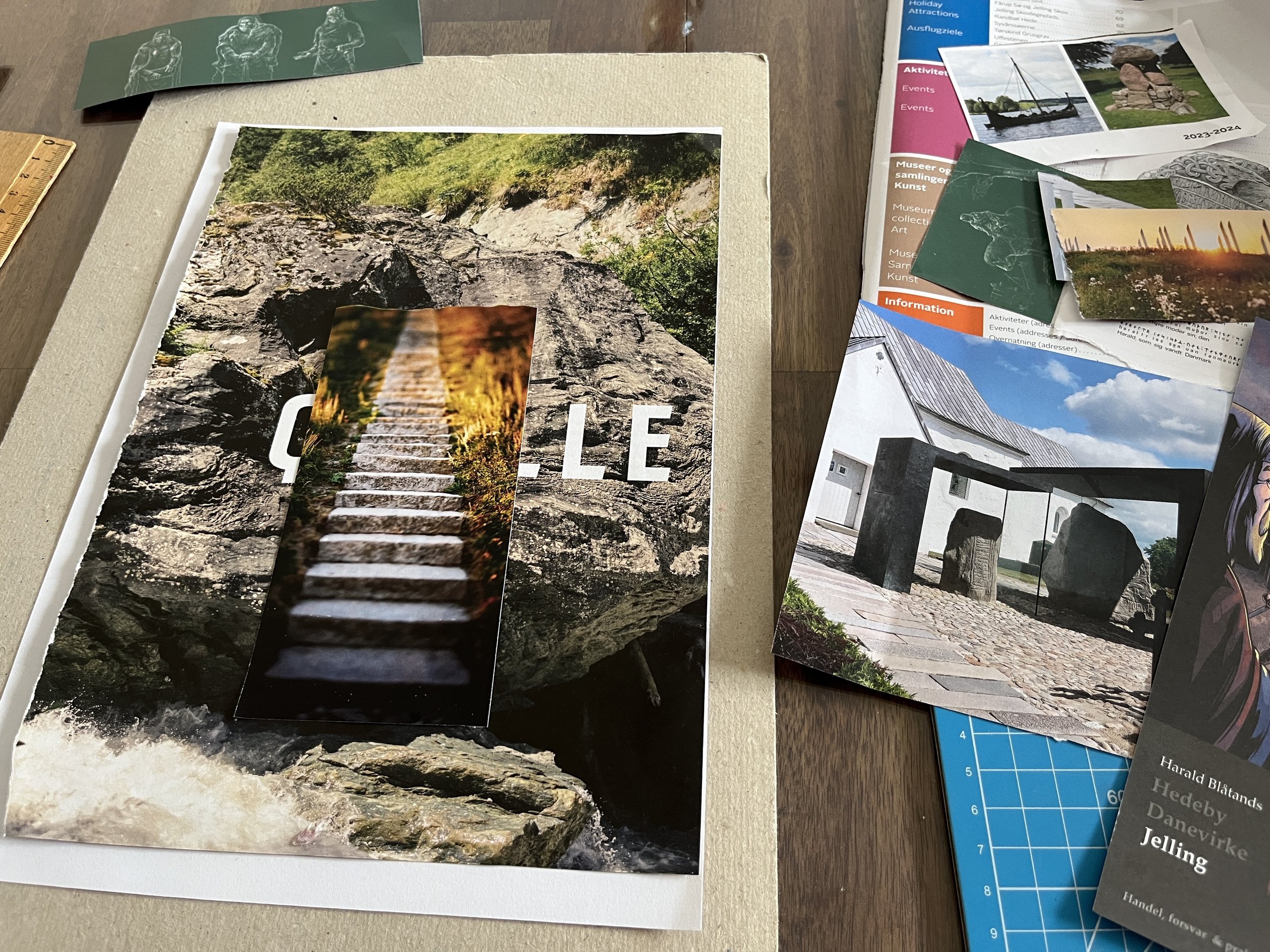
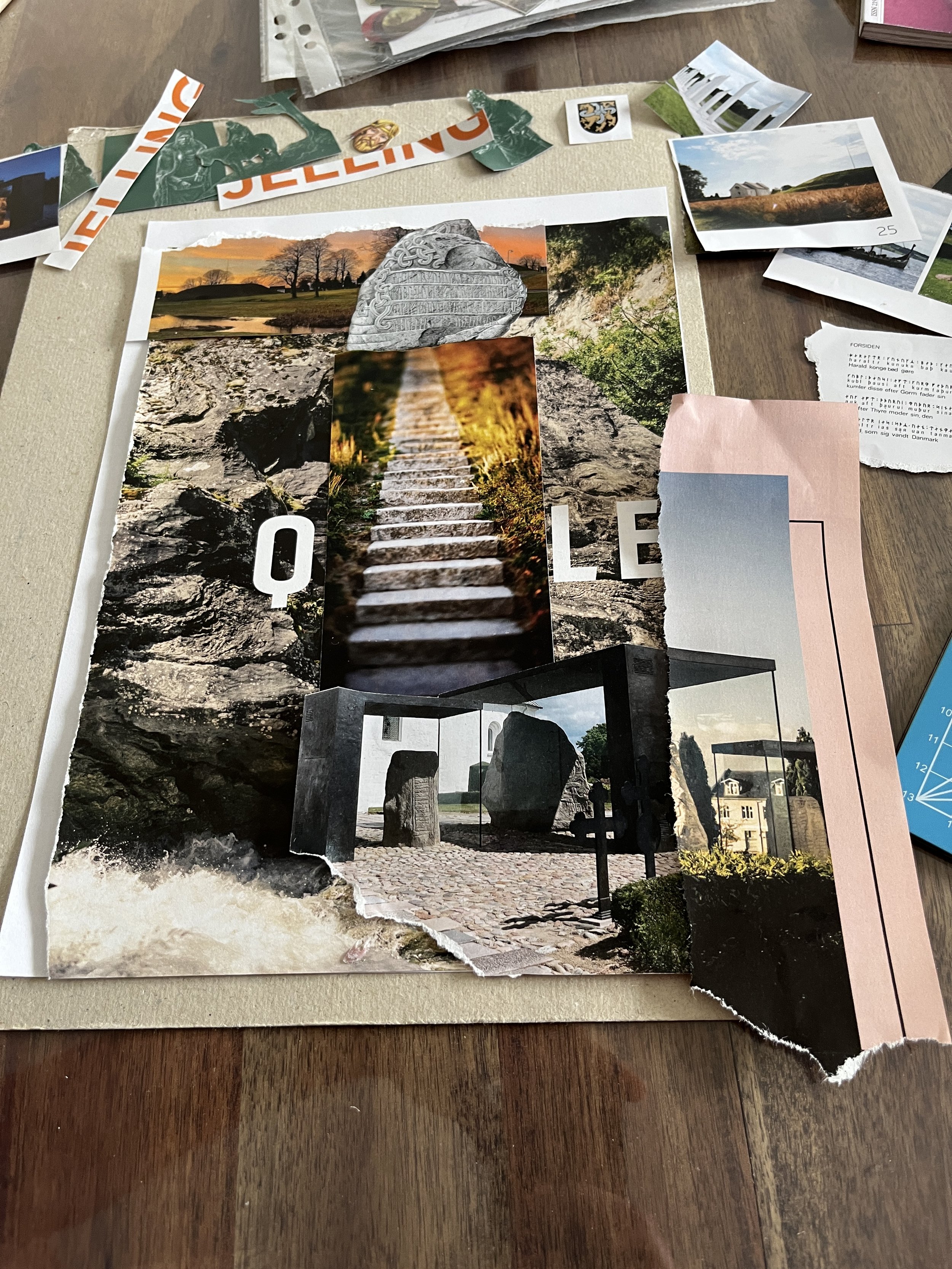


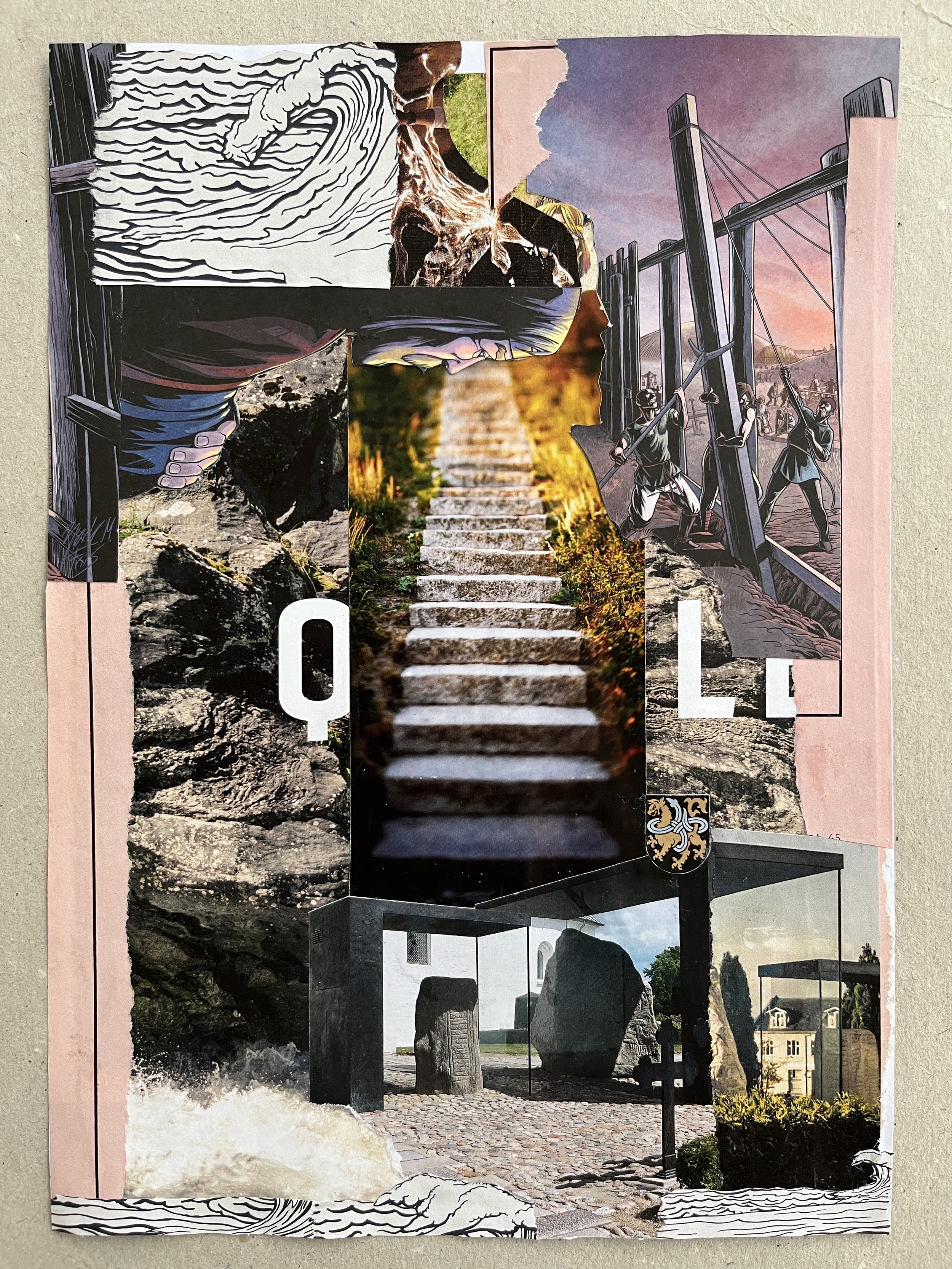

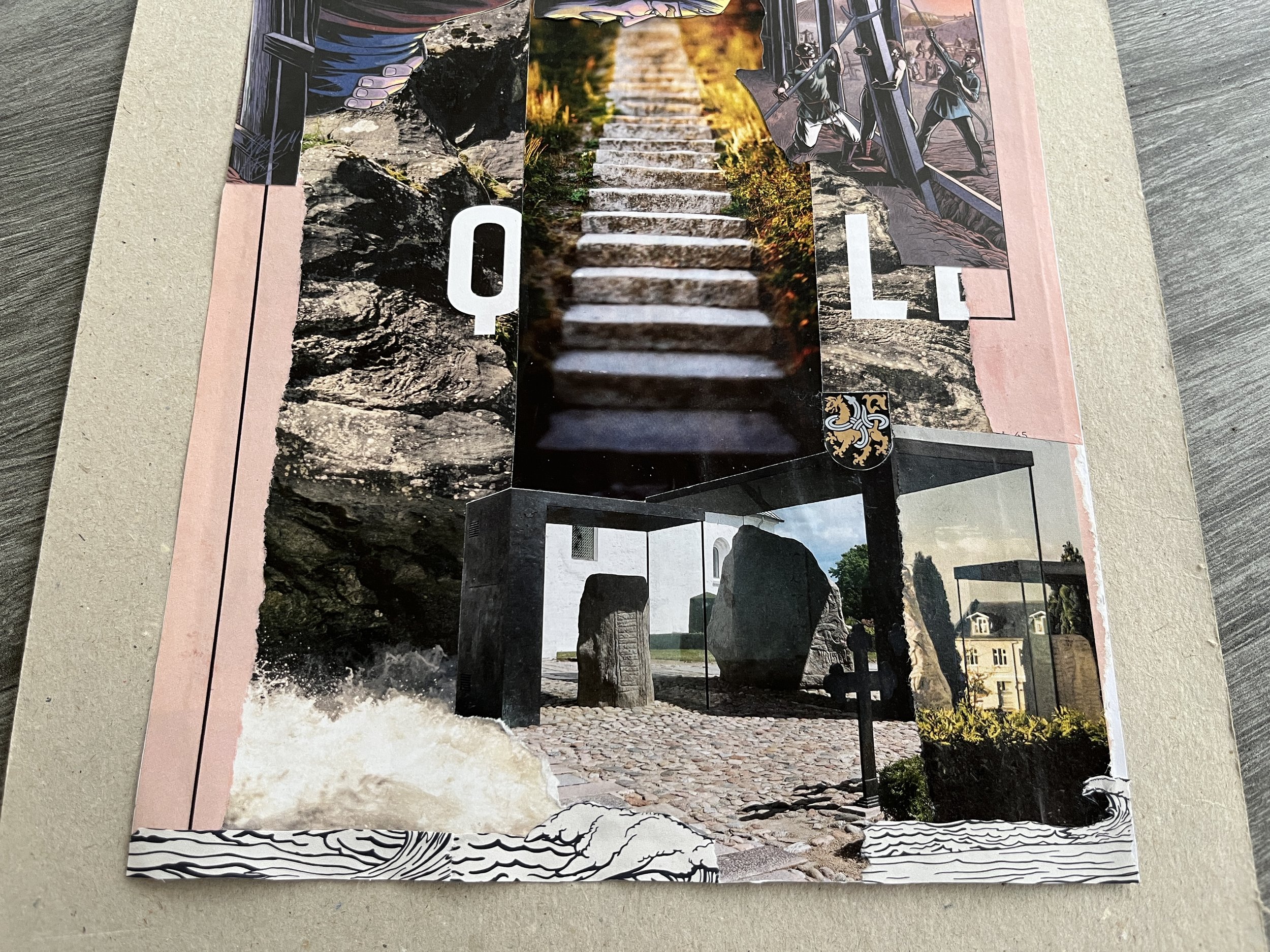
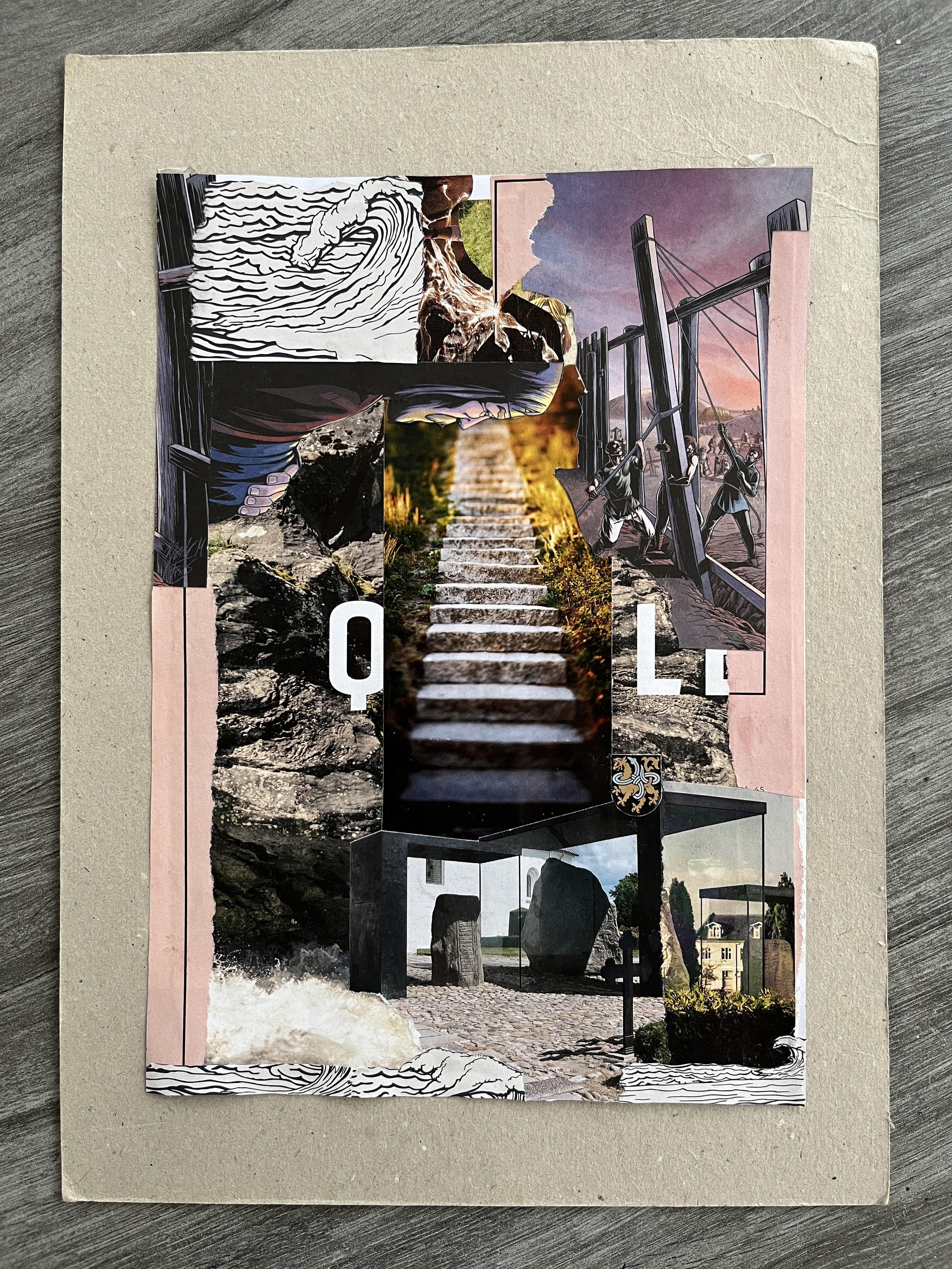
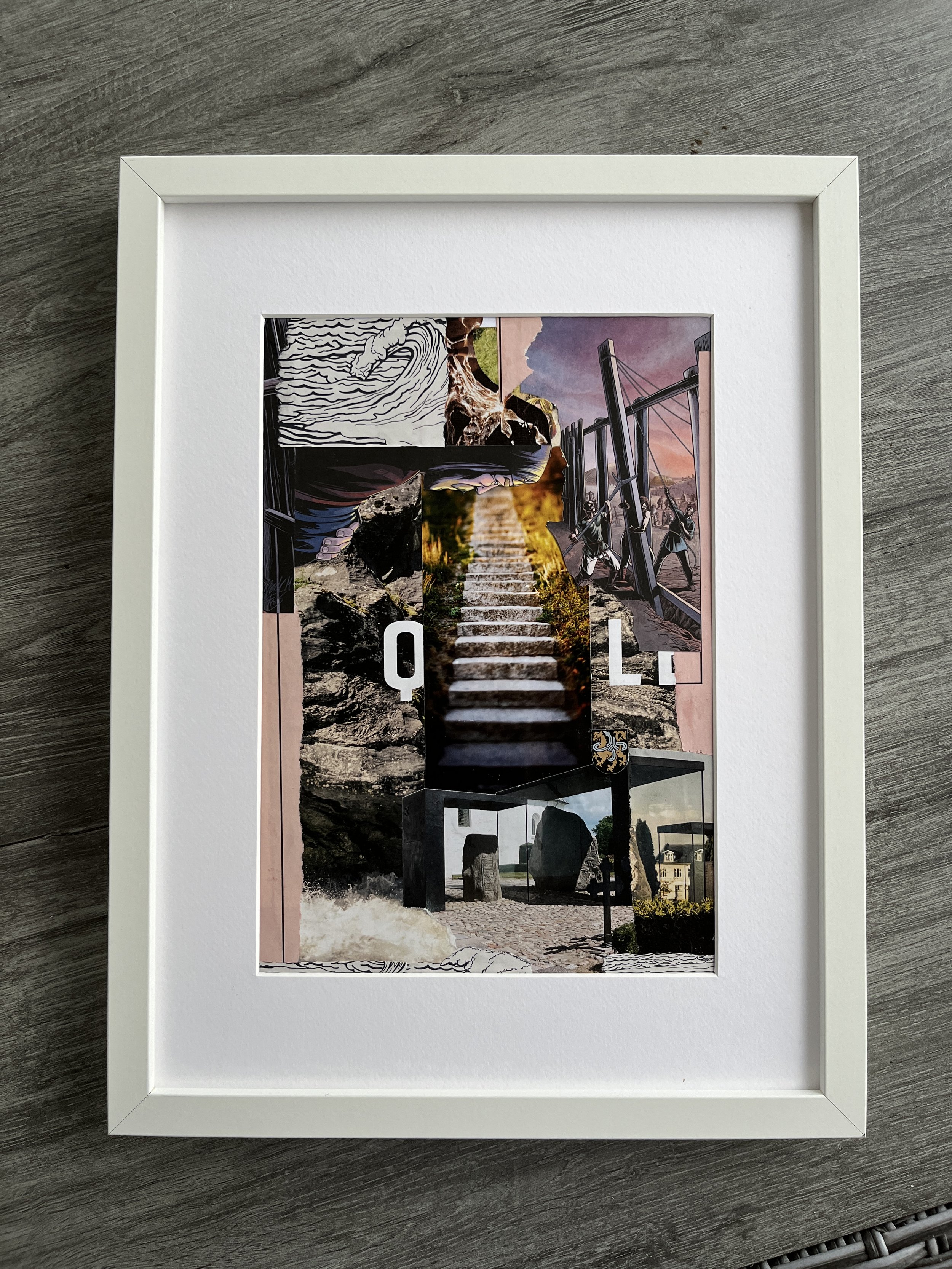
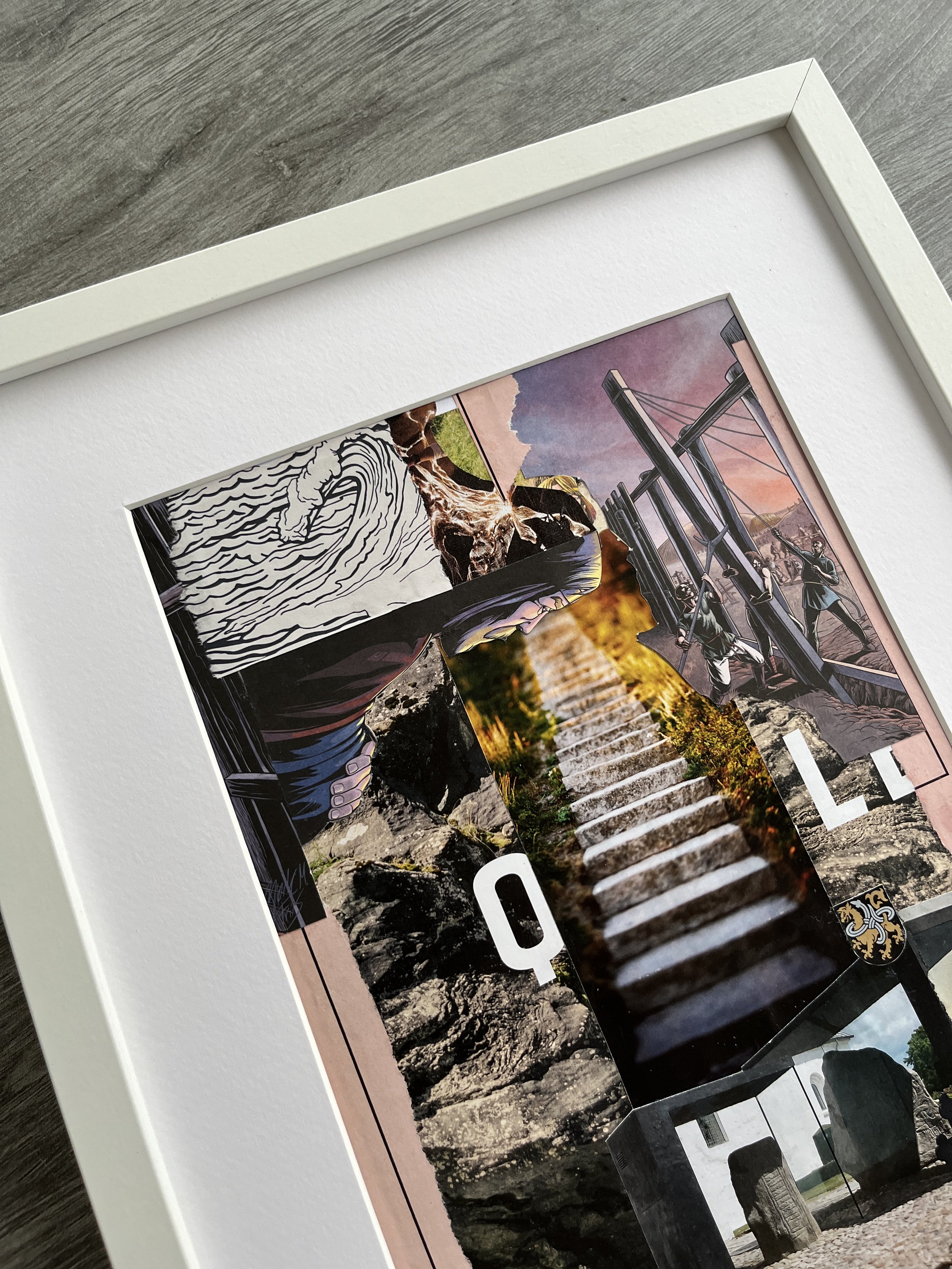
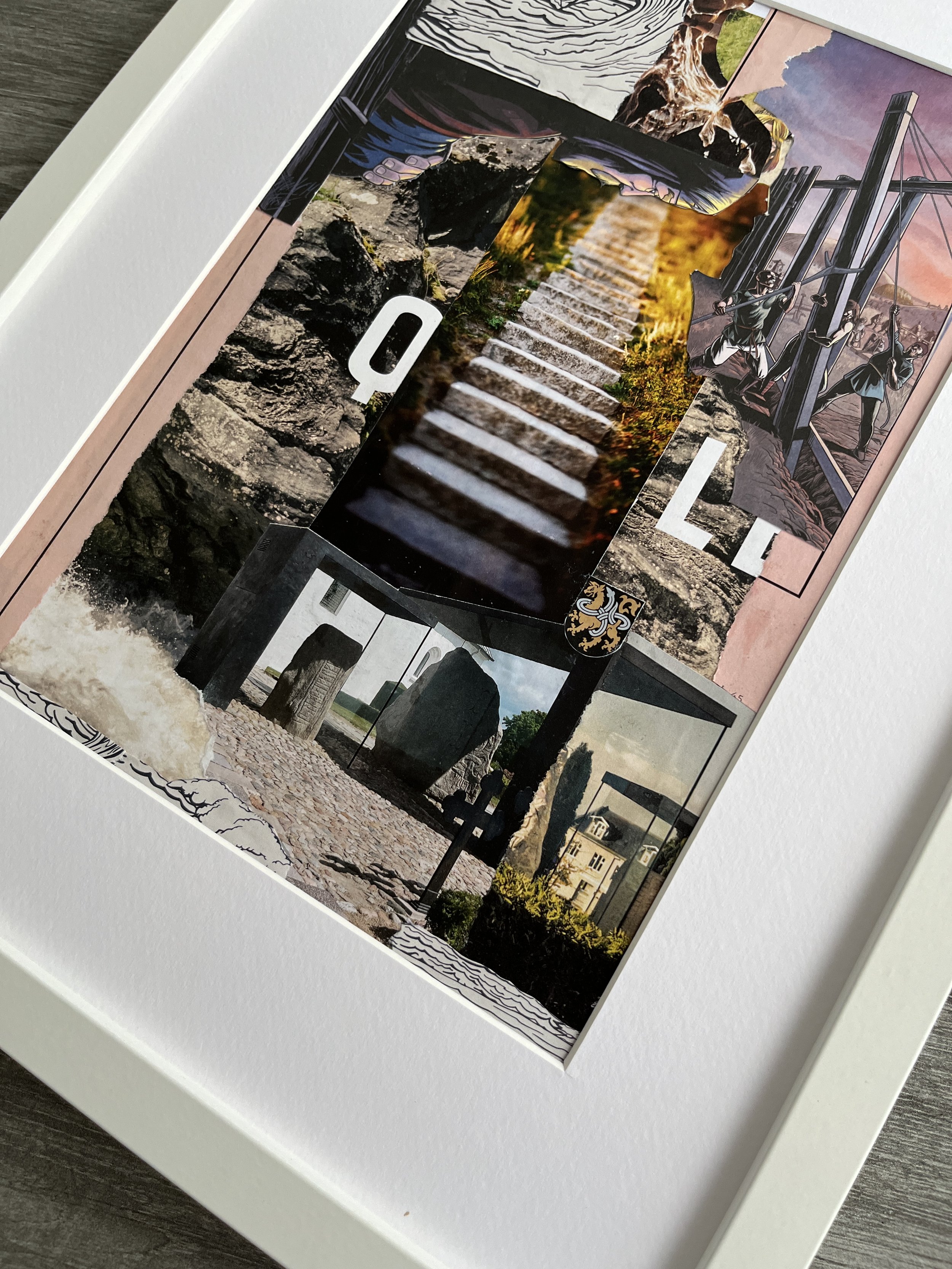
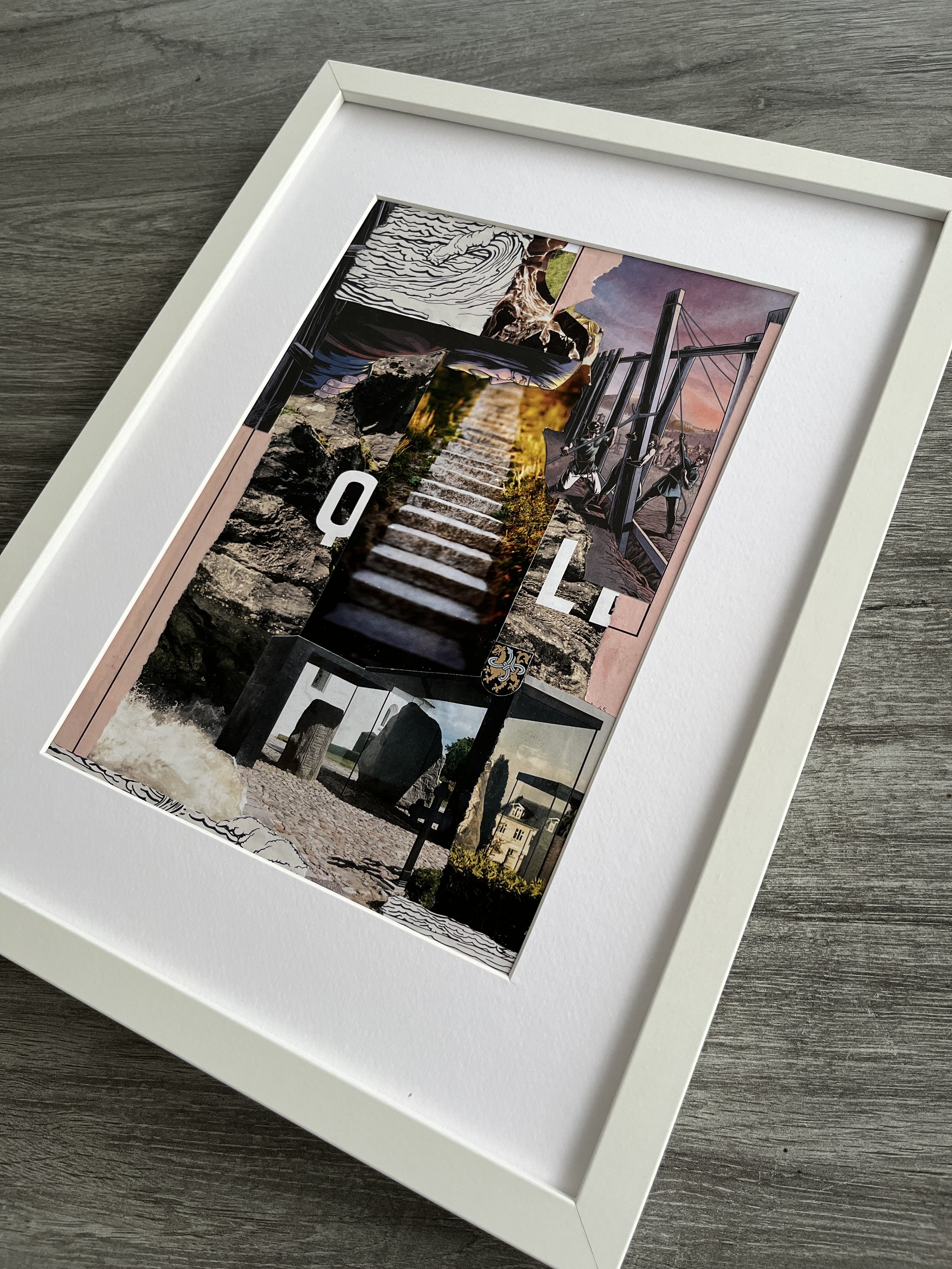

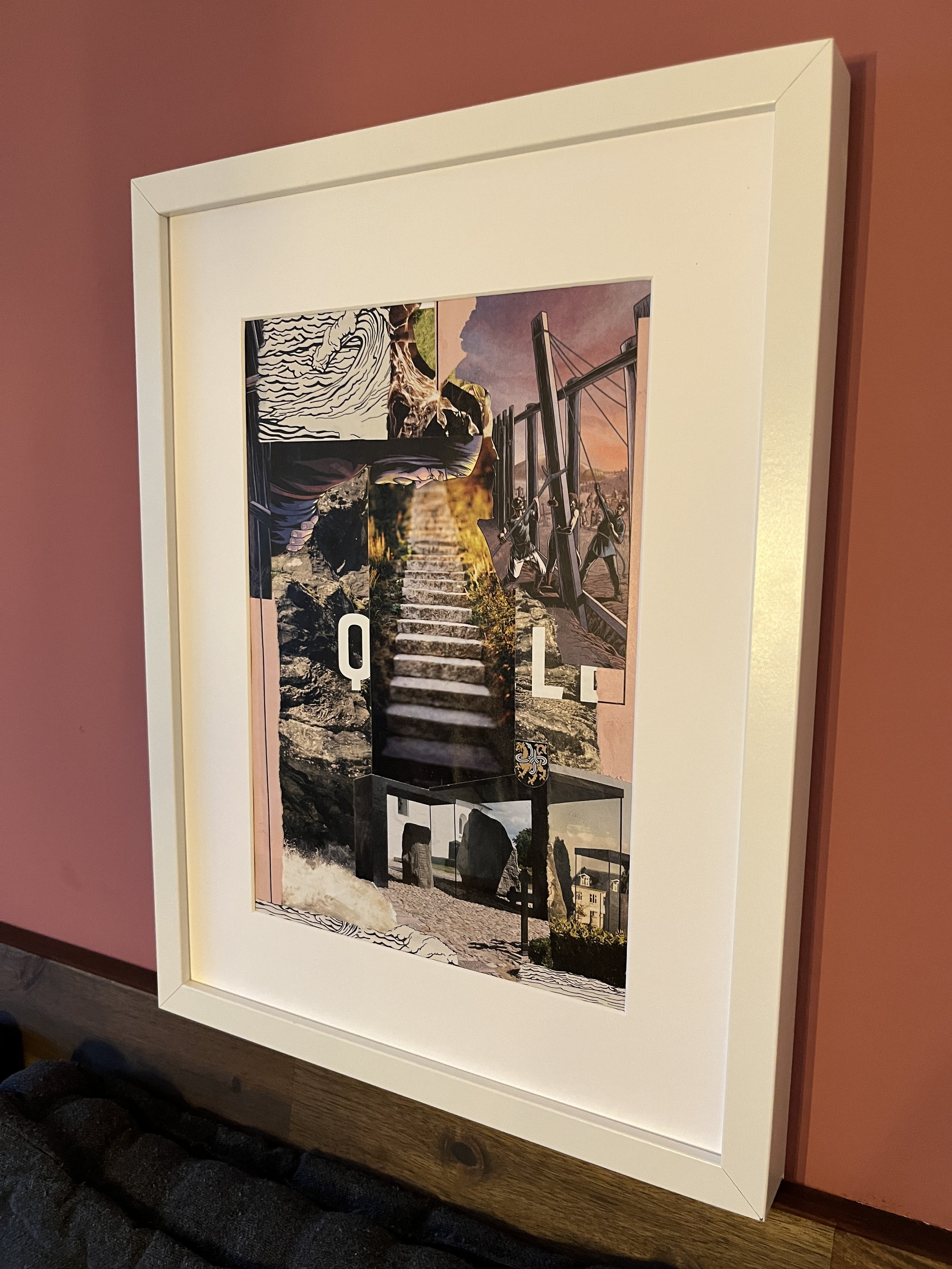
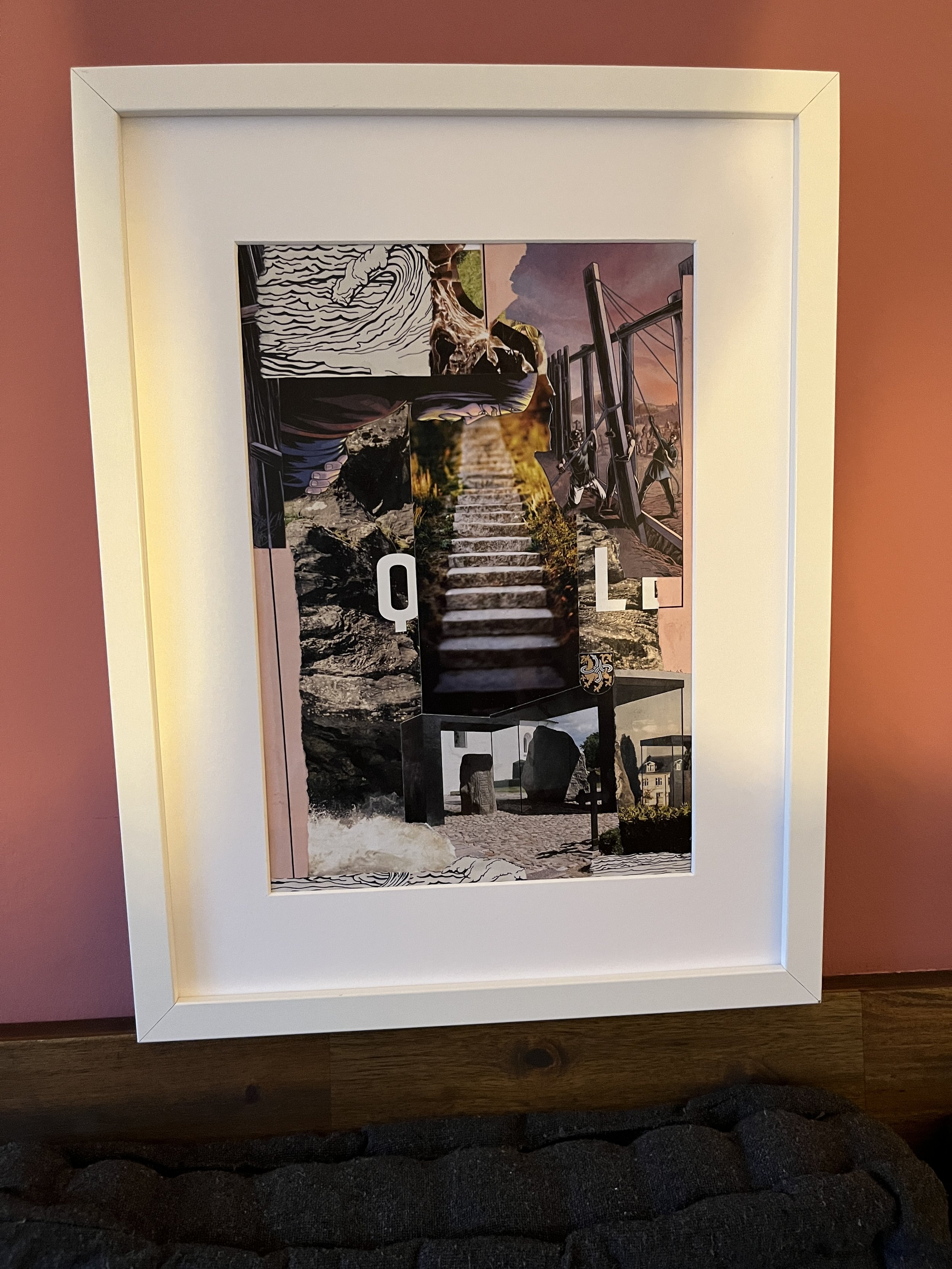
Die Farbgebung ist dezent. Die Elemente Feuer, Erde, Luft und Wasser untermalen die Mystik der alten Zeit. Die Steintreppe zum Plateau einer der beiden Grabhügel bildet das optische Zentrum. Darunter Fragmente des deutschen Worts ‚Quelle‘. Der Gründerstein Dänemarks zeigt sich im Tageslicht. Die Anstrengung der altvorderen Wikinger beim Bau der Palisadenfestung in Jelling erfährt der Betrachter im Morgenrot. Ein weiterer Blickwinkel entsteht, wenn die Collage um 90 Grad gegen den Uhrzeigersinn gedreht wird. Das verwendete Material sammelt sich maßgeblich aus den Auslagen im Museum und der umgebenen Stätten in Jelling.
The coloring is subtle. The elements fire, earth, air and water underline the mysticism of ancient times. The stone staircase to the plateau of one of the two burial mounds forms the visual center. Including fragments of the German word 'Quelle'. The founding stone of Denmark can be seen in the daylight. The viewer experiences the efforts of the ancient Vikings in building the palisade fortress in Jelling at dawn. Another perspective is created when the collage is rotated 90 degrees counterclockwise. The material used comes mainly from the displays in the museum and the surrounding sites in Jelling.
#11 Classic the walk
#11 the walk ist in Dänemark, Nähe Aabenraa im Süden des Landes, im Atelier von Freunden entstanden (s. slideshow), bei denen wir für zwei Wochen zu Gast sind.
Unsere Reisepläne lassen uns für den Rest der Sommerzeit in Dänemark verweilen. In ein paar Tagen brechen wir auf nach Velje, etwa 80 Kilometer gen Norden, um altertümliche Wikinger Gräber zu besuchen.
Im Anschluß führt uns ein Spektakel der besonderen Art auf die Insel Rømø: Das jährlich stattfindende Motorfestival. Viele tausend Begeisterte feiern dort mehrere Tage den Kult historischer Autos und Krafträder. Das legendäre Strandrennen am Lakolk Beach ist für jedermann zugänglich, sowohl als Zuschauer, als auch als Fahrer. Begleitet durch eine Menge Party, Lindy Pop und Rock’n’Roll am Strand. Mehr dazu unter:
https://www.romomotorfestival.dk/://www.romomotorfestival.dk/
Schlussendlich fahren wir danach über Deutschland hinweg in den Süden Europas, um dort den Winter zu verbringen. So der aktuelle Plan.
#11 the walk was created in Denmark, near Aabenraa in the south of Denmark, in a studio of friends, where we stay for around two weeks - slideshow below.
Our travel plans let us spend the rest of the summertime in Denmark. In a few days we start to Vejle, about 80 kilometers north of Aabenraa, to visit some Viking graves. Then it's on to the isle of Rømø.
Afterwards, a very special spectacle takes us to the island of Rømø: the annual motor festival. Thousands of enthusiasts celebrate the cult of historic cars and motorcycles there for several days. The legendary beach race at Lakolk Beach is open to everyone, both as a visitor and as a driver. Accompanied by a lot of partying, lindy pop and rock'n'roll music on the beach.
More at: https://www.romomotorfestival.dk/
After that we finally drive across Germany to the south of Europe to spend the winter there. That's the current plan.
“The creation process wasn‘t easy. However, giving up was not an option, I took the challenge testing myself and made it.”
Zu Beginn trank ich Kaffee zum Ende der Entstehung von #11 landete ich bei Wein – ein sehr empfehlenswerter Tropfen (s. Fotos), der seinen Weg in die Collage übrigens ebenfalls fand. Kaffee für den Einstandsgenuss, den seichten Beginn. Der Prozess stellte sich jedoch als schwierig dar. Ich fand kaum Zugang, mir stand wenig kreatives Potenzial zur Verfügung, was sich auch an den Fotos erkennen lässt. Denn der Entstehungsprozess entwickelte sich von einem Motiv zum anderen: Die anfänglich zugrunde liegende Negativschablone einer weiblichen Kontur mit erhobenen Armen, als zentrales Element der Collage, ersetzte sich mit einer anderen Schablone. Dazwischen ein Menge anderes. Zwischen Ursprung und Resultat liegen jetzt Meilen - aber ist das nicht auch oft in der Kunst und im Leben so? Wie dem auch sei, erst nach einer Pause und einem Glas Wein schöpfte ich den Willen weiterzumachen.
Wie schon mit #10 machte ich meine Erfahrung, dass Kreativität nicht stets leicht fällt, kein Knopfdruckeffekt – gut, das sollte keine neue Erkenntnis sein - für viele von uns. Jedoch den Zustand von Unverbundenheit zum Objekt und Prozess unvermittelt zu erleben besitzt die Qualität des unmittelbaren Erfahrens. Der Gedanke für heute aufzugeben kam zuvor nur für Bruchteile. Es ist es mir wert, mich dem Anreiz der Herausforderung zu stellen, mich zu testen. Aufgeben ist keine Option und grundlegend gegen meine persönliche Einstellung. Grenzen versetzen schon. Und tatsächlich fand ich den Weg zum Objekt und bin jetzt um eine Erfahrung reicher.
Darüber hinaus ist es interessant zu beobachten, dass ein Kunstwerk reift. Ich stelle hierbei nicht auf den Entstehungsprozess eines Kunstwerks ab, hierfür würde ich eher den Begriff des Erwachsen nutzen - nein, vielmehr beziehe ich mich auf das Reifen am fertigen Kunstobjekt: Es reift über die Zeit im Kopf des Betrachters und verändert seinen Wert. Vielleicht besteht hierauf bezogen ein Zusammenhang zwischen der Schwierigkeit bzw. Leichtigkeit des künstlerischen Entstehungsprozesses und dem individuellen Wert, den das Kunstwerk im Auge des Betrachters im Laufe der Zeit und nach seiner Fertigstellung erlangt.
At the beginning I drank coffee, however at the end of the creation of #11 I ended up with wine - a highly recommended drop (see photos), which by the way also found its way into the collage. Coffee for the introductory pleasure, a smooth start. However, the process turned out to be difficult. I hardly had any access, I had just little creative potential at my disposal, which can also be seen in the photos. Because the process of creation developed from one motif to the next: the negative stencil of a female silhouette with raised arms, which was the central element of the collage, was replaced by another stencil - something completely different came out. Anyway, it was only after a break and a glass of wine that I found the will to continue.
As with #10, I made my experience that creativity doesn't always come easy, no button push effect - well, that shouldn't be a new realization - for many of us. However, experiencing the state of being disconnected from the object and process suddenly has the quality of direct experience. The thought of giving up came only for moments. I thought it could be worth taking on the challenge to test myself. Giving up is not an option and in general against my personal attitude. So move boundaries. And indeed I finally found the way to the object and I am now richer by experience.
In addition, it is interesting to watch a work of art mature. I'm not focusing on the process of creating a work of art, I would rather use the term to grow for this - no, I'm actually referring to the maturing of the finished art object: it matures over time in the viewer's mind and changes its value. Perhaps there is a connection between the difficulty or ease of the artistic creation process and the individual value that the work of art acquires in the eye of the beholder over time and after its completion.
#10 Classic Mon Chéri
Es fehlen die Bilder zur Entstehung der Collage, so sehr war ich mit der Erstellung beschäftigt – Mon Chéri war die bisher schwierigste Collage. Länger als üblich suchte ich nach dem kreativen Fluss und der Leichtigkeit im Komponieren der Fragmente in Harmonie mit den Inhalten. Die schwarz-weißen Darstellungen des Savoire Vivre der 1960er Jahre liegen mir am Herzen. Auf ihre Art zeitlos schön. Sie sollten bestimmen. Gleichzeitig suchte ich nach einem Weg die Leichtigkeit des Dargestellten, die Vergnügung der Protagonisten zu zeigen. Ich fand einen Weg im Farbenspiel. Doch bis dahin vergingen Stunden. Schlussendlich entstand hier eine der für mich bisher liebsten Kunstwerke aus meiner Hand.
Gewidmet einem guten alten Freund. Er war zur Stelle, als wir mit dem Ausbau unseres Trucks nicht weiterkamen, fasste den entscheidenden Gedanken und gab den richtigen Impuls. Er war in unserer Zeit in Tirol für mich und meine Familie da. Ein wahrer Freund.
Mittlerweile sind wir als reisende Familie nicht mehr in Tirol. Denn unser Truck ‚Hartmut‘ (s. Fotos) konnte dort fertiggestellt werden und bringt uns nun an andere Orte. Doch das Land Tirol, die herzlichen Menschen, die wir dort kennenlernen durften, die Gastlichkeit, der Frohsinn und die von der Schöpfung geküsste Natur sind überwältigend. Wir kommen sicher wieder.
The images of the making of the collage are missing, I was so busy creating it - Mon Chéri was the most difficult collage so far. For longer than usual I searched for the creative flow and ease in composing the fragments in harmony with the content. The black and white representations of 1960s savoir vivre are close to my heart. Timelessly beautiful in its own way. They should determine. At the same time, I was looking for a way to show the lightness of what was portrayed, the amusement of the protagonists. I found a way in the play of colors. But until then hours passed. In the end, one of my favorite works of art was created here.
Dedicated to a good old friend. He was there when we got stuck with the expansion of our truck, had the decisive idea and gave the right impulse. He was there for me and my family during our time in Tyrol. A true friend.
As a traveling family, we are no longer in Tyrol. Because our truck 'Hartmut' (see picture above) was completed there and now takes us to other places. But the state of Tyrol, the warm-hearted people we got to know there, the hospitality, the cheerfulness and the nature kissed by creation are overwhelming. We'll be back for sure.
#9 Art On The Way Tyrol, AUSTRIA
artmuth.com - #9 Art On The Way Collage dedicated to Tyrol, Austria
Eine weitere Art On The Way-Collage, gewidmet dem Land Tirol, in dem wir uns jetzt seit Ende Mai 2023 befinden – siehe #8.
Strukturell verwandt mit #8 Ampass Tirol, präsentiert sich #9 farblich gemischt mit rosa Pastell und Orange Akzenten. Die pure Schönheit Tirols im Sommer, facettenreich und lieblich wie ein erfrischer Sommercocktail, dennoch mit Ecken und Kanten, klar umrissen von Bergen – einige mit Gondeln zu erreichen, wie der Glungezer, die Sonnenspitze in den Tuxer Alpen, südöstlich der Landeshauptstadt Innsbruck, mit etwa 2.700 Höhenmetern. Übrigens ein empfehlenswerter und familienfreundlicher Spot, erschlossen mit Gondelstationen auf der Nordseite des Berges. Hier verbrachten wir erlebnisreiche Stunden bei strahlendem Sonnenschein mit Freunden und Kindern am hochgelegenen Speichersee – siehe Foto oben – und im Klettergarten auf 1.500 Höhenmetern.
Another Art On The Way collage dedicated to the state of Tyrol, which we have been in since the end of May 2023 - see #8.
Structurally related to #8 Ampass Tirol, #9 is mixed in color with pink pastel and orange accents. The pure beauty of Tyrol in summer, multifaceted and lovely like a refreshing summer cocktail, yet with rough edges, clearly outlined by mountains - some can be reached with gondolas, such as the Glungezer, the sunny peak in the Tux Alps, southeast of the provincial capital Innsbruck, with about 2,700 meters of altitude. By the way, a recommended and family-friendly spot, accessible with gondola stations on the north side of the mountain. Here we spent eventful hours in bright sunshine with friends and children at the mountain lake - see photo above - and in the climbing garden at 1,500 meters above sea level.
#8 Art On The Way Ampass, Tyrol, AUSTRIA
artmuth.com - #8 Art On The Way Collage dedicated to Ampass, Tyrol, Austria
Seit Ende Mai machen wir Station im wunderschönen Tirol (Österreich). Dort stellen wir Hartmut, unseren historischen LKW, mit dem wir auf Reisen gehen, fertig. Das wird bald soweit sein. Dafür stehe ich jeden Morgen früh auf und bringe den Ausbau voran. Daneben nutze ich jetzt endlich die Zeit für die Erstellung der ersten Art On The Way Collage. Richtig, obwohl wir schon seit November 2022 zwischen Dänemark und Österreich unterwegs sind, allerdings nicht mit unserem Hartmut, ist es die erste Collage dieser Art.
Ich widme mich in der #8 Tirol, im Speziellen Ampass, eine kleine Gemeinde mit etwa 2.000 Einwohnern, die zum Bezirk Innsbruck Land gehört und auf etwa 650 Höhenmetern liegt. Dort wohnen wir auf einem Drei-Generationenhof mit Landwirtschaft, Pferden, Hühnern und Katzen. Ein Idyll wie aus dem Bilderbuch mit Menschen, die uns sehr ans Herz gewachsen sind. Wer es kennt, entdeckt das Ampasser Wappen in der Collage. Trompeten stehen symbolisch für die traditionsreiche Tiroler Kapellenmusik, die sowohl hier am Hof, als auch überall in der Gegend zur gelebten Kultur Tirols gehört. Im Kontrast dazu das dargestellte Cocktailglas, als Zeichen urbaner Großstadtkultur, die sich in der Studentenstadt Innsbruck, mit seinen etwa 300.000 Einwohnern, findet. Umringt von Bergen, thronen Greifvögel über dem Land, das sich den Adler als Wappentier gab.
Das genutzte Material sammelt sich u.a. aus Broschüren und Zeitschriften des Touristenbüros der nahgelegenen Stadt Hall, ein gemütliches Städtchen vor den Toren Innbrucks, mit der größten Altstadt Tirols und bewegter Münzprägegeschichte.
Die Fotos heben den Entstehungsprozess der Collage hervor. Dabei ist generell gesprochen nicht wichtig, dass möglichst viel Material als Grundlage vorliegt. Im Gegenteil, je weniger davon, umso reizvoller für den kreativen Geist. Wie auf den Fotos zu beobachten, der Entstehungsprozess einer Collage folgt grundlegend einer klaren Chronologie: Vom Sichten des Materials, über das Selektieren, Ausschneiden, Komponieren bis zum Verkleben.
Since the end of May we have been stationed in beautiful Tyrol (Austria). There we complete Hartmut, our historic truck that we use to travel. Will be finished soon. That's why I get up early every morning and push the expansion forward. In addition, I'm finally using the time to create the first Art On The Way collage (#8). That's right, although we've been traveling between Denmark and Austria since November 2022, but not with our Hartmut, it's the first collage of this series.
I dedicate the artwork #8 to Tyrol, specifically Ampass, a small community with around 2,000 people belonging to Innsbruck Land district, located at around 650 meters above sea level. We live there on a three-generation farm with agriculture, horses, chickens and cats. An idyll straight out of a picture book with people we have learned to carry deep in our hearts.
Anyone familiar with Ampass will discover the coat of arms within the artwork. Trumpets are symbolic of the traditional Tyrolean folk music, which is part of the lived culture of Tyrol both here and everywhere in the area. In contrast to this, the cocktail glass shown, as a sign of urban metropolitan culture, which can be found in the student city of Innsbruck, with its approximately 300,000 inhabitants. Surrounded by mountains, birds of prey are enthroned above the country, which adopted the eagle as its heraldic animal.
The material used is collected, among other things, from brochures and magazines from the tourist office in the nearby town of Hall, a cozy little town just outside Innsbruck, with the largest old town in Tyrol and an eventful history of coinage.
The gallery above highlights the process of creating. Generally speaking, it is not important that as much material as possible is available as a basis. On the contrary, the less of it, the more attractive for the creative mind.
blog post #1 Intro
artmuth.com - It all starts with an idea.
blog post publishing date: 25th June 2023
I write the texts and blog entries in German, my mother tongue, and then translate them into English in order to reach as many people as possible.
Die Texte und Blogeinträge schreibe ich in meiner Muttersprache Deutsch und übersetze sie dann ins Englische, um möglichst viele Menschen zu erreichen.
In diesem Blog berichte ich über die Entstehung einzelner Kunstwerke. Neben der individuellen Kunst an sich, liegt der Zauber meiner Werke in zwei Besonderheiten die sich in zwei Linien ausdrücken: Für die Classic Serie verwende ich hauptsächlich Material aus alten Zeitschriften, Magazinen, Zeitungen usw. Manche sind zehn Jahre, andere über 50 Jahre alt. Wichtig hierbei ist mir die Patina des Materials – die optische Struktur, die das alternde Material mit sich bringt, erzählt eine eigene Geschichte und birgt die gespeicherte Energie der alten Tage.
Die Serie Art On The Way bezieht sich auf meinen Lebenswandel als vagabundierender Künstler, der ohne festen Wohnsitz mit seiner Familie in einem umgebauten LKW durch die Welt fährt. Hierbei nehme ich faszinierende Orte, Plätze, Menschen, Begebenheiten auf, um daraus Collagen zu erstellen. Der Gang durch eine Stadt bietet vielerlei Material: Der Fetzen einer Littfasssäule, der Flyer einer lokalen Veranstaltung, die zerschlissene Menükarte einer Straßenpinte, das örtliche Lokalblatt, eine abgegriffene Karte des U-Bahnnetzes, die Broschüre des Fremdenführers – alles Dinge, die nur an einem Ort zu finden sind und daher die Grundlage einzigartiger Kunst bilden.
Die Berichte auf diesem Blog sind daher auch stets ein Mix aus Reisebericht und Entstehungsprozess der nächsten Collage. Der Sinn dies zu dokumentieren liegt nach meiner Auffassung darin, das Kunstwerk als Konservat von Erlebnissen und Energien zu verstehen. Es wird damit lebendig.
In this blog I report on the creation of individual artworks. In addition to the individual art itself, the magic of my art lies in two special features that are expressed in two lines: For the Classic Series, I mainly use material from old journals, magazines, newspapers, etc. Some are ten years old, others over 50 years old. The patina of the material is important to me - the optical structure that the aging material brings with it tells its own story and contains the stored energy of the old days.
The series Art On The Way refers to my lifestyle as a vagabond artist who travels the world with his family in a converted truck without a fixed address. Here I take on fascinating places, people, events in order to create collages from them. Walking through a city offers all kinds of material: the scraps of an advertising pillar, the flyer of a local event, the tattered menu from a street cafe, the local newspaper, a worn map of the subway system, the tourist guide's brochure - all things can be found in just one place and therefore form the basis of unique collage art.
The reports on this blog are therefore always a mix of travel reports and the process of creating the next collage. In my opinion, the point of documenting this is to understand the work of art as a preserve of experiences and energies. It comes alive with it.









